Explore 96 Varieties of Gymnocalycium Cacti: Illustrated Edition
Get ready to discover the unique beauty of Gymnocalycium cacti. Native to South America, these plants stand out with their smooth, spines-free exteriors. We’ll dive into their vibrant colors, intriguing shapes, and various sizes, showcasing the incredible diversity they offer. Plus, we’ll guide you through the specifics of caring for these fascinating cacti, covering watering techniques, ideal light conditions, and addressing common challenges you may encounter on your cacti journey.
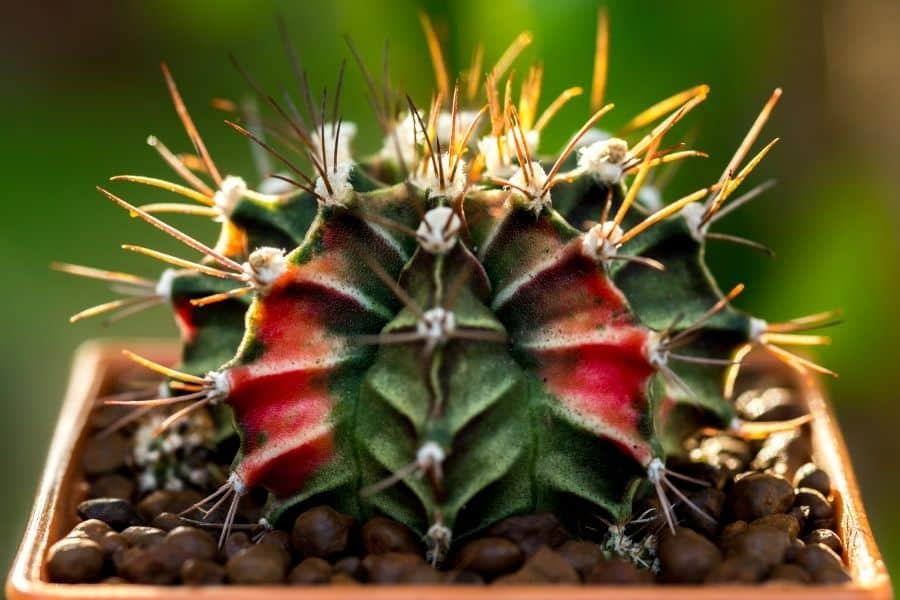
Related Post:
1000 Types of Cacti With Pictures
Contents
- 1 Types of Gymnocalycium Cacti
- 1.1 Gymnocalycium ambatoense
- 1.2 Gymnocalycium amerhauseri
- 1.3 Gymnocalycium amerhauseri subsp altagraciense
- 1.4 Gymnocalycium andreae
- 1.5 Gymnocalycium andreae subsp carolinense
- 1.6 Gymnocalycium anisitsii
- 1.7 Gymnocalycium anisitsii subsp damsii
- 1.8 Gymnocalycium anisitsii var tucavocense
- 1.9 Gymnocalycium baldianum
- 1.10 Gymnocalycium bayrianum
- 1.11 Gymnocalycium berchtii
- 1.12 Gymnocalycium bodenbenderianum
- 1.13 Gymnocalycium bodenbenderianum subsp intertextum
- 1.14 Gymnocalycium bruchii
- 1.15 Gymnocalycium bruchii var hossei
- 1.16 Gymnocalycium bruchii var niveum
- 1.17 Gymnocalycium calochlorum
- 1.18 Gymnocalycium capillaense
- 1.19 Gymnocalycium castellanosii
- 1.20 Gymnocalycium castellanosii subsp bozsingianum
- 1.21 Gymnocalycium catamarcense
- 1.22 Gymnocalycium chacoense
- 1.23 Gymnocalycium chiquitanum
- 1.24 Gymnocalycium curvispinum
- 1.25 Gymnocalycium damsii var rotundulum
- 1.26 Gymnocalycium deeszianum
- 1.27 Gymnocalycium denudatum var Jan Suba
- 1.28 Gymnocalycium denudatum
- 1.29 Gymnocalycium erinaceum
- 1.30 Gymnocalycium esperanzae
- 1.31 Gymnocalycium eurypleurum
- 1.32 Gymnocalycium friedrichii
- 1.33 Gymnocalycium friedrichii var moserianum
- 1.34 Gymnocalycium gibbosum
- 1.35 Gymnocalycium gibbosum var brachypetalum
- 1.36 Gymnocalycium gibbosum var chubutense
- 1.37 Gymnocalycium hamatum
- 1.38 Gymnocalycium horstii
- 1.39 Gymnocalycium horstii subsp buenekeri
- 1.40 Gymnocalycium hyptiacanthum subsp uruguayense
- 1.41 Gymnocalycium intermedium
- 1.42 Gymnocalycium marquezii
- 1.43 Gymnocalycium marsoneri
- 1.44 Gymnocalycium marsoneri subsp matoense
- 1.45 Gymnocalycium mazanense
- 1.46 Gymnocalycium mazanense var ferox
- 1.47 Gymnocalycium megalothelon
- 1.48 Gymnocalycium mesopotamicum
- 1.49 Gymnocalycium mihanovichii
- 1.50 Gymnocalycium mihanovichii var filadelfiense
- 1.51 Gymnocalycium mihanovichii var stenogonum
- 1.52 Gymnocalycium mihanovichii cv Hibotan
- 1.53 Gymnocalycium monvillei
- 1.54 Gymnocalycium monvillei subsp achirasense
- 1.55 Gymnocalycium monvillei subsp horridispinum
- 1.56 Gymnocalycium monvillei var steineri
- 1.57 Gymnocalycium mostii
- 1.58 Gymnocalycium mostii subsp valnicekianum
- 1.59 Gymnocalycium multiflorum
- 1.60 Gymnocalycium neuhuberi
- 1.61 Gymnocalycium ochoterenae
- 1.62 Gymnocalycium ochoterenae subsp vatteri
- 1.63 Gymnocalycium oenanthemum
- 1.64 Gymnocalycium paediophilum
- 1.65 Gymnocalycium paraguayense
- 1.66 Gymnocalycium paraguayense f fleischerianum
- 1.67 Gymnocalycium pflanzii
- 1.68 Gymnocalycium pflanzii var albipulpa
- 1.69 Gymnocalycium pflanzii var riograndense
- 1.70 Gymnocalycium quehlianum
- 1.71 Gymnocalycium ragonesei
- 1.72 Gymnocalycium reductum
- 1.73 Gymnocalycium reductum var leeanum
- 1.74 Gymnocalycium riojense
- 1.75 Gymnocalycium ritterianum
- 1.76 Gymnocalycium robustum
- 1.77 Gymnocalycium saglionis
- 1.78 Gymnocalycium saglionis subsp tilcarense
- 1.79 Gymnocalycium schickendantzii
- 1.80 Gymnocalycium schickendantzii subsp delaetii
- 1.81 Gymnocalycium schroederianum
- 1.82 Gymnocalycium spegazzinii
- 1.83 Gymnocalycium spegazzinii subsp cardenasianum
- 1.84 Gymnocalycium spegazzinii var punillense
- 1.85 Gymnocalycium spegazzinii subsp sarkae
- 1.86 Gymnocalycium stellatum
- 1.87 Gymnocalycium stellatum subsp occultum
- 1.88 Gymnocalycium stellatum var paucispinum
- 1.89 Gymnocalycium stenopleurum
- 1.90 Gymnocalycium sutterianum
- 1.91 Gymnocalycium striglianum
- 1.92 Gymnocalycium taningaense
- 1.93 Gymnocalycium tillianum
- 1.94 Gymnocalycium triacanthum
- 1.95 Gymnocalycium weissianum
- 2 How to Grow and Care for Gymnocalycium
- 3 How to Propagate Gymnocalycium
- 4 FAQs
Types of Gymnocalycium Cacti
Let’s take a closer look at some fascinating Gymnocalycium cacti species:
Gymnocalycium ambatoense
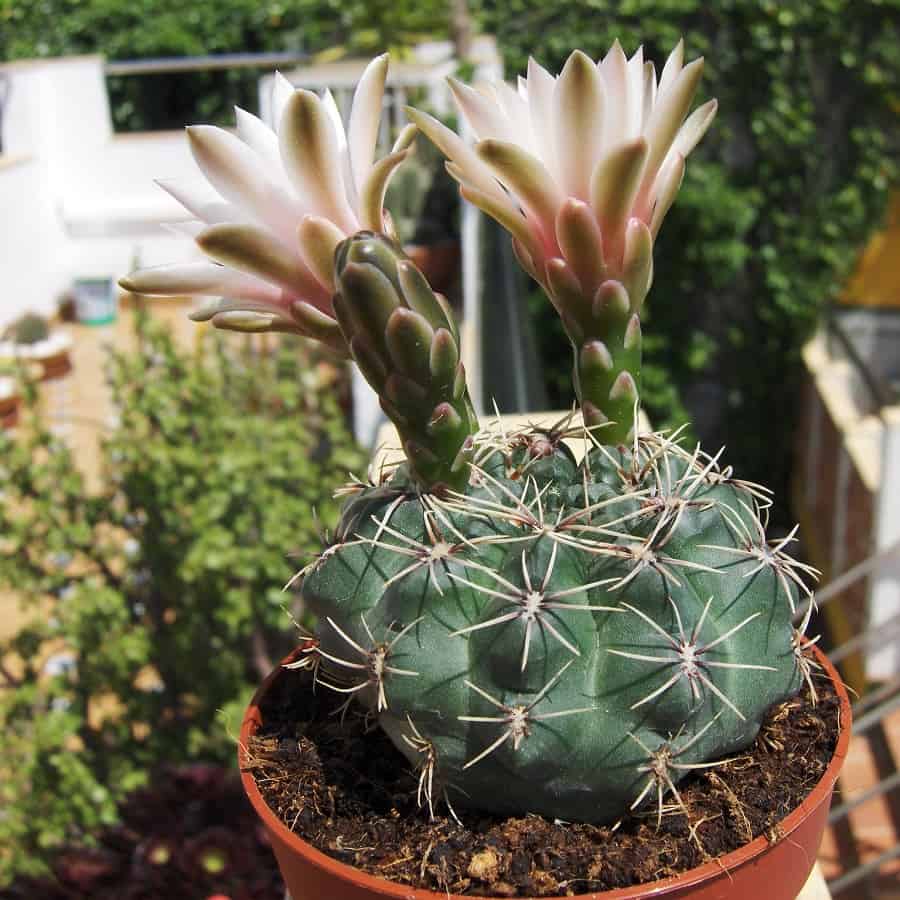
This cactus species has dense spines and grows individually at an altitude of 2,950-3,610 feet on the Sierra Ambato. It is considered a transitional form between the strongly spined Gymnocalycium oenanthemum and the widespread Gymnocalycium hossei.
Gymnocalycium amerhauseri
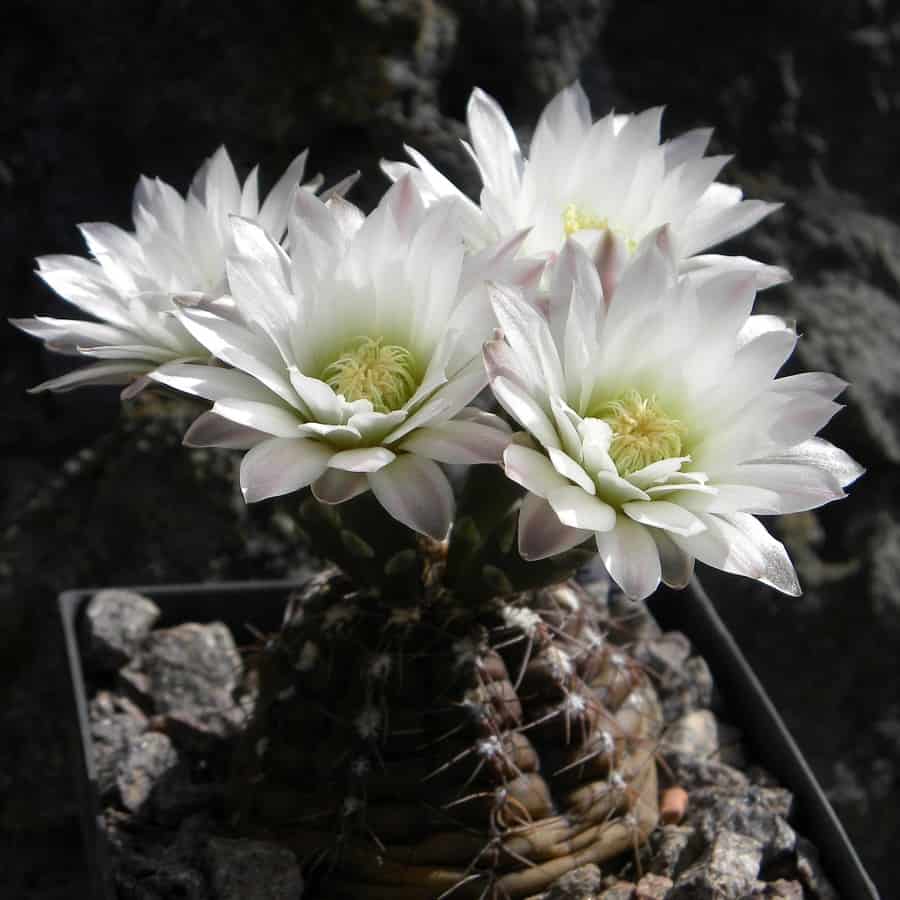
This small, flattened cactus has dark green bodies with short spines arranged in spider-like clusters. There are two recognized subspecies, the nominate form and Gymnocalycium amerhauseri subsp. altagraciense, although the latter is considered a synonym.
Gymnocalycium amerhauseri subsp altagraciense
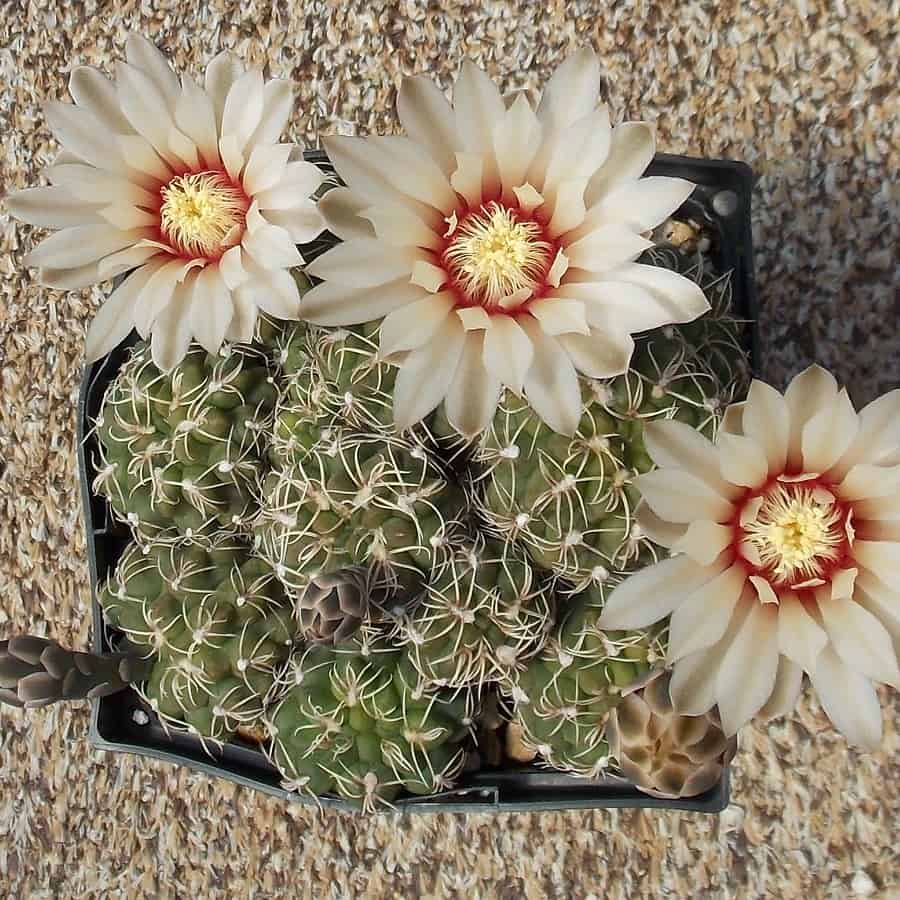
Gymnocalycium andreae
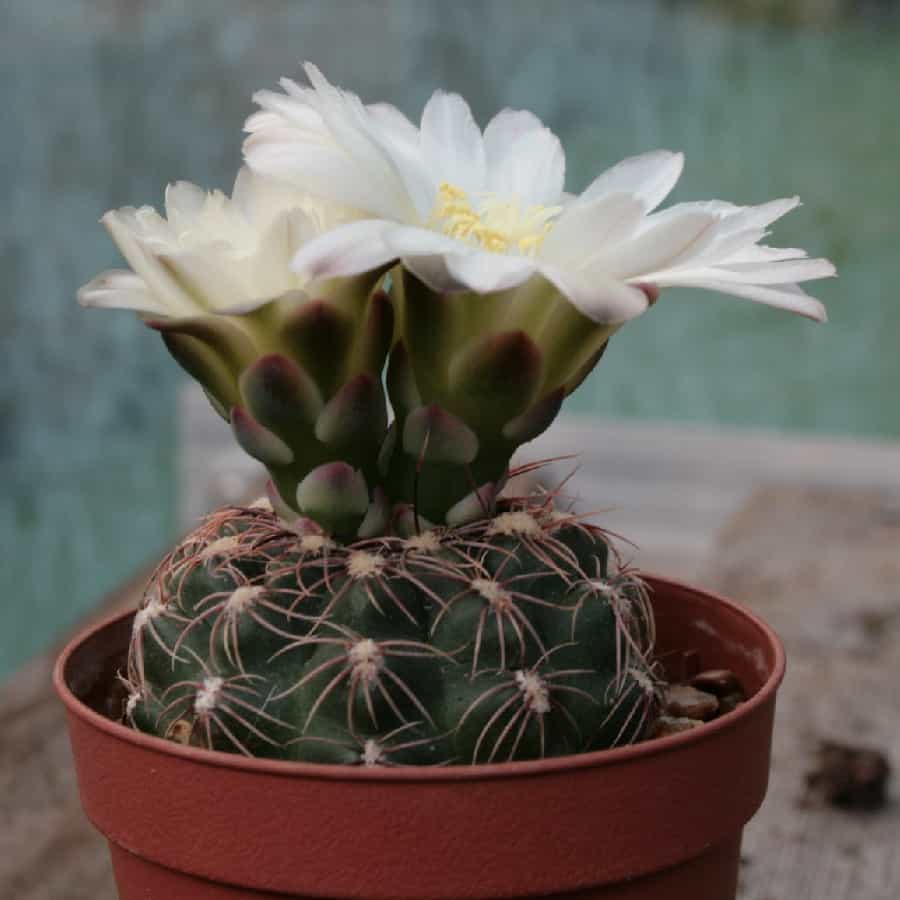
This low-growing prickly cactus is mostly solitary but can form clusters in cultivation. What sets it apart is the brilliant sulfur-yellow color of its flowers, which is different from most other Gymnocalycium species.
Gymnocalycium andreae subsp carolinense
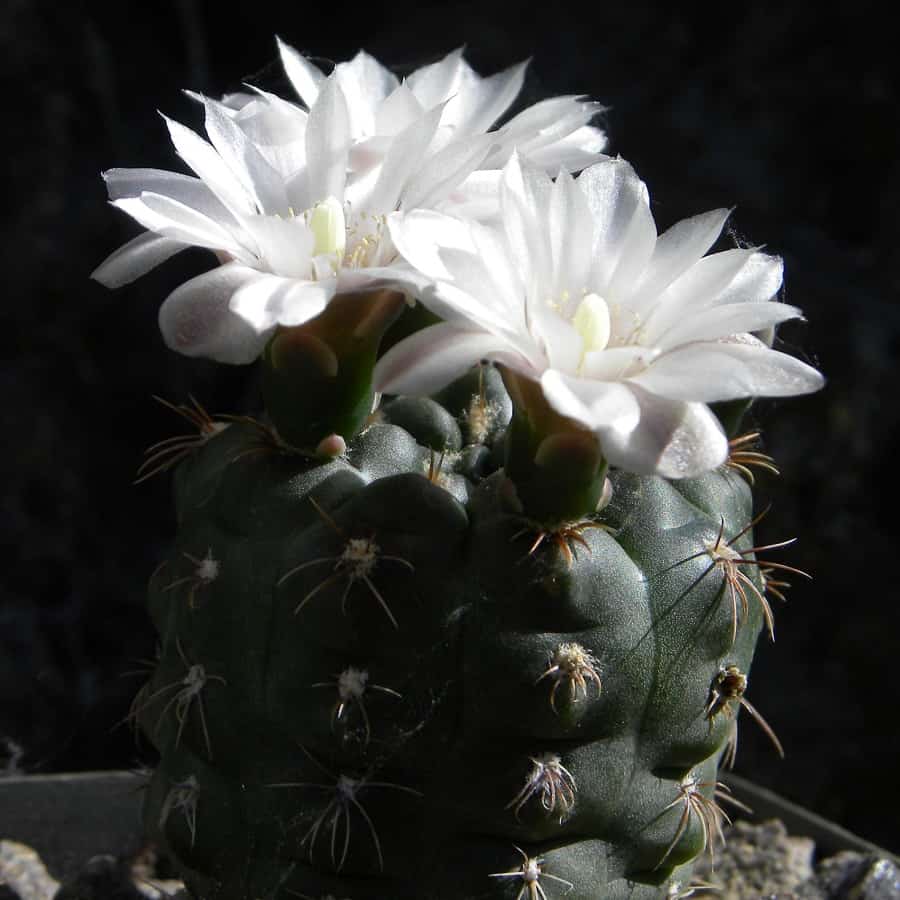
This variation of Gymnocalycium andreae showcases an unusual color compared to the typical yellow-flowered species found in the San Luis province of Argentina. Discovered in 1988 by Gert Neuhuber, it was initially described as a subspecies (G. andreae ssp. carolinense) and later elevated to species rank in 2005 (Gymnocalycium carolinense). It shares some traits with Gymnocalycium bruchii and has been considered a subspecies of G. bruchii by Hunt et al. It can be distinguished from G. bruchii by its solitary stem, more spaced areoles, and prominent “chins”. Notably, Bercht considers it closely related to Gymnocalycium bruchii v. brigittae.
Gymnocalycium anisitsii
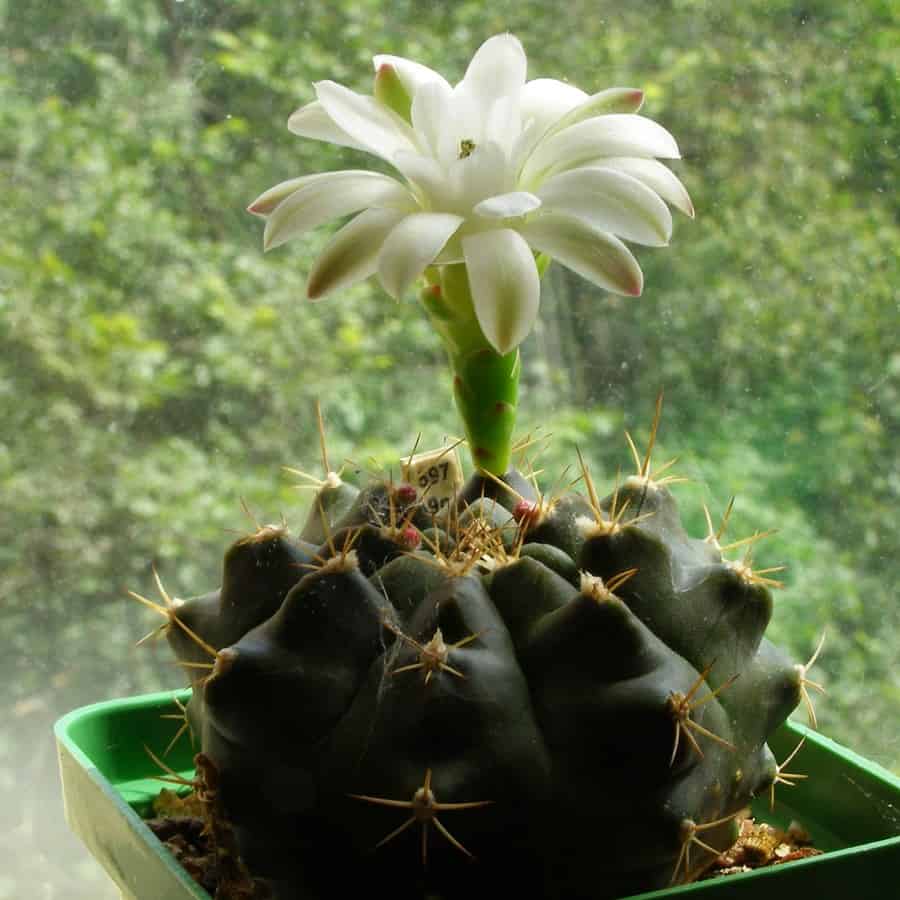
Known for its easy cultivation and abundance of flowers, this cactus can be solitary or form offsets. It has 5 to 7 tortuous spines and comes in various flower colors, including white and pink. It is a highly variable species with two recognized subspecies, the nominate form and subsp. multiproliferum.
Gymnocalycium anisitsii subsp damsii
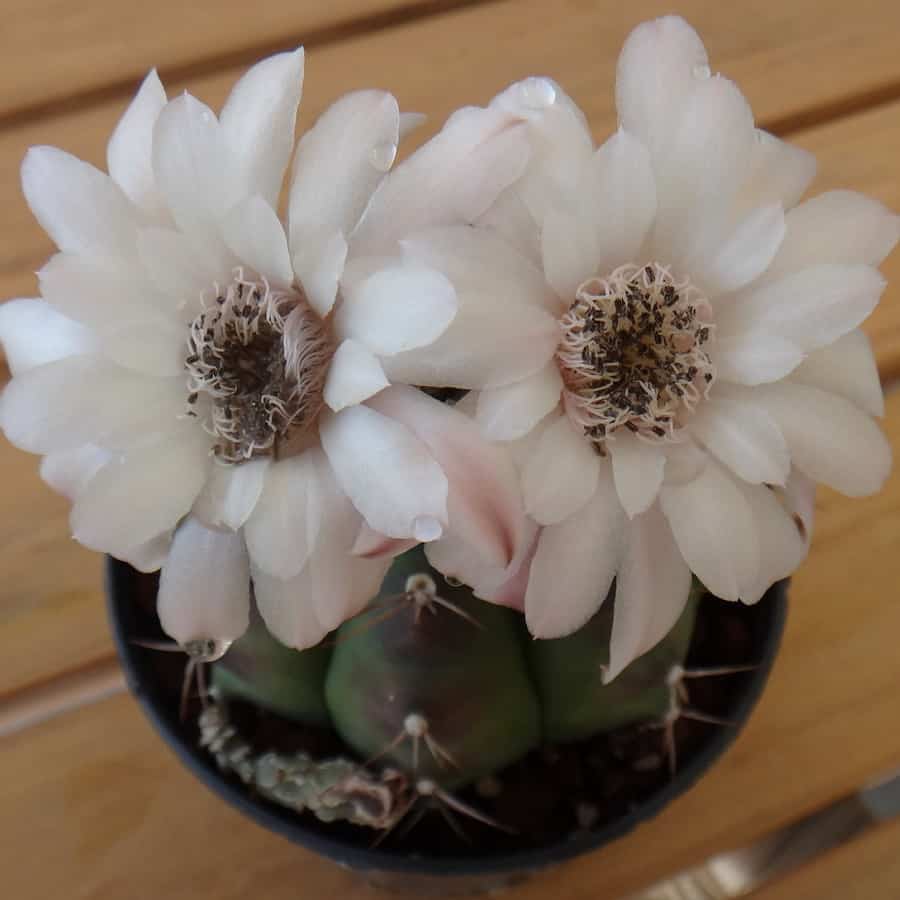
This plump species can be solitary or offsetting, and its flower color varies from white to pale pink or reddish-violet. It has shorter spines and takes on a deep brown color when dormant, while new growth appears as deep green. It often blooms during the Christmas period in Europe.
Gymnocalycium anisitsii var tucavocense
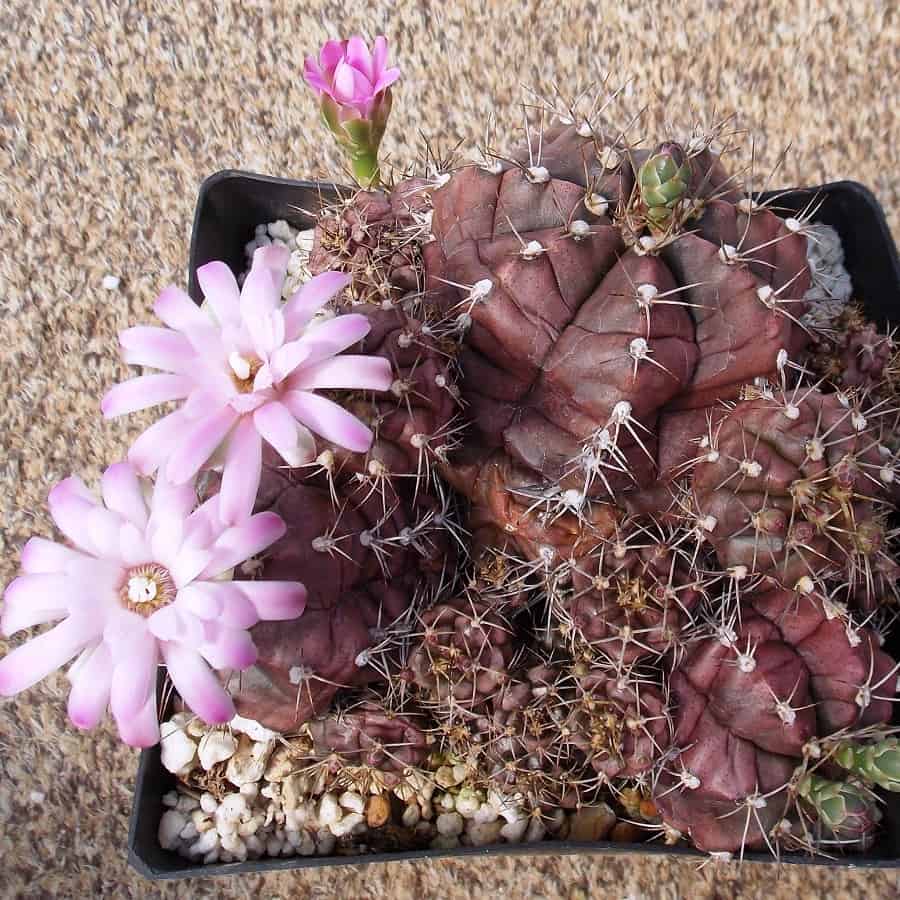
This beautiful species stands out with its lilac-colored flowers and flattened, multicolored stems. It branches prolifically and starts flowering at a very young age, sometimes even when the plant is just 0.6 inches in diameter.
Gymnocalycium baldianum
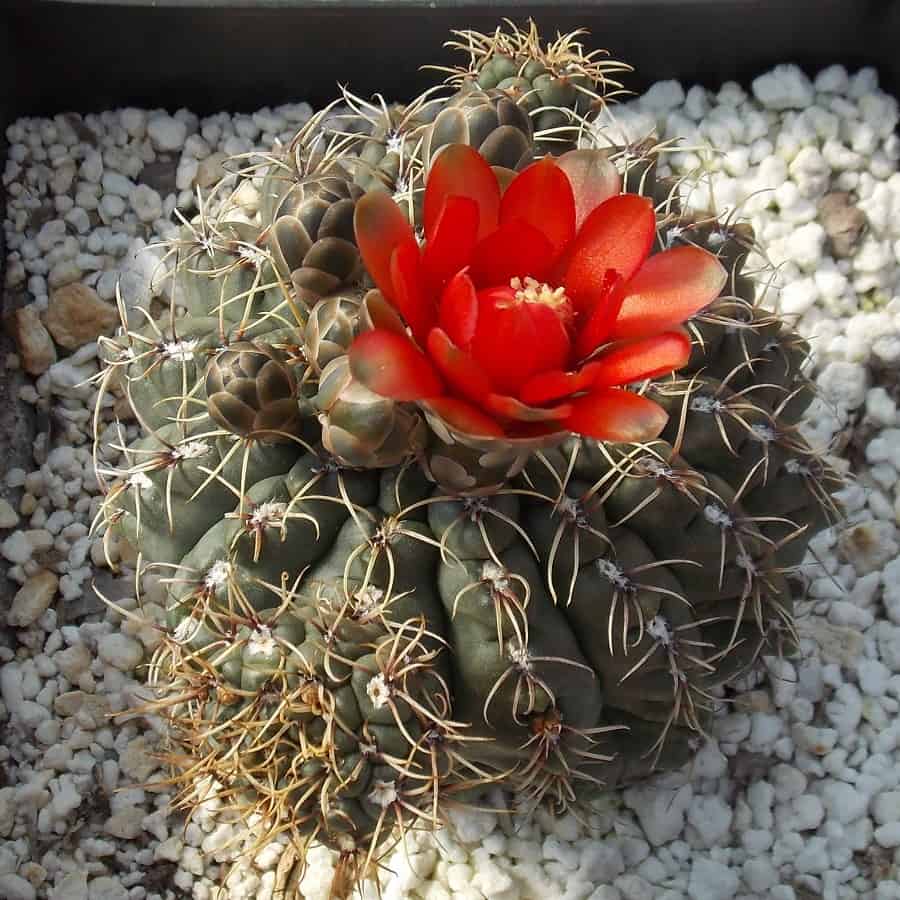
This small variety usually grows without branches, making it a compact and charming cactus.
Gymnocalycium bayrianum
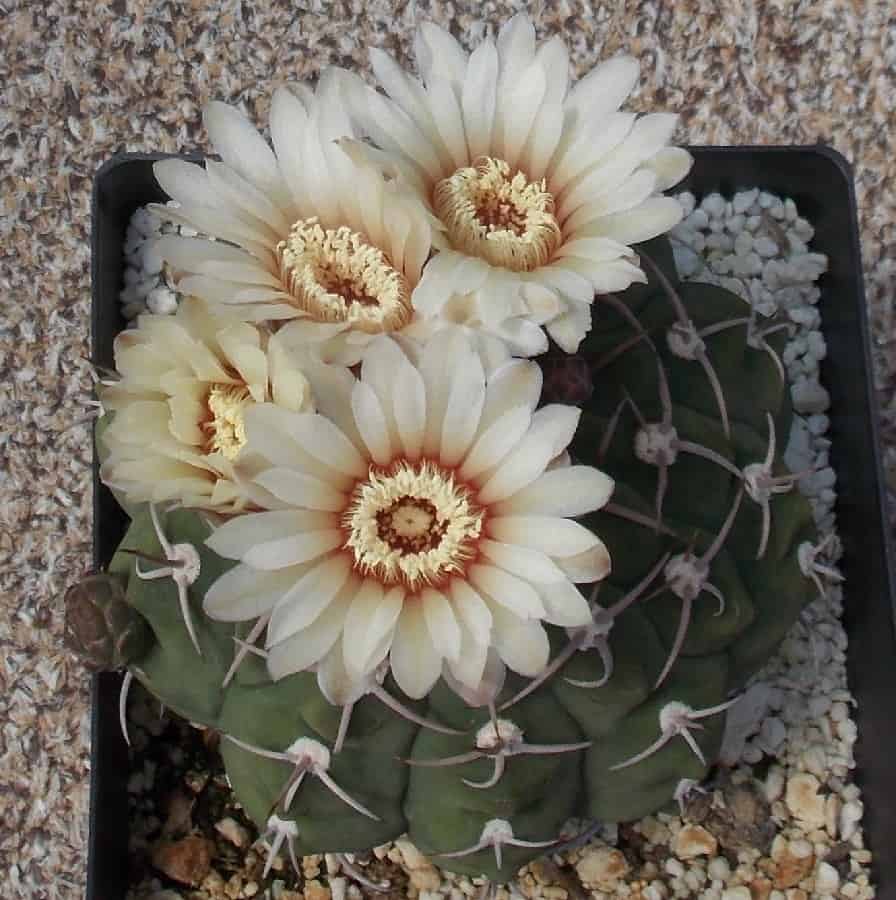
The standout feature of this species is its spines, which curl strongly and resemble pairs of buffalo horns. It is renowned for having some of the best spines among Gymnocalycium cacti.
Gymnocalycium berchtii
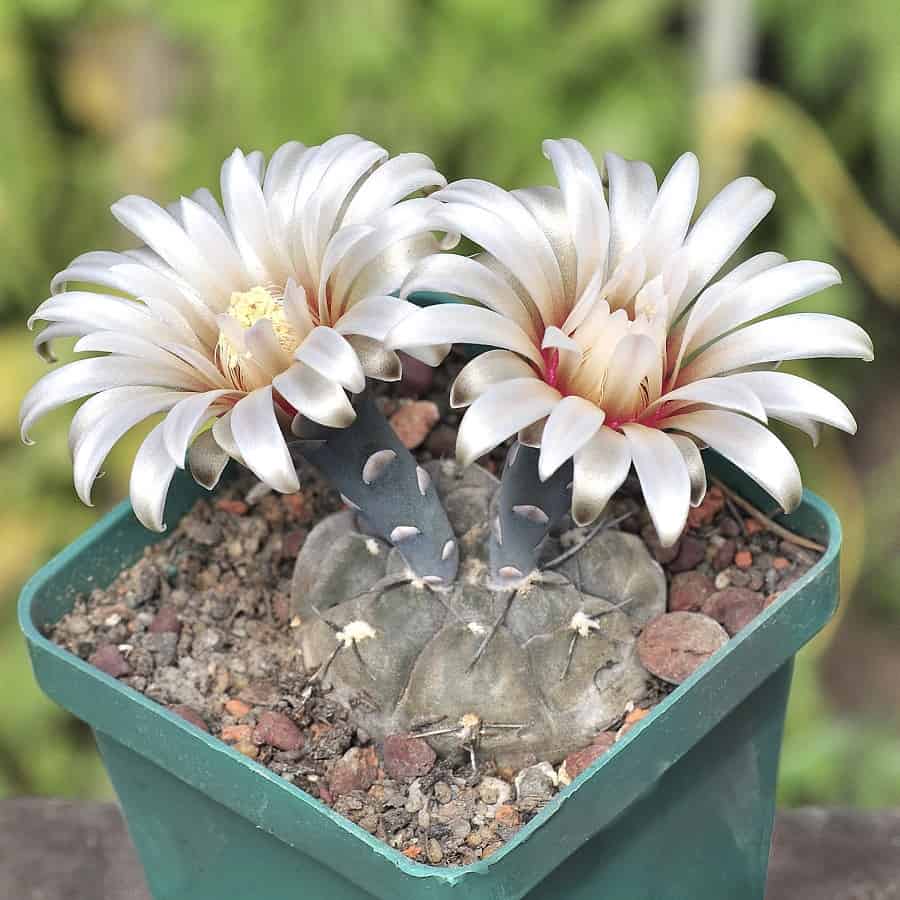
This tiny geophyte has a solitary flattened stem that slowly grows on a thick underground taproot. It is not commonly found in collections, possibly due to its dark and unattractive body color, slow growth (especially underground), and its potential difficulty in adapting to cultivation.
Gymnocalycium bodenbenderianum
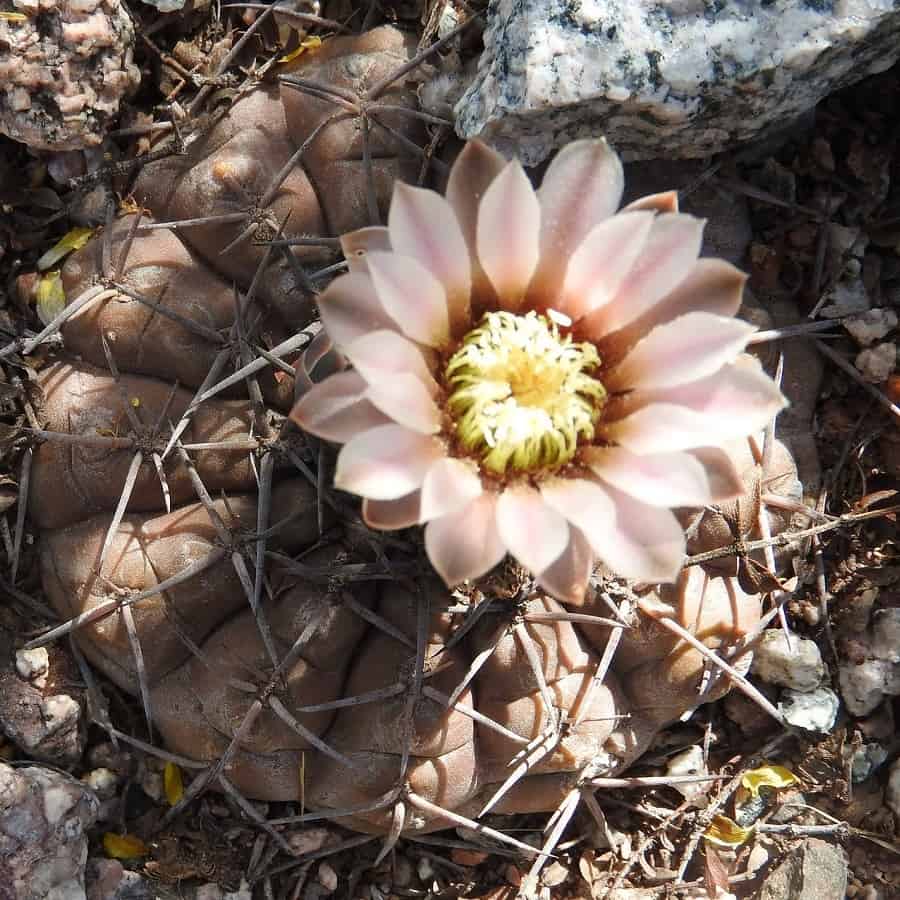
Gymnocalycium bodenbenderianum is a short cactus with brownish-green stems and white flowers that may have a pink flush. It is sometimes called “Chin-cactus” because it has a noticeable chin-like feature below the areoles.
Gymnocalycium bodenbenderianum subsp intertextum
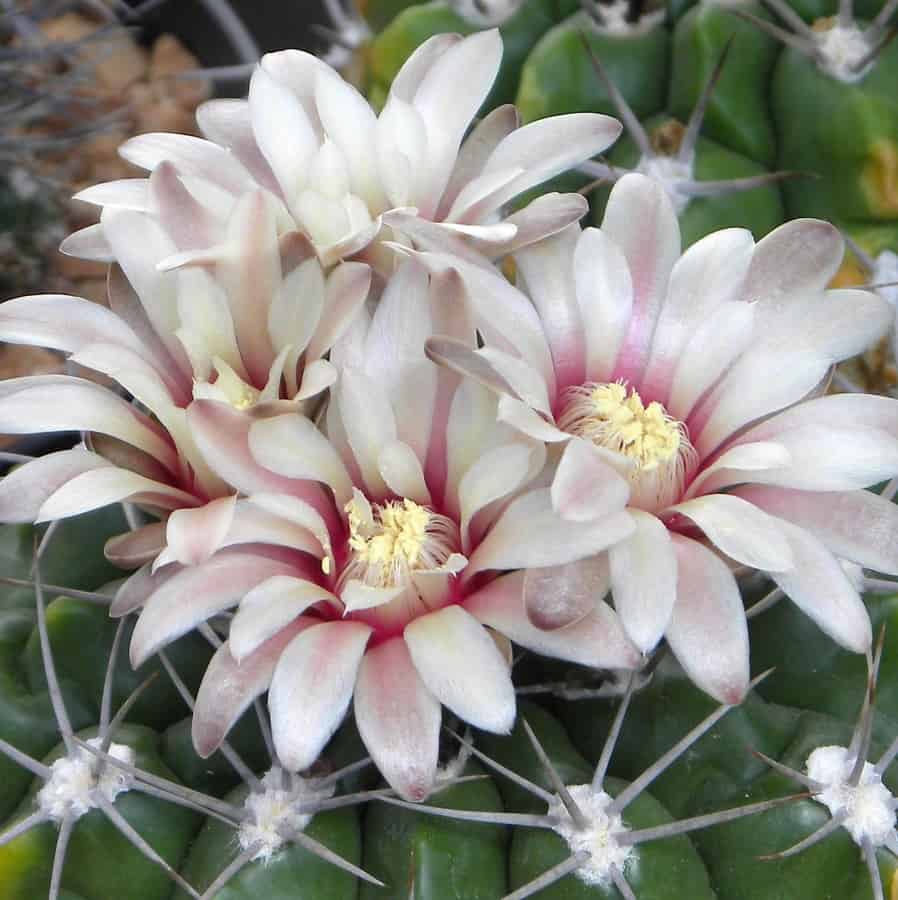
Gymnocalycium bodenbenderianum subsp intertextum is a type of this cactus with a flattened stem that has 13-15 ribs and rounded, pointed tubercles. It has 5-7 spines and is naturally found in northern Argentina.
Gymnocalycium bruchii
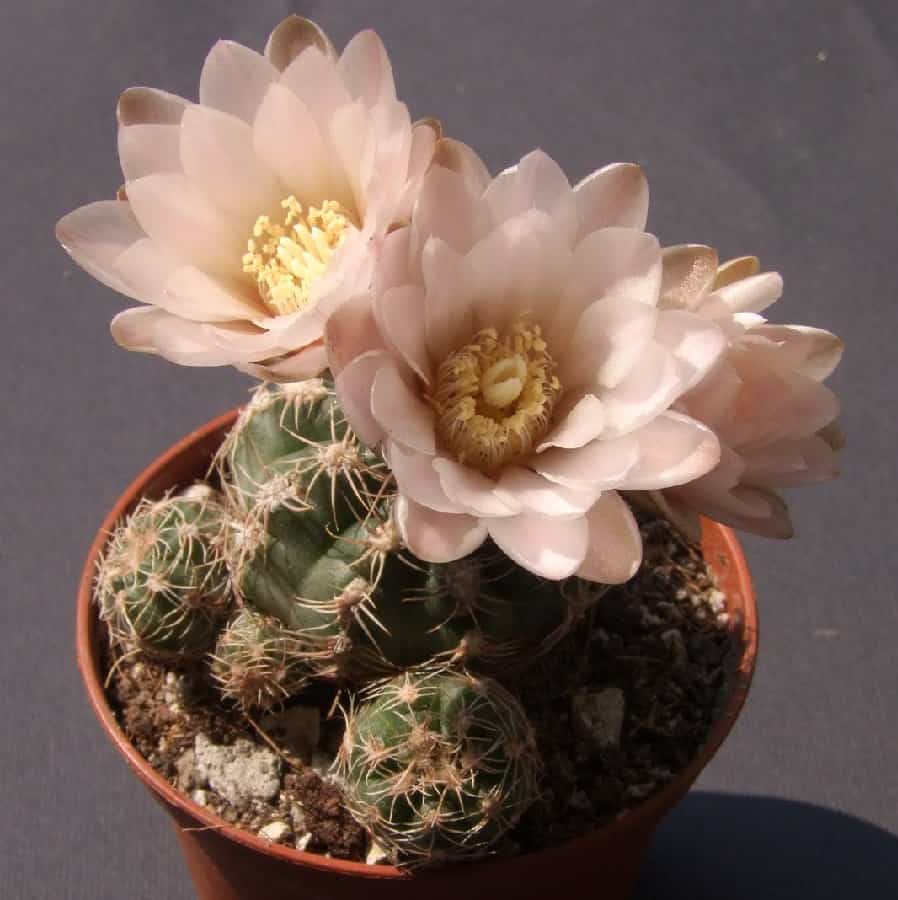
Gymnocalycium bruchii is a small succulent plant that forms clusters when it’s small. This species has many different variations and has been given many names.
Gymnocalycium bruchii var hossei
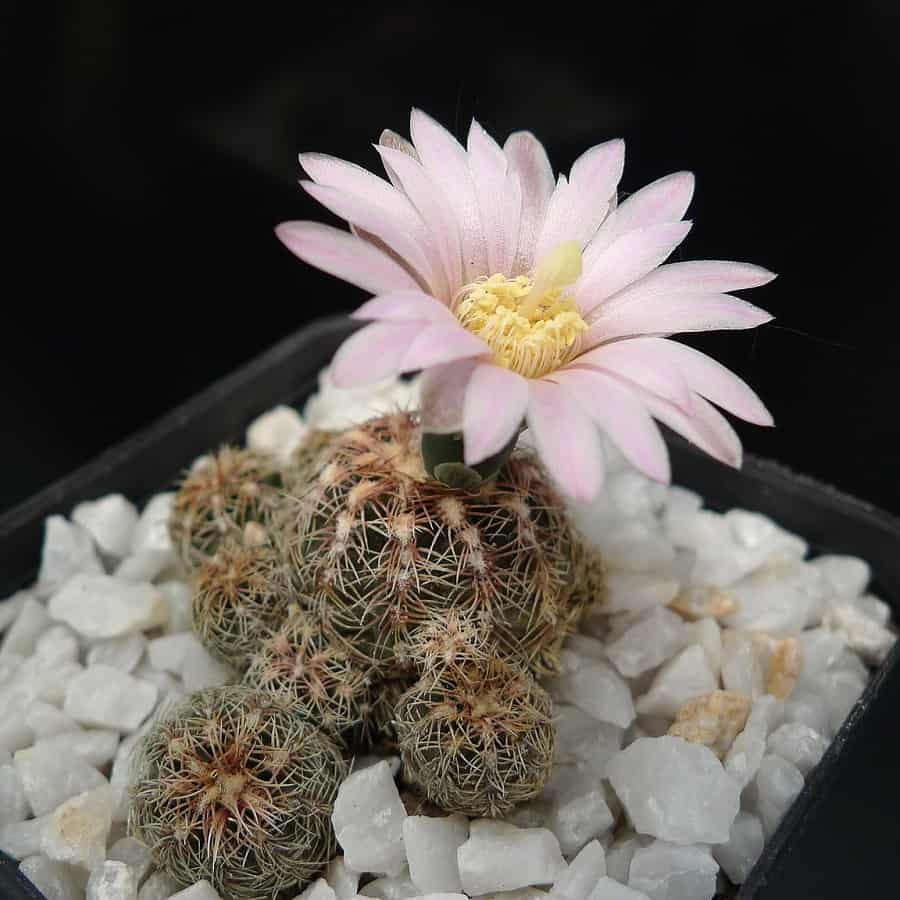
Gymnocalycium bruchii var hossei is a type of Gymnocalycium bruchii that looks very similar to the other varieties, but its spines are brownish. However, all the other characteristics, such as the size and shape of tubercles, spines, flowers, and fruits, show that it belongs to the same species.
Gymnocalycium bruchii var niveum
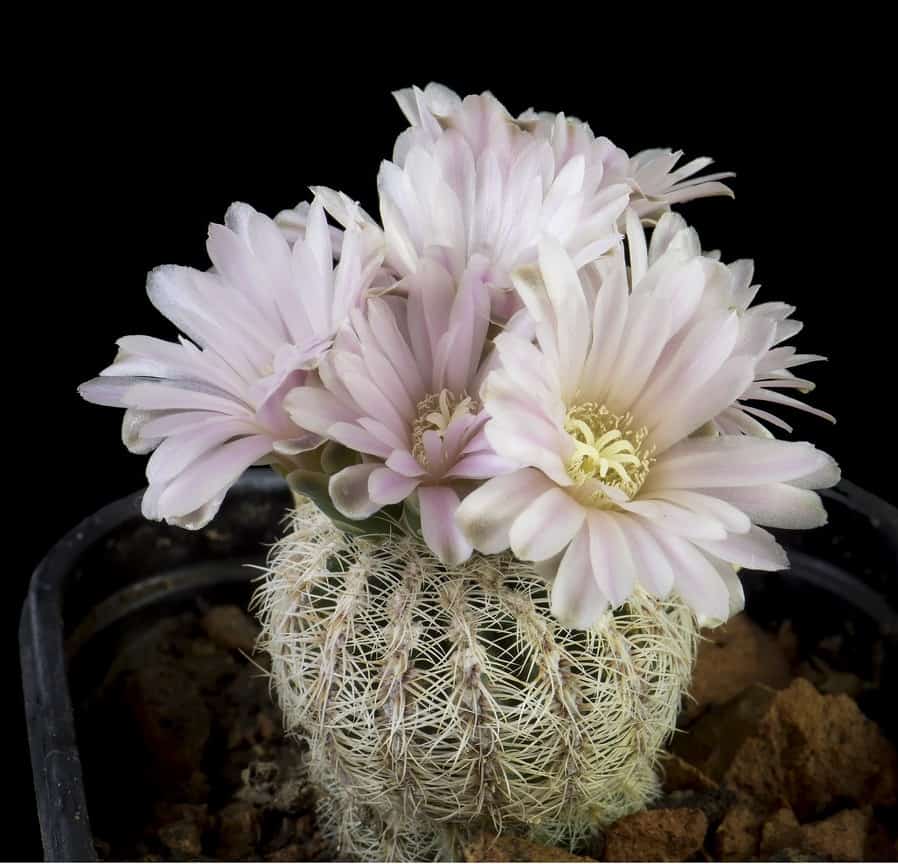
Gymnocalycium bruchii var niveum is another variation of Gymnocalycium bruchii. It is a small succulent plant that forms clusters when it’s small.
Gymnocalycium calochlorum
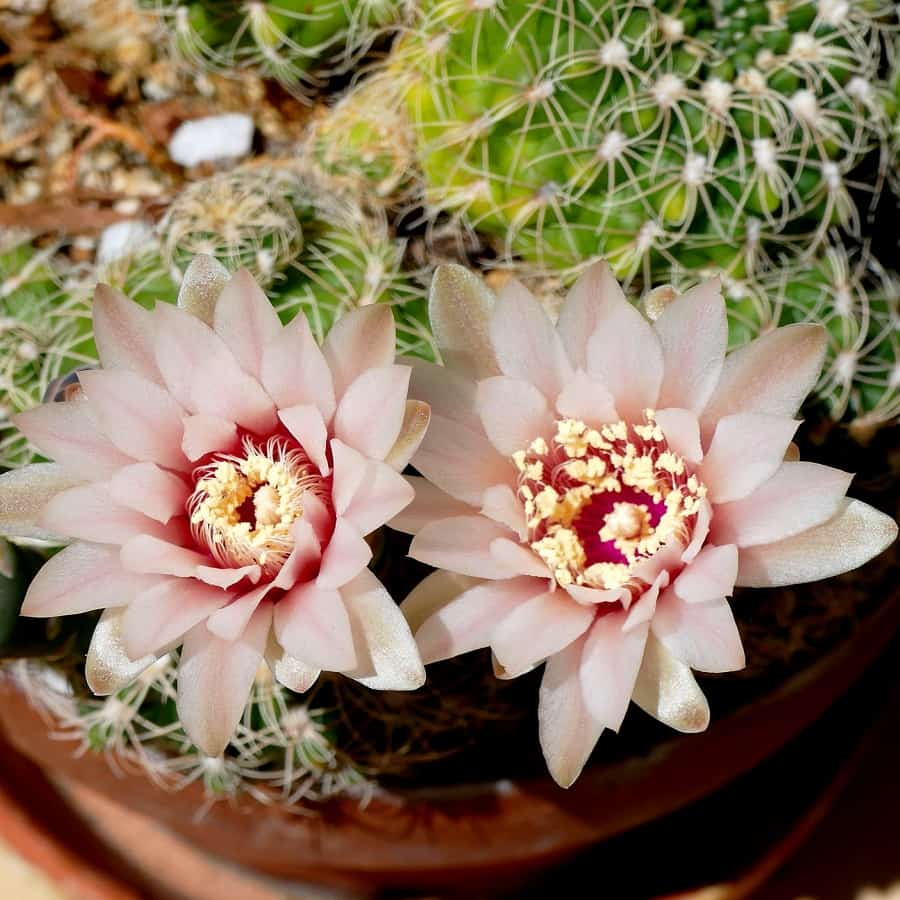
Gymnocalycium calochlorum, also known as the clustering chin cactus, is a small cactus that grows in flat clusters close to the ground. It has thin spines that are mostly pinkish brown. The trumpet-shaped flowers of this cactus are light pink and can be over 5 cm wide, but they don’t fully open.
Gymnocalycium capillaense
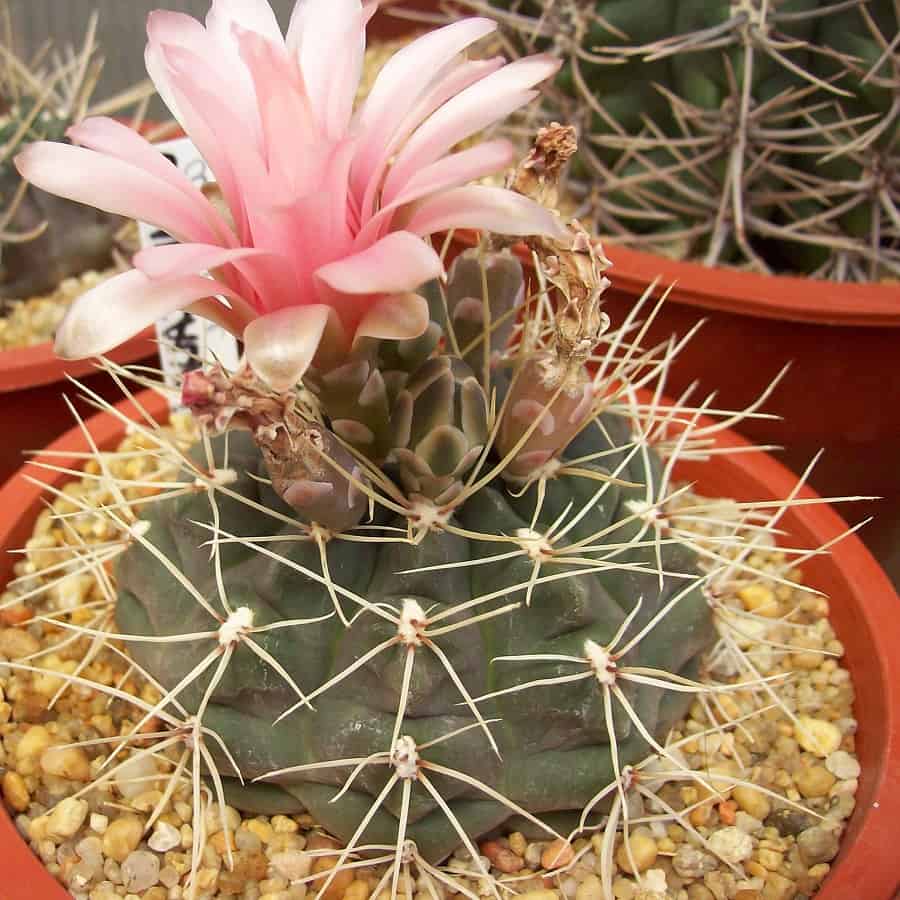
Gymnocalycium capillaense is a small cactus with weak spines. It stands out because it has relatively large flowers and forms many branches with multiple new stems. This plant is often confused with other cacti like Gymnocalycium siegelianum and Gymnocalycium sutterianum.
Gymnocalycium castellanosii
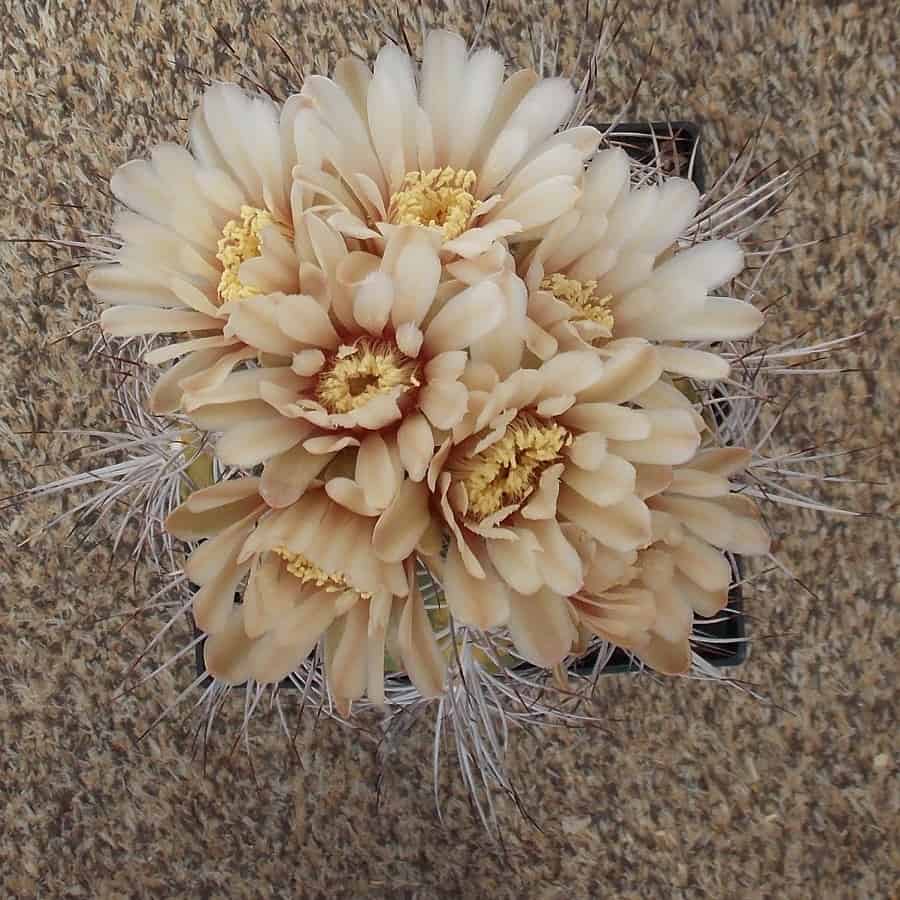
Gymnocalycium castellanosii is a single plant with thick spines that bend backward in a distinctive way.
Gymnocalycium castellanosii subsp bozsingianum
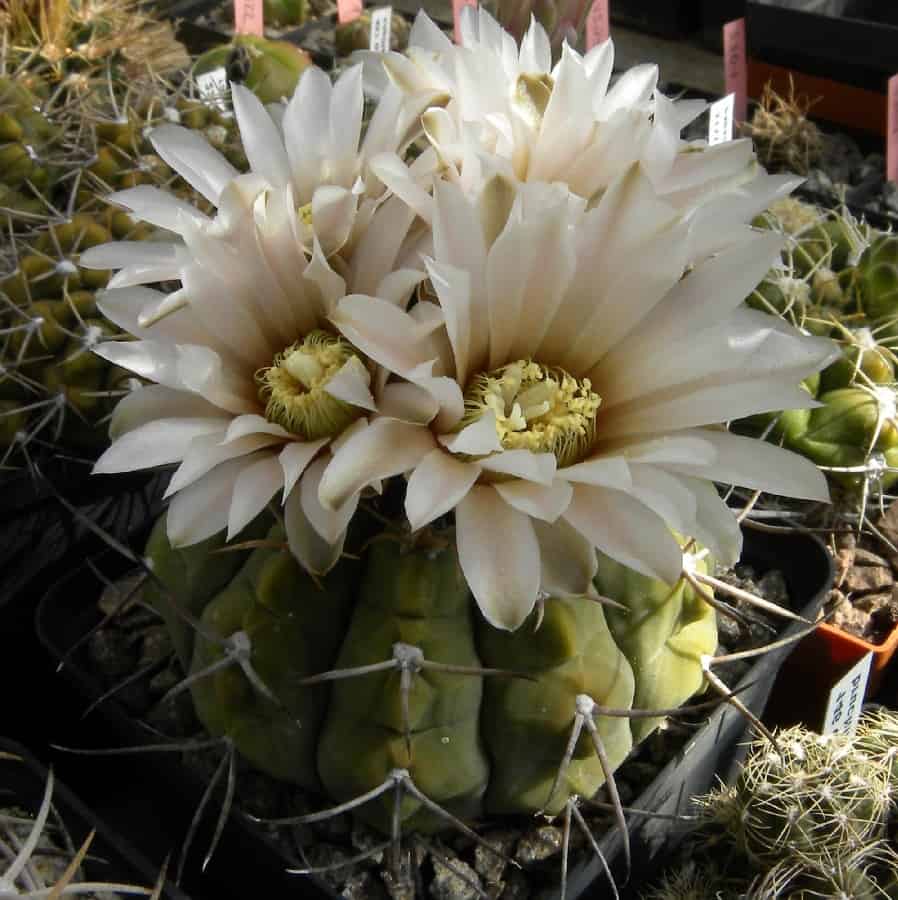
Gymnocalycium castellanosii subsp bozsingianum has a dull gray-green skin with rounded ribs and low tubercles. It usually has 5 needle-like spines that are mostly 3 to 20 mm long, and occasionally there is one central spine.
Gymnocalycium catamarcense
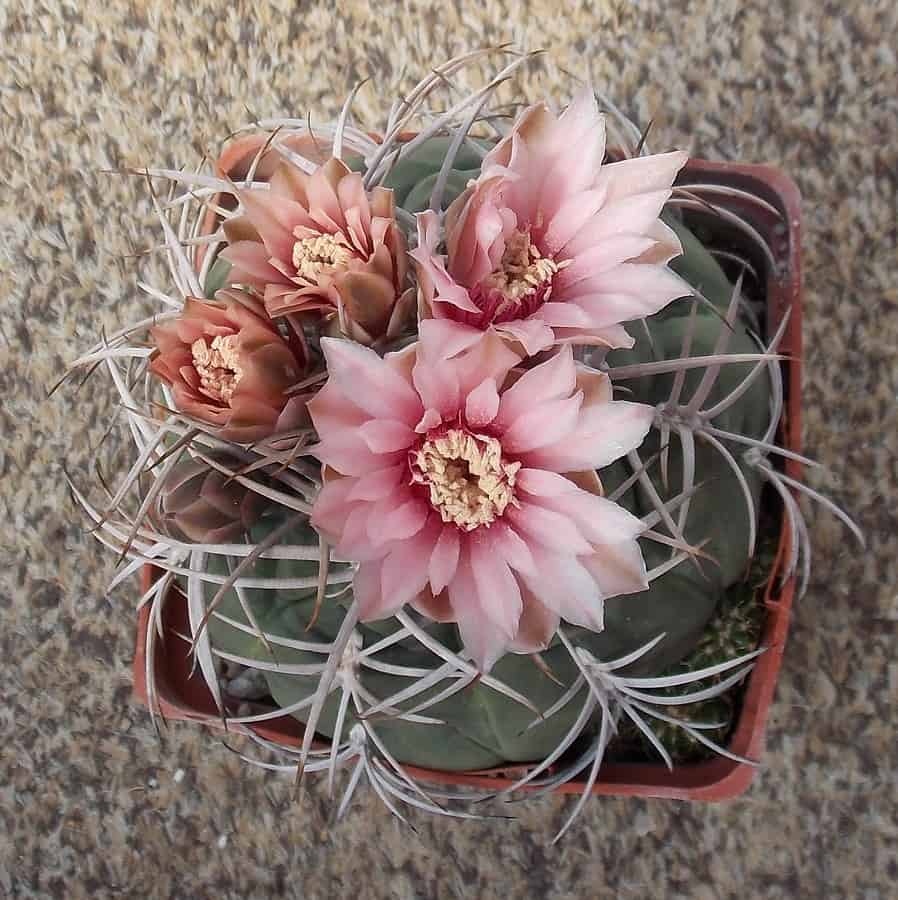
Gymnocalycium chacoense
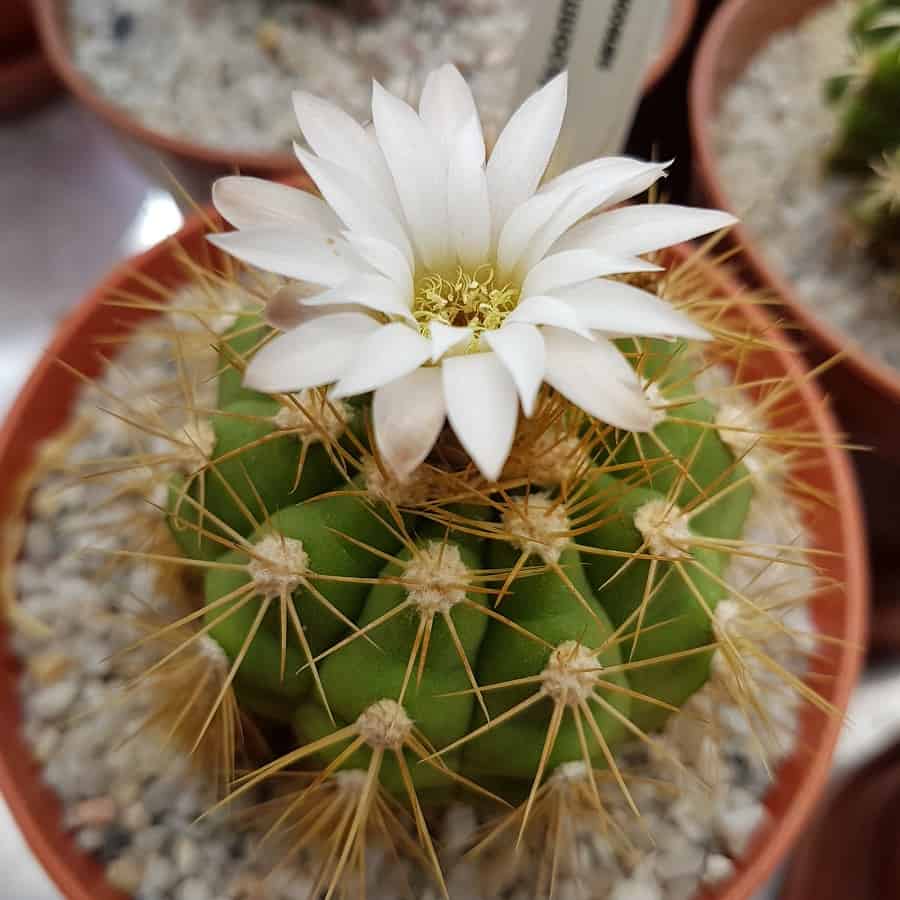
Gymnocalycium chacoense is a small cactus that grows in large groups with many pale-green stems, sometimes 25 to 50 heads. These plants produce many new stems. The population at the original location is very uniform because they propagate mainly vegetatively. This species is closely related to Gymnocalycium paediophilum but is considered a separate species by some experts. It has smaller flowers that start white and turn pink or red as they mature. The spines are finer, golden-yellow, denser, and give the plant a distinct appearance.
Gymnocalycium chiquitanum
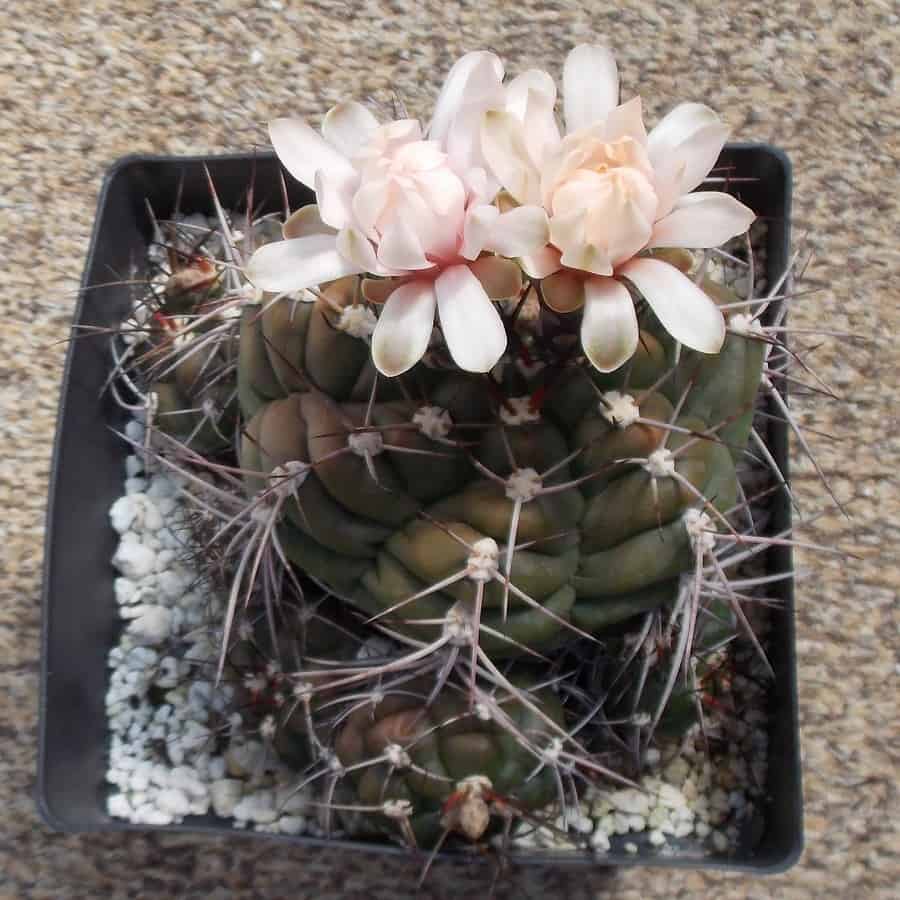
Gymnocalycium chiquitanum is a small cactus with spines that wrap around its body.
Gymnocalycium curvispinum
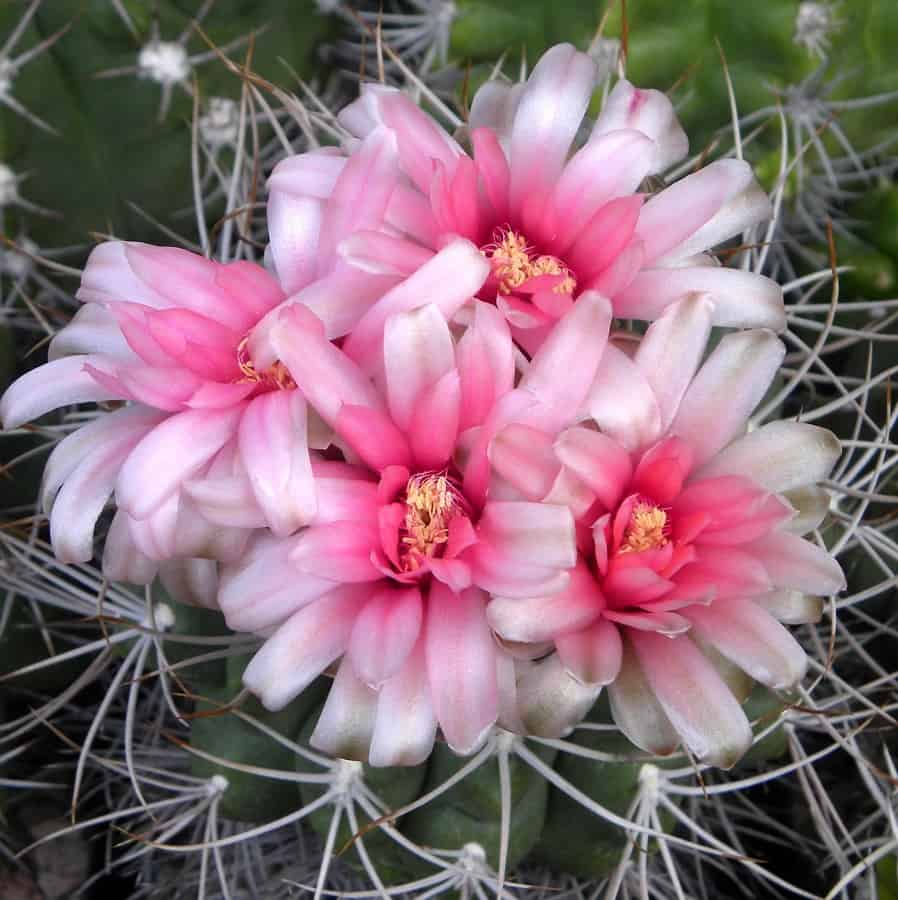
Gymnocalycium curvispinum is a type of Gymnocalycium hybopleurum that has strongly curved spines. There is still uncertainty about whether this variable group should be classified as one species or multiple species. Further studies are needed to determine the correct classification.
Gymnocalycium damsii var rotundulum
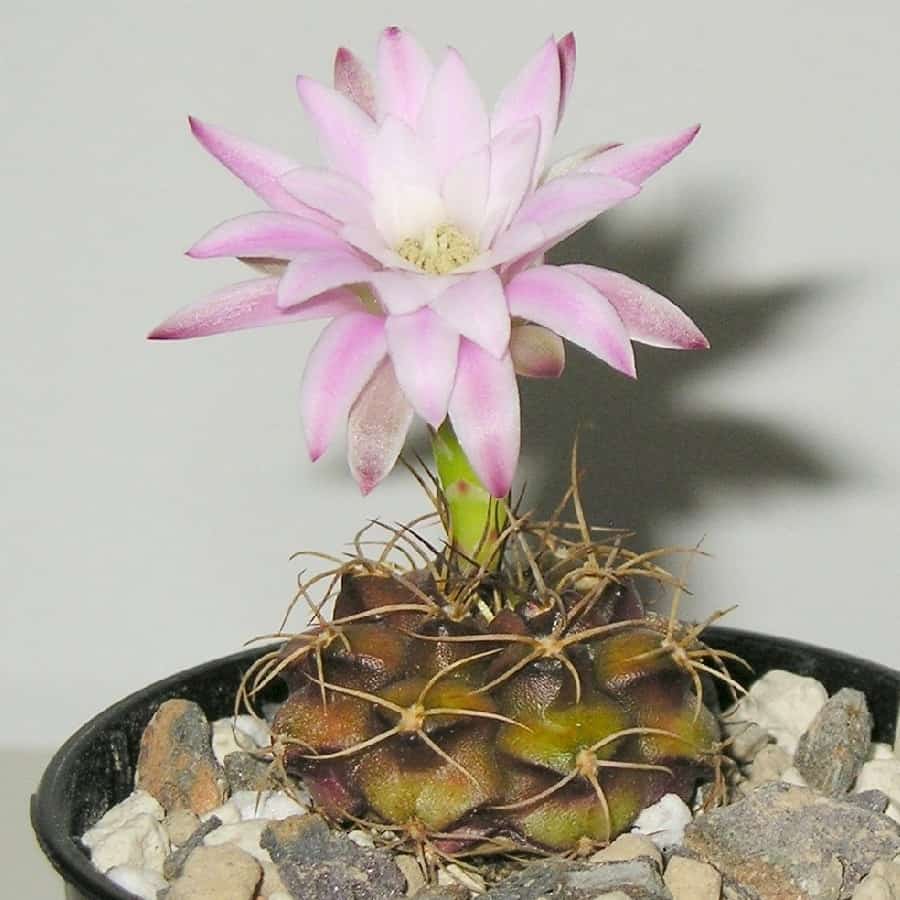
Gymnocalycium damsii var. rotundulum is a colorful cactus that usually grows alone and has rounder and lower tubercles. However, it is very similar, if not identical, to the standard Gymnocalycium damsii (also known as Gymnocalycium anisitsii).
Gymnocalycium deeszianum
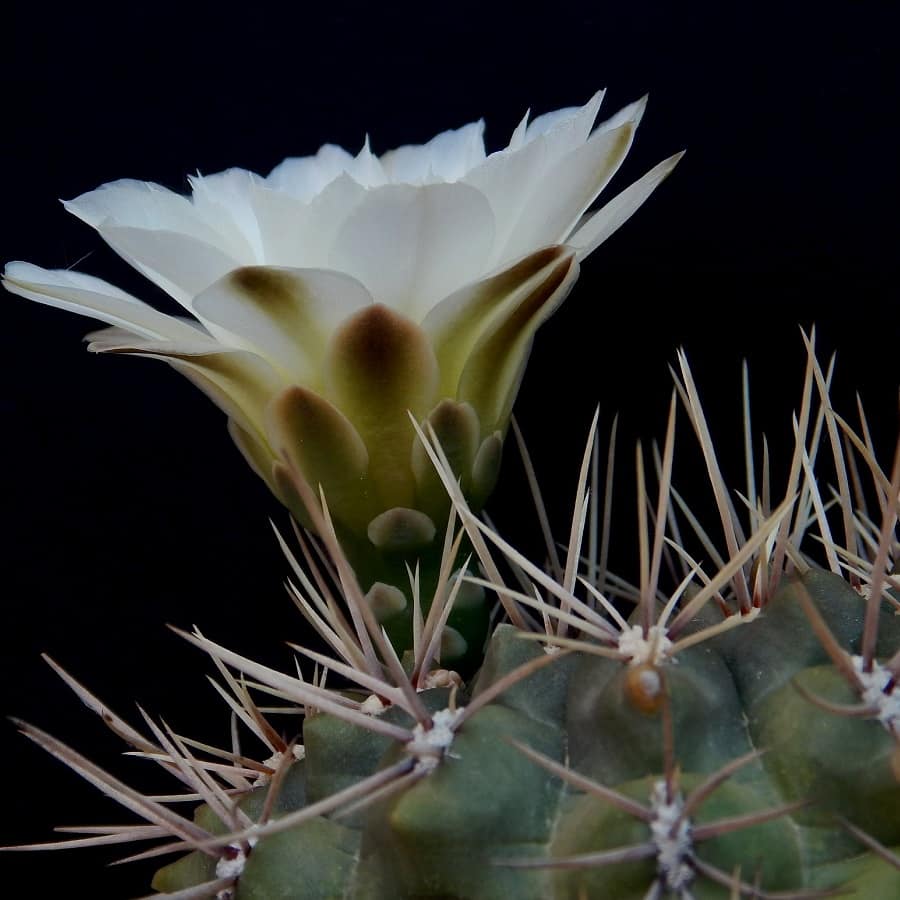
Gymnocalycium deeszianum is a small solitary cactus. It is a variable species, especially when cultivated. Some plants labeled as “deeszianum” can look very different, but they usually have a white bloom and rounded ribs.
Gymnocalycium denudatum var Jan Suba
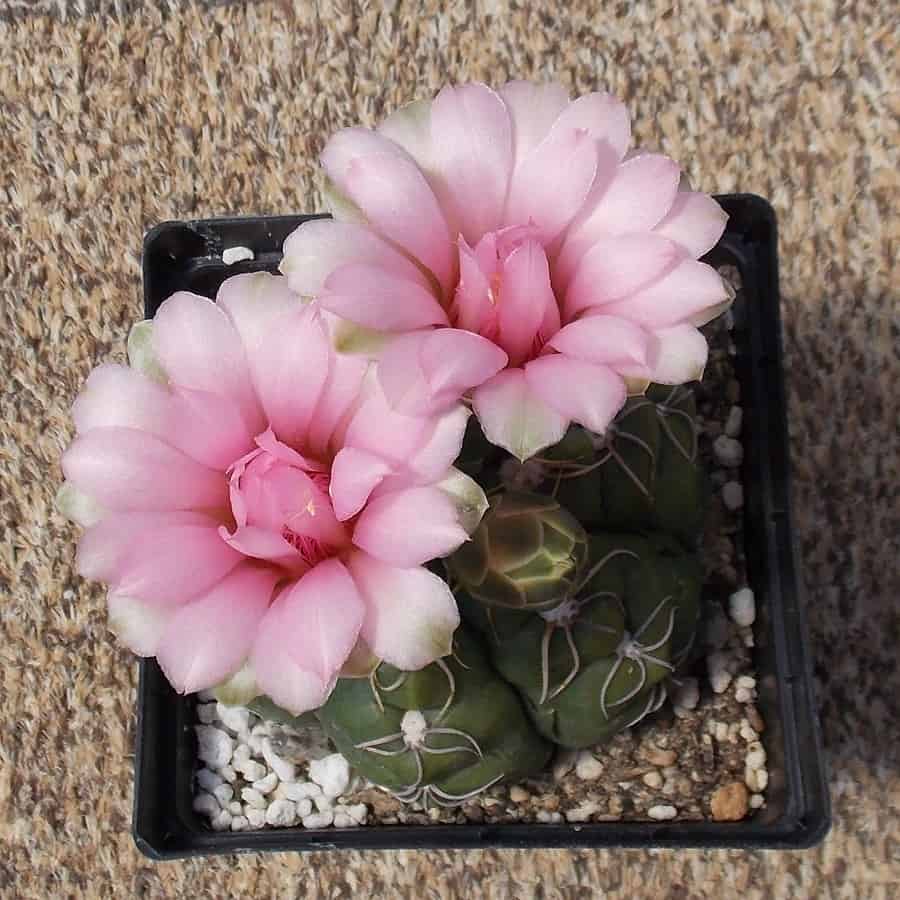
‘Jan Suba’ is said to be a hybrid between Gymnocalycium denudatum and Gymnocalycium baldianum (also known as Gymnocalycium venturianum). It inherits the stem and spination from the former and the beautiful red or deep pink flower color from the latter. However, the presence of pink-flowered forms of Gymnocalycium denudatum in their natural habitat is uncertain, so the existence of this hybrid is questionable.
Gymnocalycium denudatum
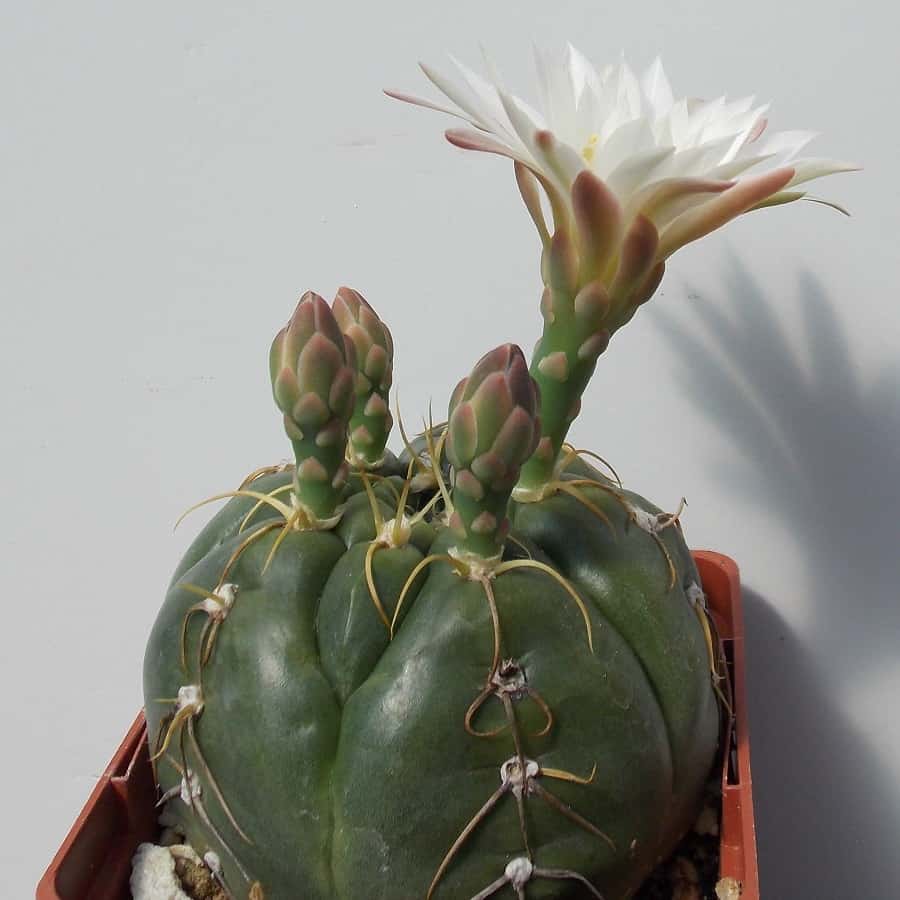
Gymnocalycium denudatum is a small, round cactus that usually doesn’t have branches. Its body is glossy and dark green, with rounded ribs. This species is highly variable.
Gymnocalycium erinaceum
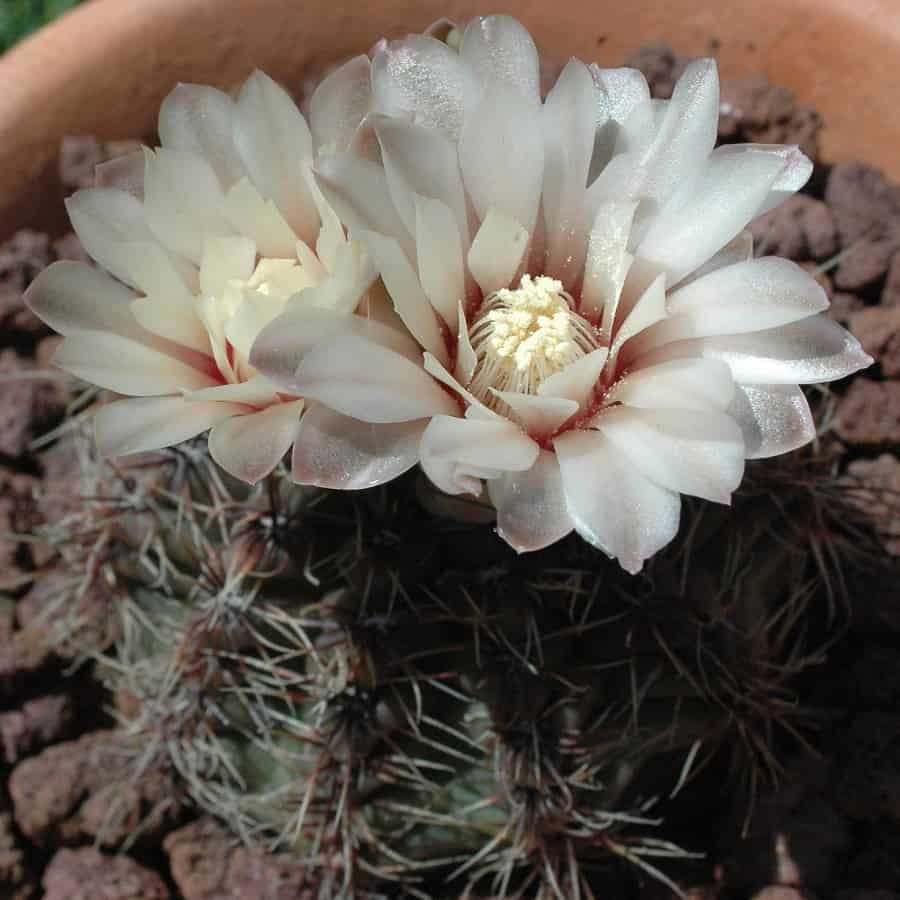
Gymnocalycium erinaceum is a small cactus that can have a solitary stem or cluster when it’s small. It grows slowly and can eventually form clusters up to 15 cm wide.
Gymnocalycium esperanzae
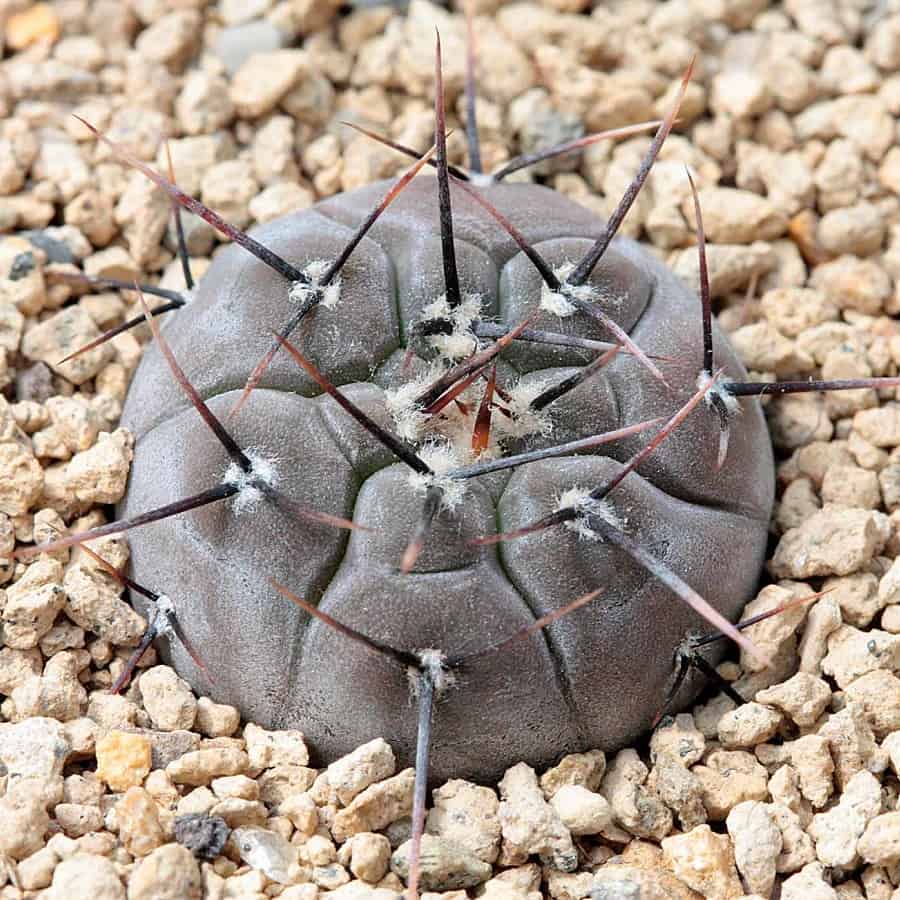
Gymnocalycium esperanzae is an attractive species with flat stems covered in a noticeable gray bloom.
Gymnocalycium eurypleurum
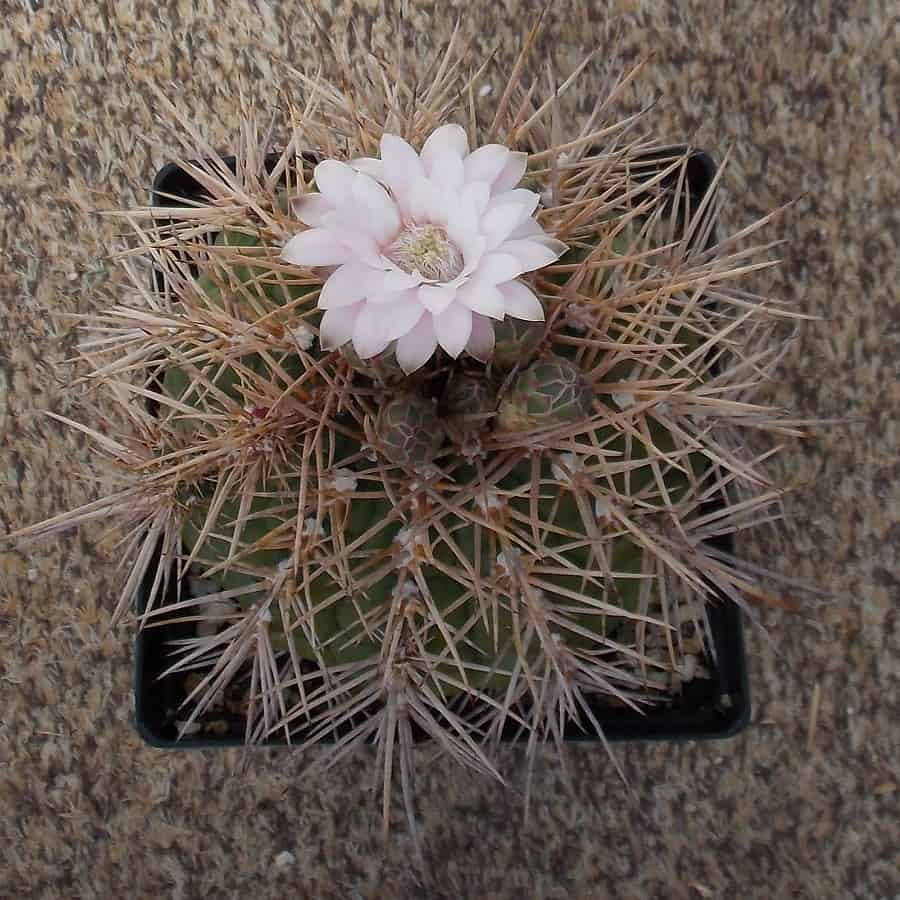
Gymnocalycium eurypleurum is a species that varies in size and has a low growth habit. Some plants have very few spines, while others have more spines.
Gymnocalycium friedrichii
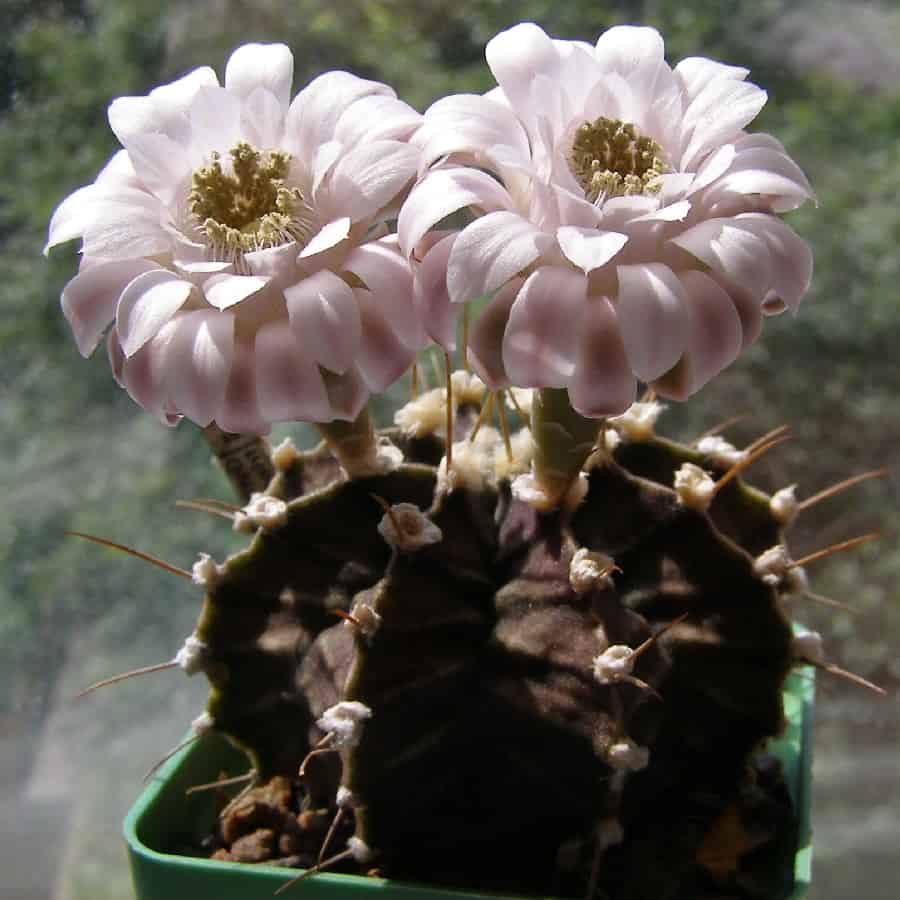
Gymnocalycium friedrichii is an incorrect name used to describe the pink-flowered form of Gymnocalycium stenopleurum. It is a small cactus that grows alone and has a body with bands of color. The flowers of this species can be pinkish-red with white edges, pale pink, or almost pure white. Sometimes, it is grouped with Gymnocalycium mihanovichii, and other times it is considered a separate species.
Gymnocalycium friedrichii var moserianum
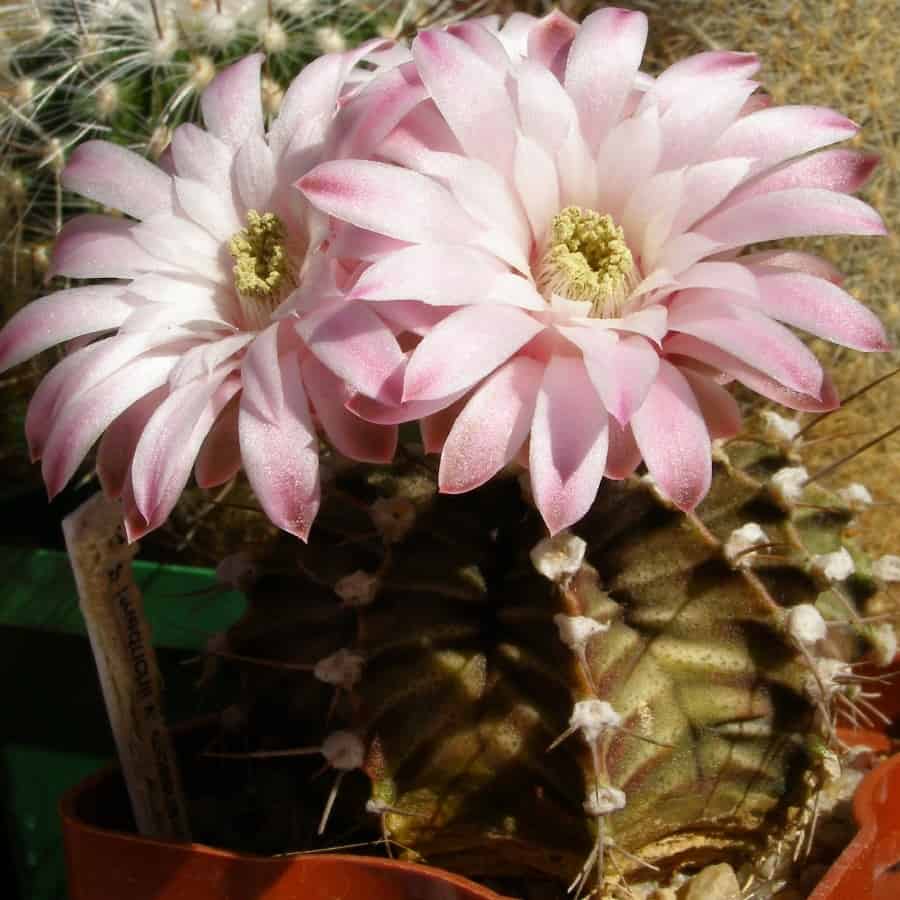
Gymnocalycium friedrichii var moserianum is a disputed variety that belongs to the Gymnocalycium mihanovichii/stenopleurum group. Compared to Gymnocalycium friedrichii, the stems of this plant are twice as large. It has an attractive reddish-brown body with pointed ribs and white stripes around the areoles. The areoles are usually covered in wooly hairs and have only three spines. The weak spines tend to fall off over time. The flowers are pale pink or white and open completely.
Gymnocalycium gibbosum
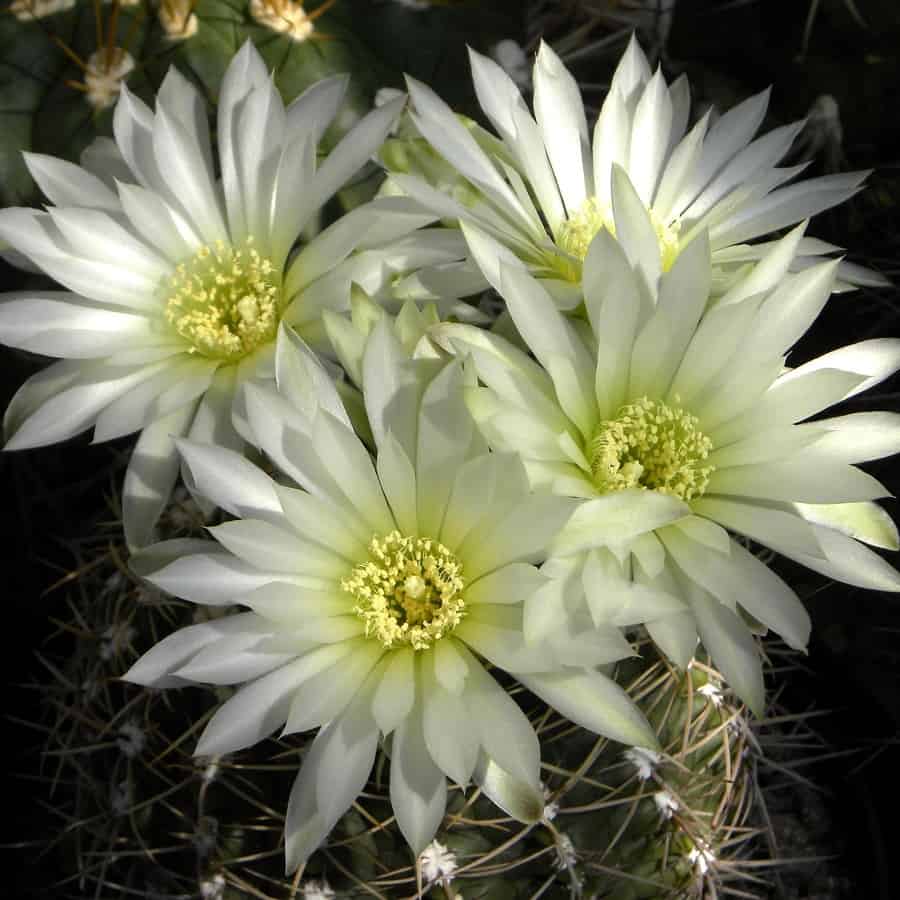
Gymnocalycium gibbosum is a small cactus that stands alone. It comes in many different forms, which can sometimes confuse experts. They have given unnecessary names to these variations.
Gymnocalycium gibbosum var brachypetalum
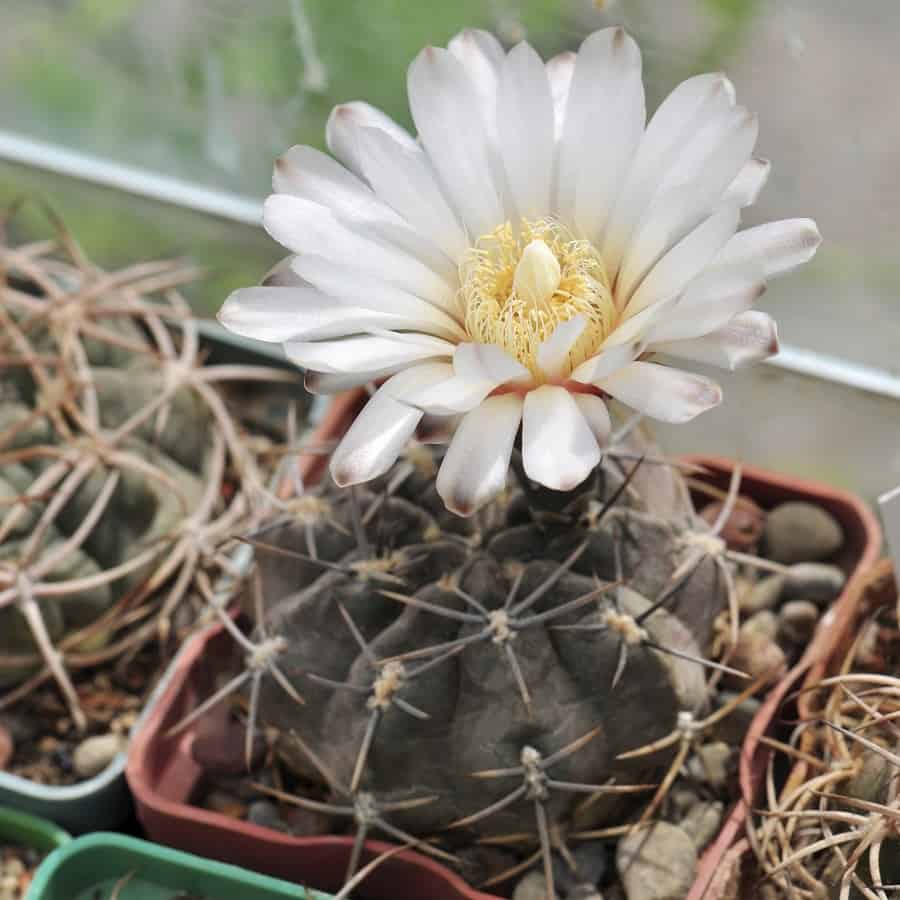
One of the different types of Gymnocalycium gibbosum is called var. brachypetalum. It is not clear if this type is a separate species or just part of the larger group. There are so many variations that most experts treat them as one group. This special variety has a unique dark gray-green to almost black stem and big white flowers.
Gymnocalycium gibbosum var chubutense
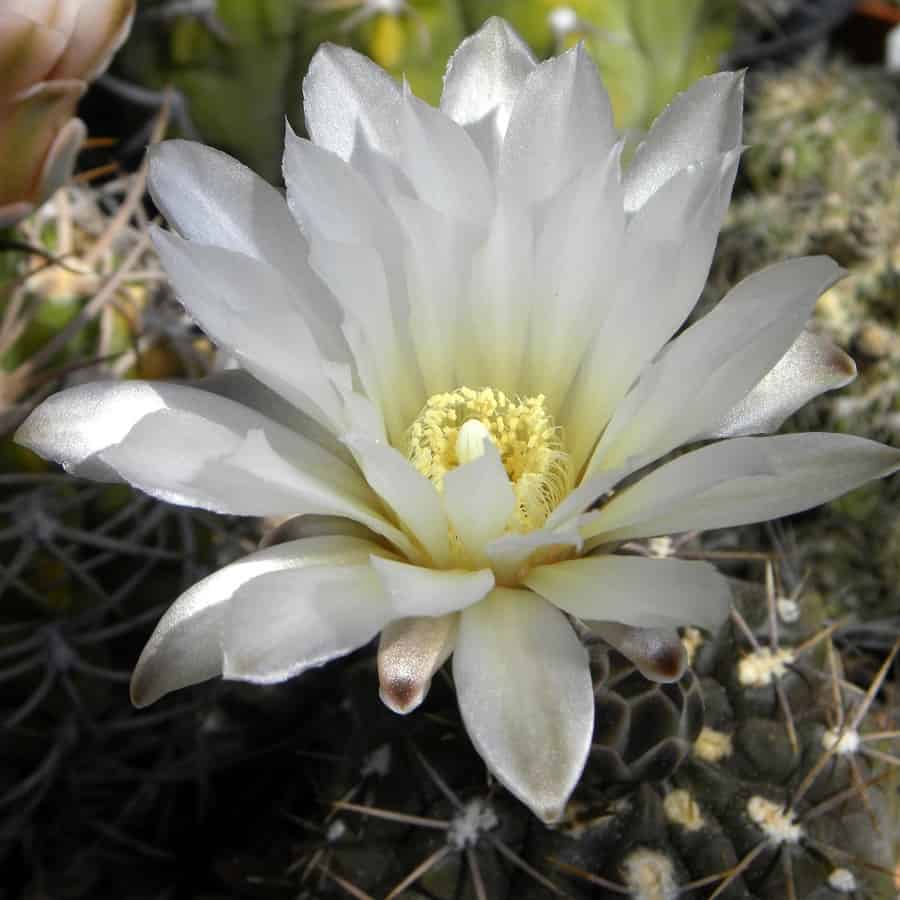
Another type of Gymnocalycium gibbosum is var. chubutense. Just like var. brachypetalum, it is uncertain if this is a separate species or part of a larger group. Because of all the variations, experts tend to group them together. This variety stands out with its dark green to nearly black stem and cream-white or pinkish flowers.
Gymnocalycium hamatum
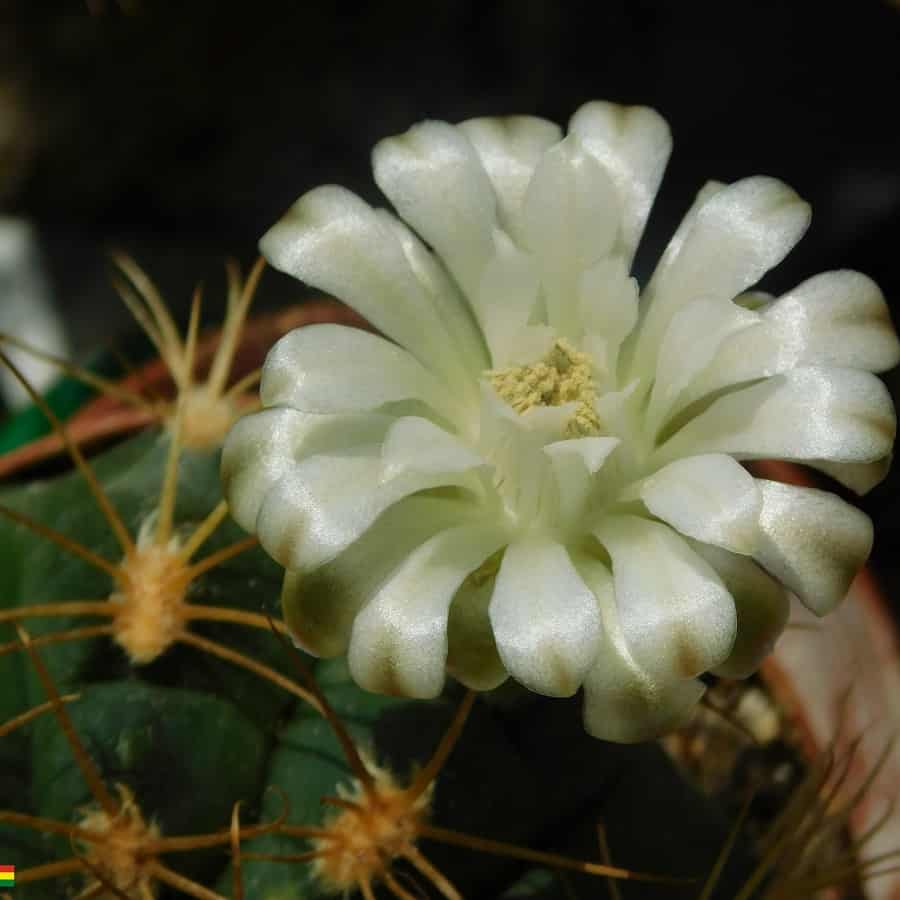
Gymnocalycium hamatum is a local form of Gymnocalycium marsoneri. It has an olive green body with bumpy areas. The spines are light in color and stick out from the body, they are straight but slightly curved at the top. However, the special features of Gymnocalycium hamatum seem to just be part of the normal variations of Gymnocalycium marsoneri, so it should be considered the same species.
Gymnocalycium horstii
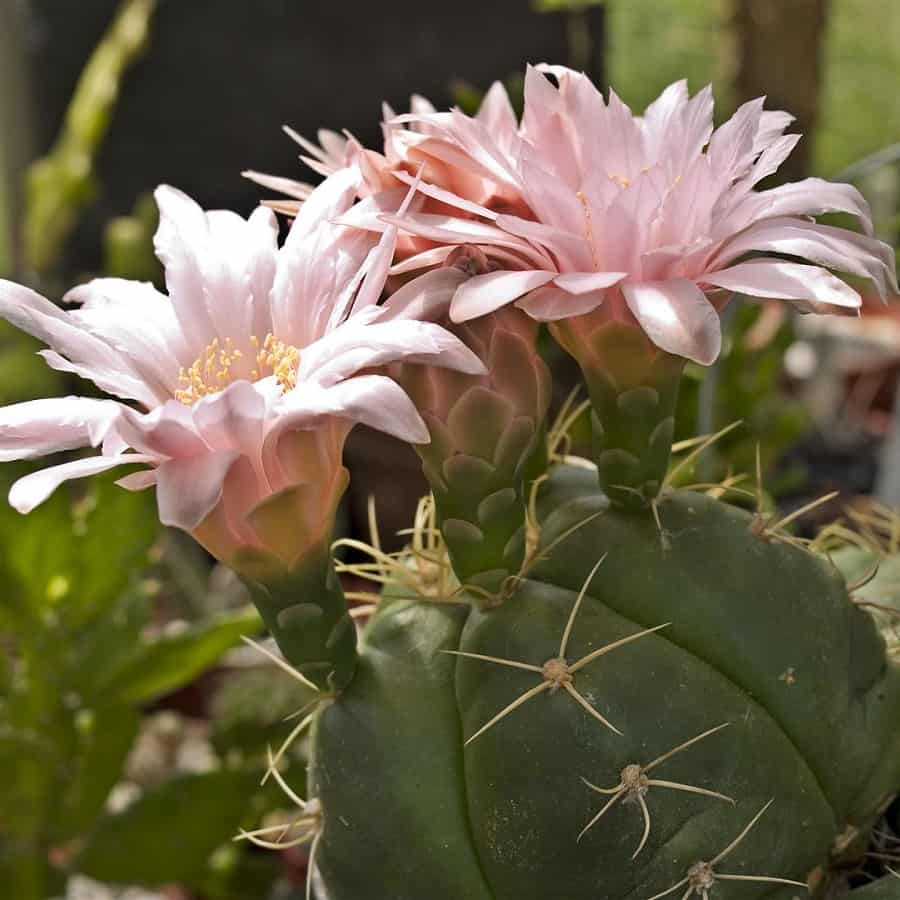
Gymnocalycium horstii is a large and distinctive cactus with minimal spines. It has a round, green body. It usually stands alone but can also slowly form clusters as it grows older. There are two recognized subspecies, the main type and subsp. buenekeri. In the past, subsp. buenekeri was thought to be a different species, but more studies are needed to confirm if it should be considered separate or not.
Gymnocalycium horstii subsp buenekeri
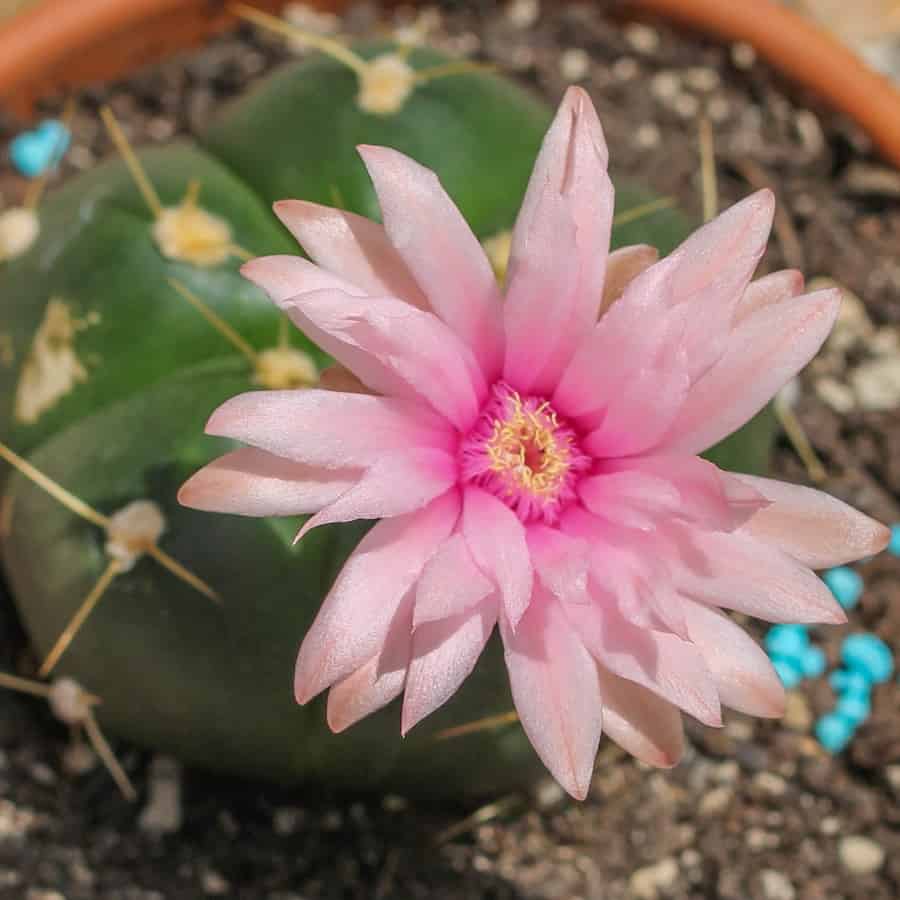
Gymnocalycium horstii subsp buenekeri is very similar to Gymnocalycium horstii. They have beautiful pink flowers and a similar appearance with five ribs and nice yellow spines. This cactus can grow in clusters and it grows quickly.
Gymnocalycium hyptiacanthum subsp uruguayense
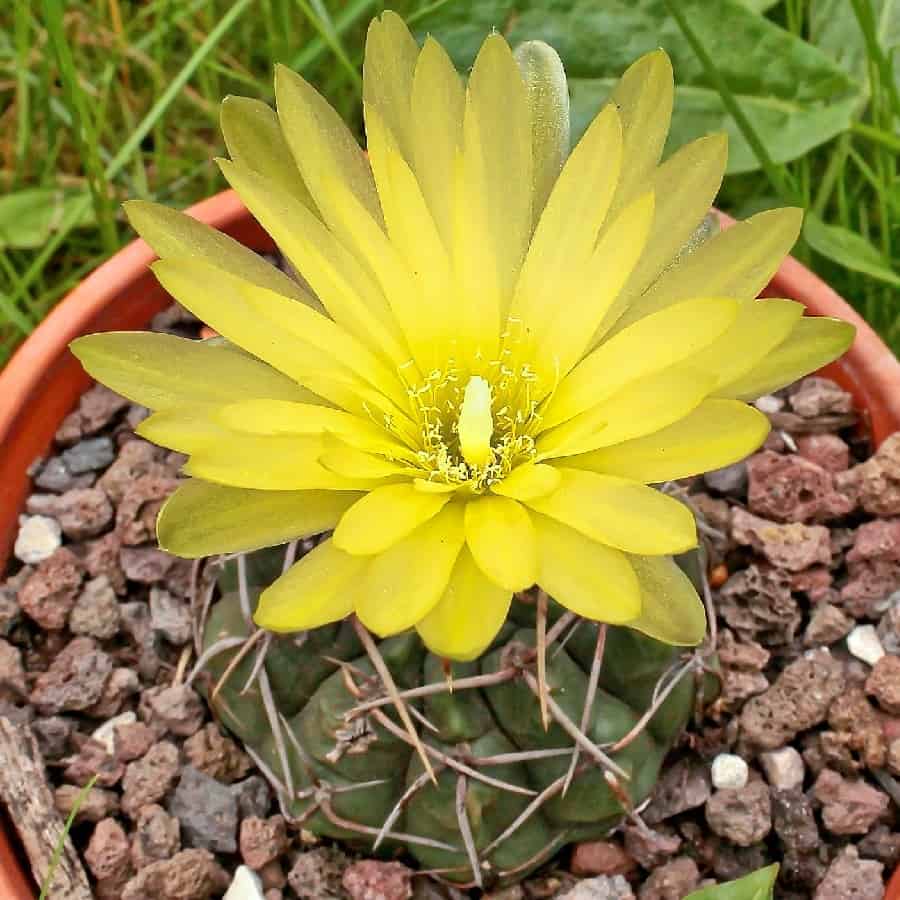
Gymnocalycium hyptiacanthum subsp uruguayense is a small cactus that usually grows alone and doesn’t rise much above the ground. This species has a lot of variation in the length and shape of its spines, which look like the long legs of a spider. That’s why it has been given many different names.
Gymnocalycium intermedium
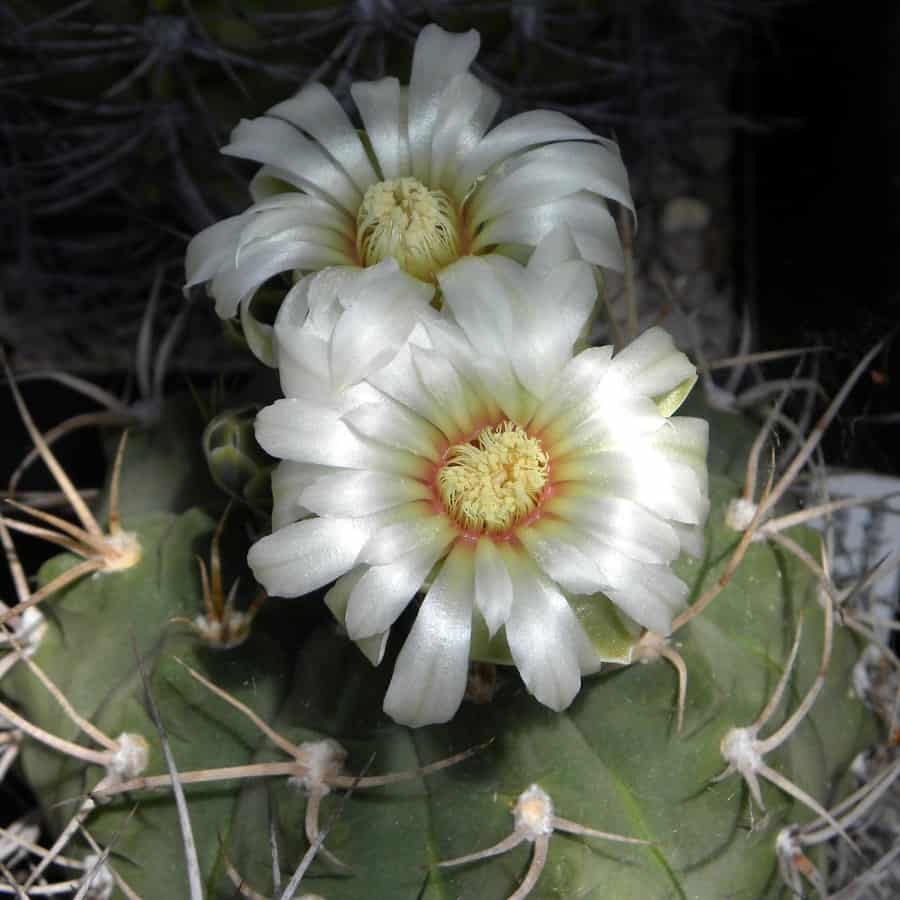
Gymnocalycium intermedium is a name used to describe one of the local forms of Gymnocalycium ochoterenae, another cactus species. It has a short, gray-green or blue-green body that can grow up to 9 cm high and 4-10 cm wide, or even bigger when cultivated.
Gymnocalycium marquezii
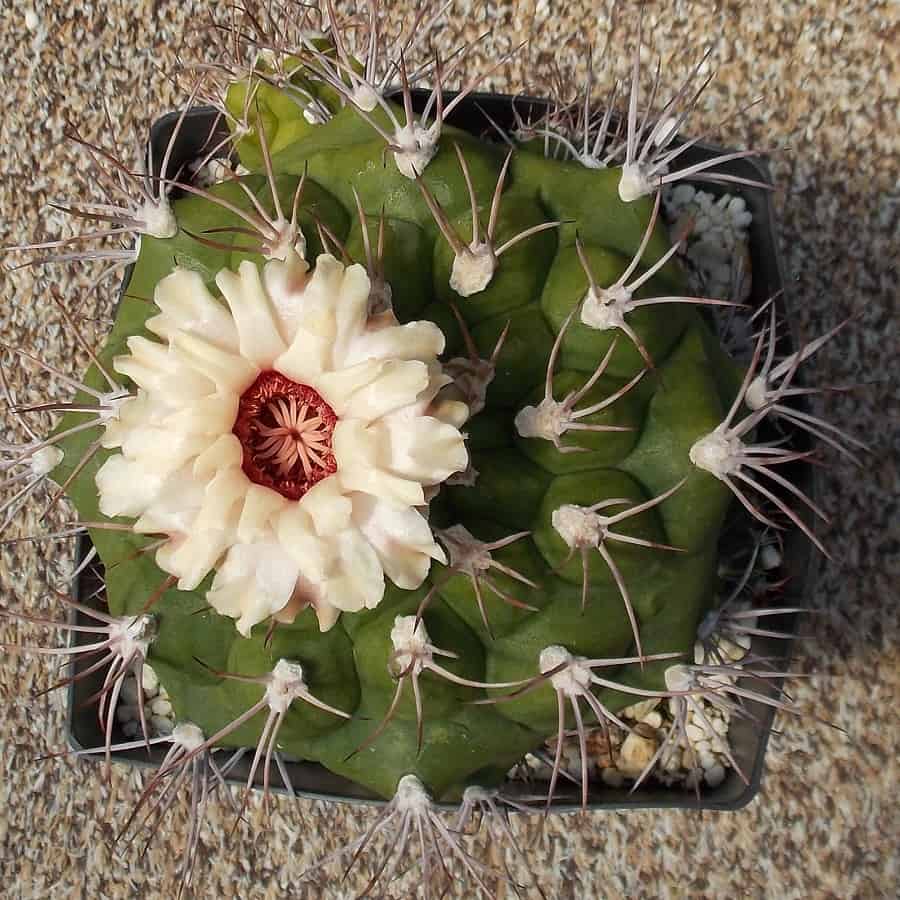
Gymnocalycium marquezii is a cactus that can stand alone or slowly form clusters. Its spine clusters have a distinctive curvature, bending backward. It has a similar structure to Gymnocalycium pfanzii var. riograndense, but its stem has a dark coppery red color, and its spines are dark.
Gymnocalycium marsoneri
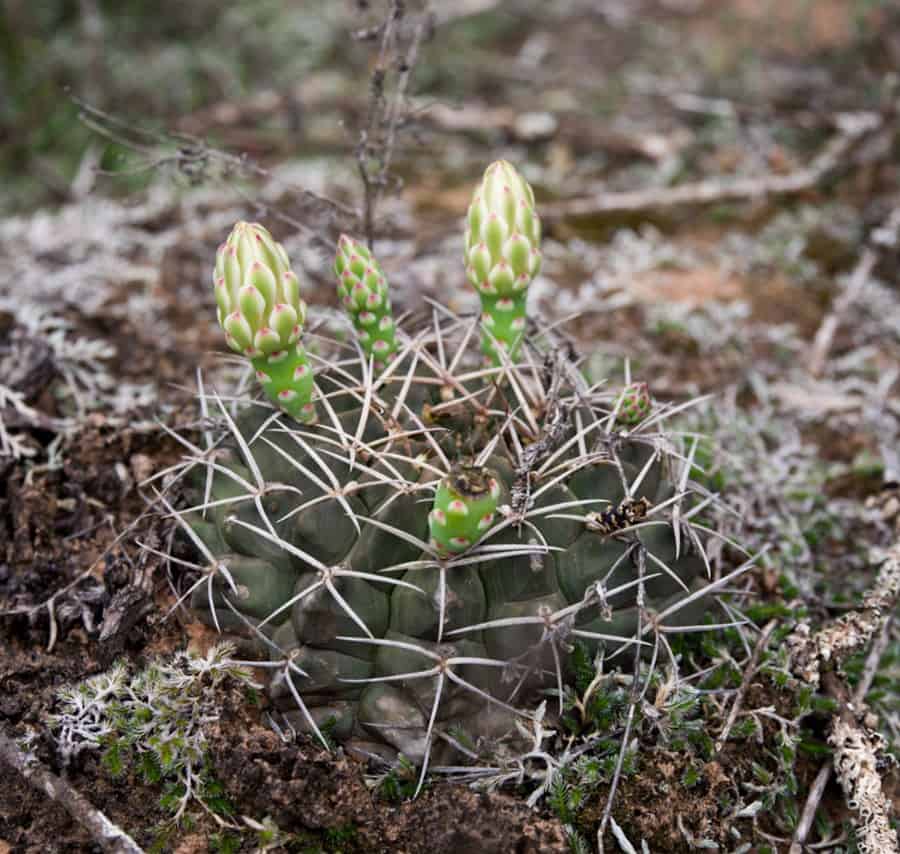
Gymnocalycium marsoneri is a rounded cactus that looks a bit flattened. It has spreading spines that sometimes curve backward. The spines are a rich brown and create a pleasing contrast against the greenish-bronze body.
Gymnocalycium marsoneri subsp matoense
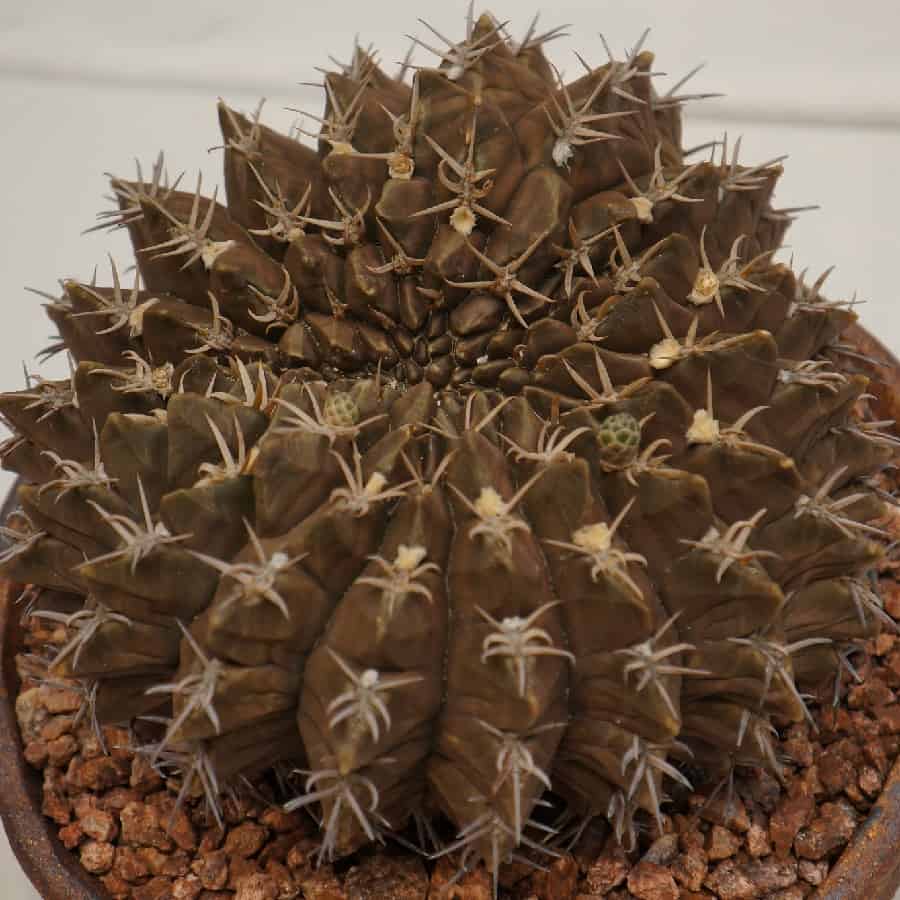
Gymnocalycium marsoneri subsp matoense is the Brazilian population of Gymnocalycium marsoneri. It has a slightly flattened bronze-green body with about 21 ribs. Its fruits are bluish green. However, the special features of subsp. matoense seem to just be part of the natural variations of Gymnocalycium marsoneri, so it should be considered the same species.
Gymnocalycium mazanense
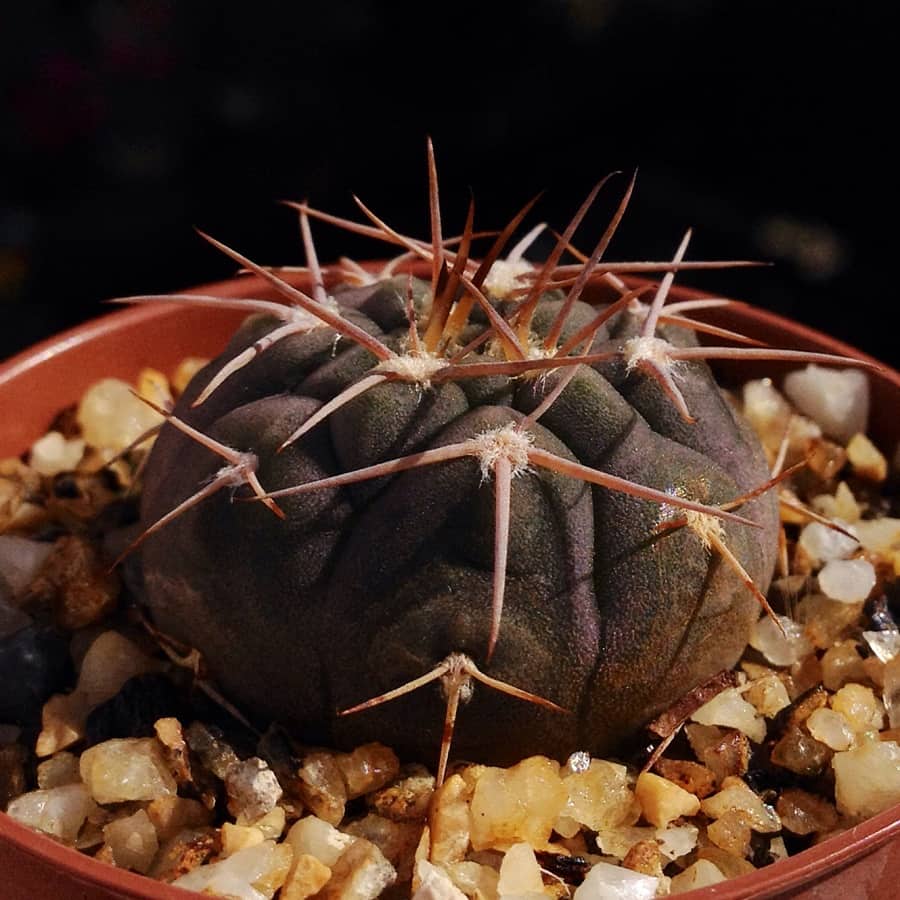
Gymnocalycium mazanense is a very spiny cactus that usually grows alone. Even within the same group of plants, there is a lot of variation.
Gymnocalycium mazanense var ferox
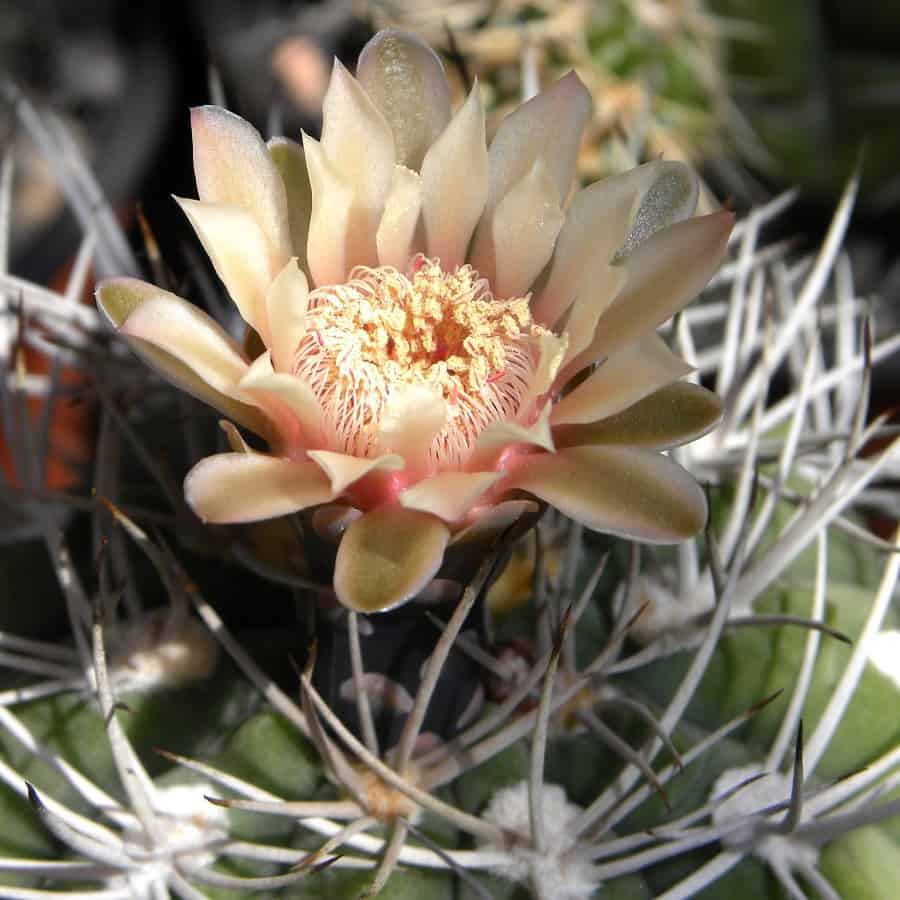
Gymnocalycium mazanense var. ferox is one of the many forms of Gymnocalycium hossei, a cactus with a lot of variation. It’s still unclear if all these variations are part of one species or several species. There is so much variation even within the same group of plants that most experts group them together.
This particular variation, var. ferox, is quite variable and stands out because of its thick interlacing greyish spines. The body of the cactus is almost hidden by these spines, making it one of the most attractive cacti in the Gymnocalycium genus.
Gymnocalycium megalothelon
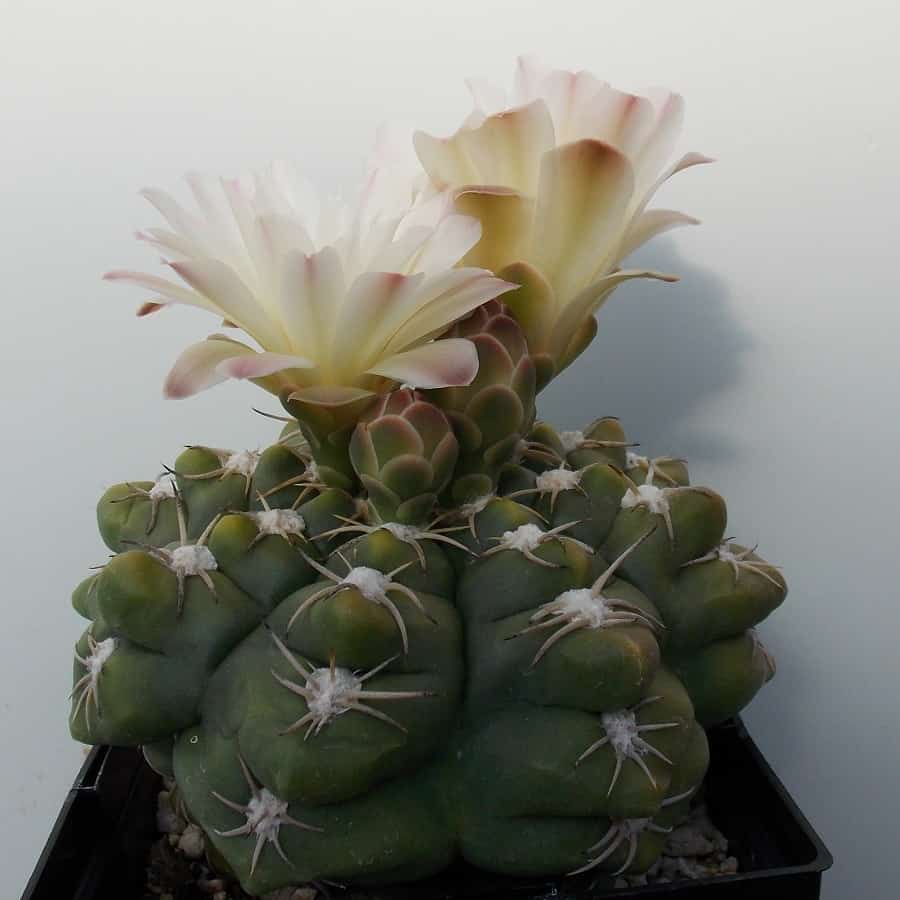
Gymnocalycium megalothelon is a form of Gymnocalycium denudatum, but it is not different enough to be considered a separate species. It is just a local variation of Gymnocalycium denudatum. The key difference that was once used to separate them, involving the spines and flowers, doesn’t seem to hold true. However, there are still some slight differences between them.
Gymnocalycium mesopotamicum
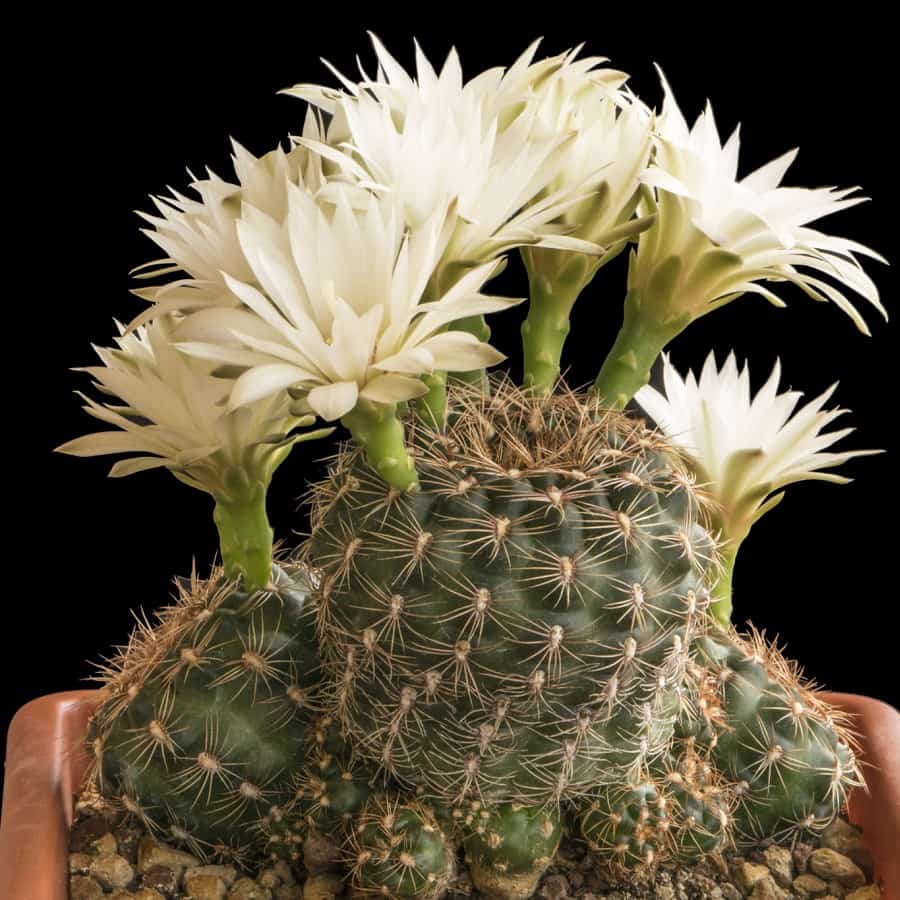
Gymnocalycium mesopotamicum is a small cactus that usually grows alone in nature, but when cultivated, it can form attractive clusters.
Gymnocalycium mihanovichii
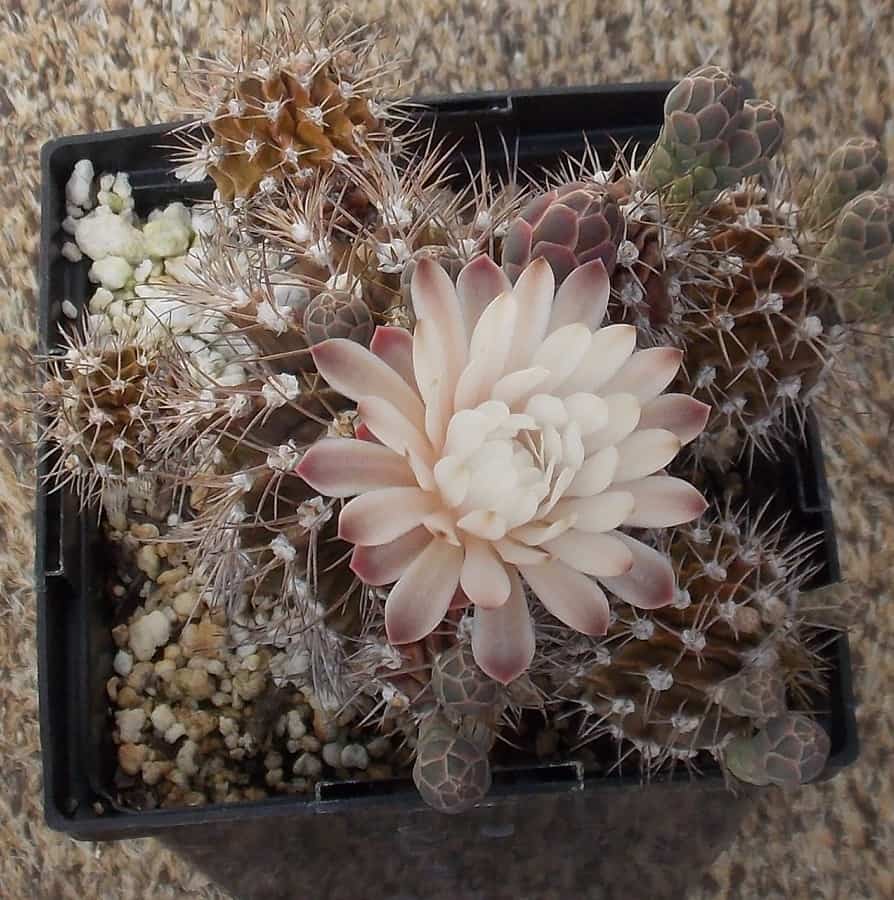
Gymnocalycium mihanovichii is a cactus considered to be very small. It only grows to a height of 4 cm and has a diameter of 5-6 cm. The flowers of this species don’t fully open and have a silky appearance. They range in color from pale green to brownish-yellow. The cactus has wider, lower ribs, and as it matures, every rib has a flat surface.
Related Post:
Gymnocalycium mihanovichii Variegata
Gymnocalycium mihanovichii var filadelfiense
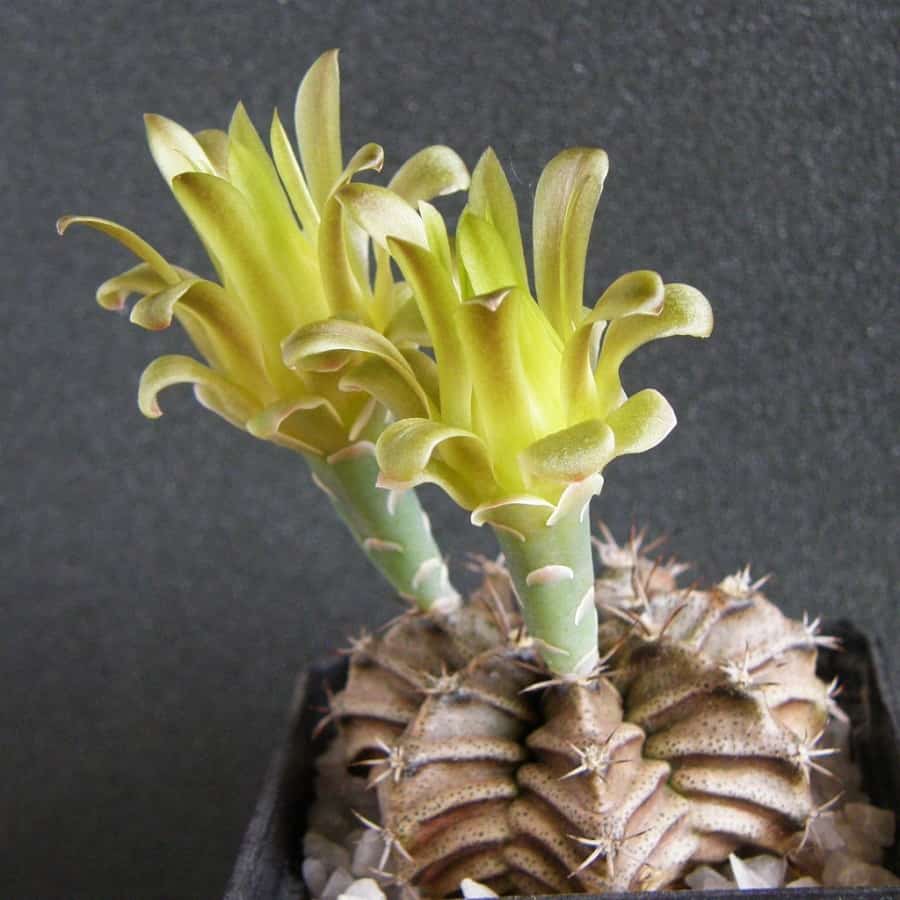
Gymnocalycium mihanovichii var filadelfiense is usually a solitary cactus. It grows to a height of 4 cm and has a diameter of 5-6 cm.
Gymnocalycium mihanovichii var stenogonum
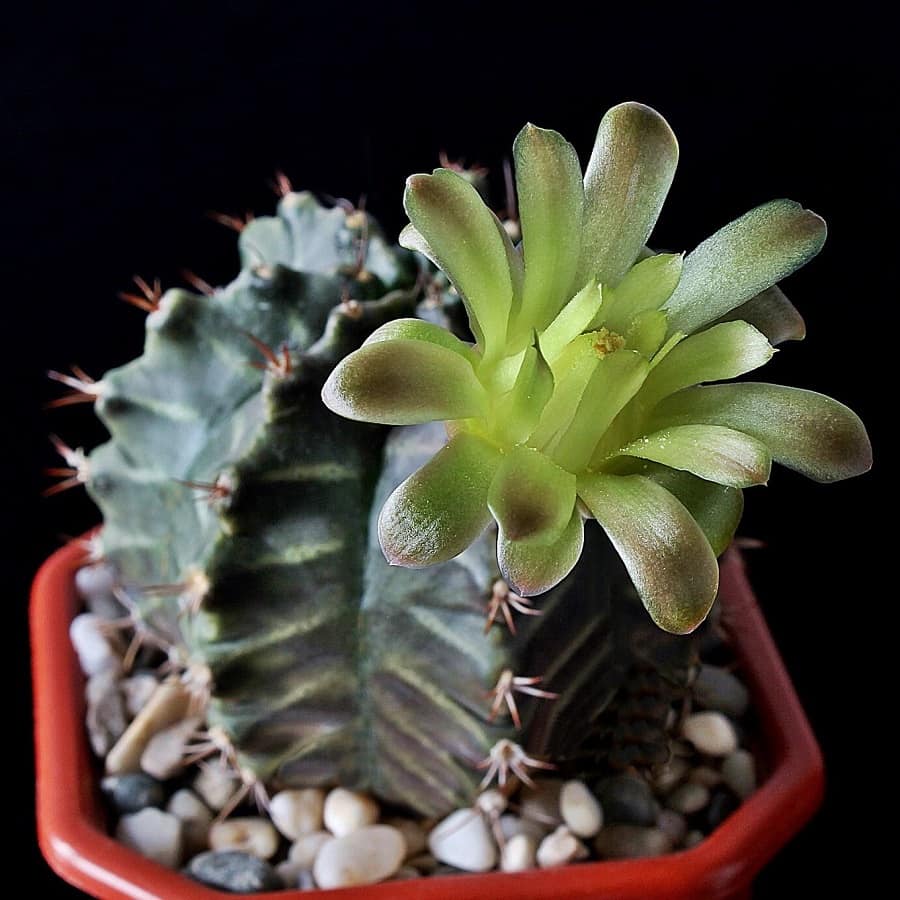
Gymnocalycium mihanovichii var stenogonum has a larger stem, reaching up to 15 cm in diameter. It has a fresh green to bronze color when exposed to full sun. The flowers are also larger and greenish. This variation comes from Toro Alarachii in southern Chaco, Argentina.
Gymnocalycium mihanovichii cv Hibotan
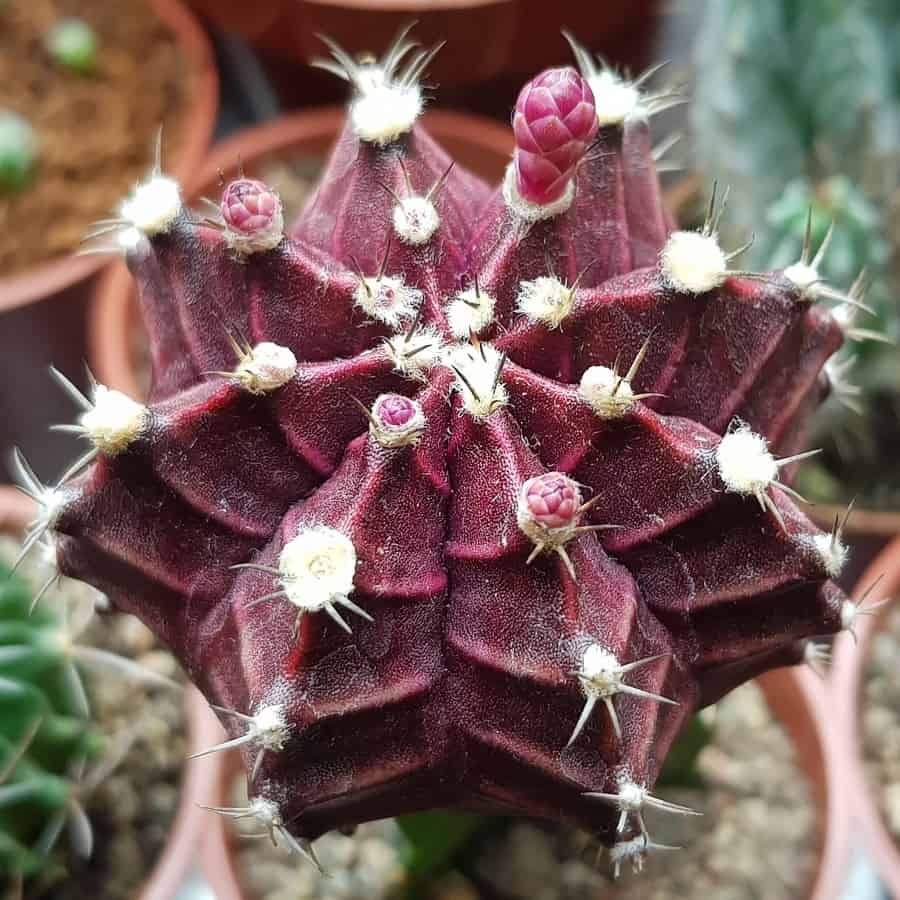
Gymnocalycium mihanovichii cv Hibotan includes many unique mutants with bodies that are more or less red-colored. They can be red, orange, dark purplish, yellow, or even white. Their color is due to a lack of chlorophyll, which is the substance that helps plants produce sugar. Without sugar, these mutants cannot survive. They need to be grafted onto other cacti that have chlorophyll to provide them with sugar. The bottom part of the graft, called the stock, is usually a tropical cactus called Hylocereus.
Gymnocalycium monvillei
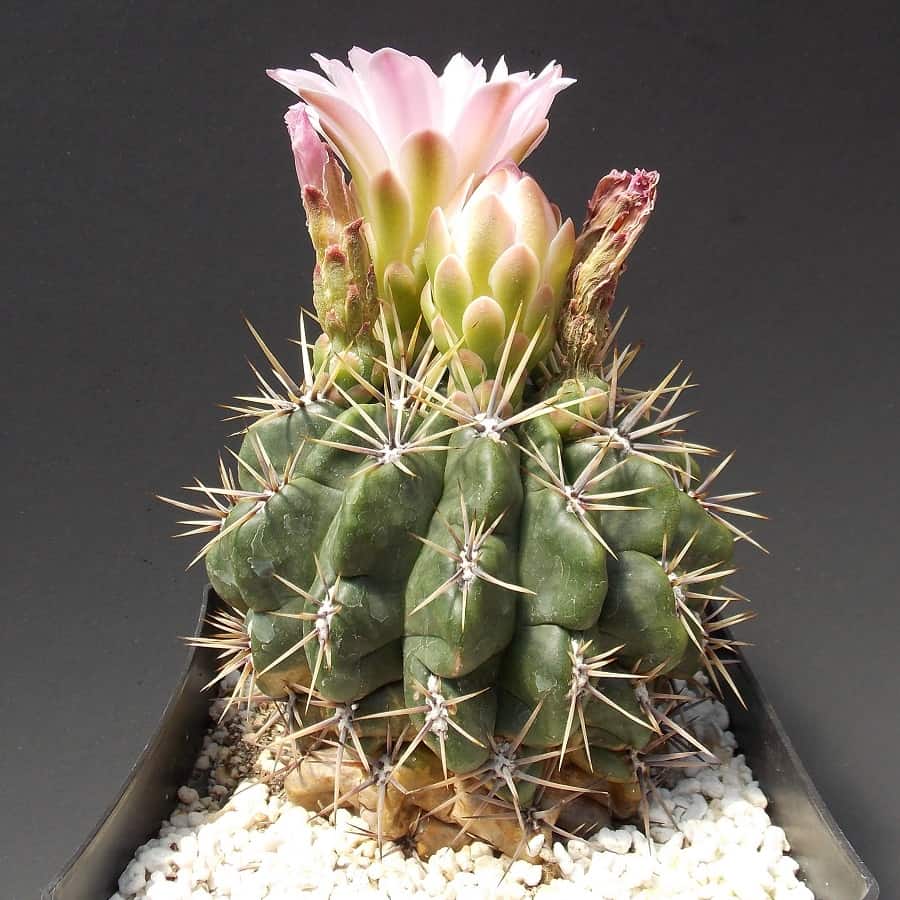
Gymnocalycium monvillei is a well-known cactus that many people love because it has pretty pink flowers and strong thorns. It can look different depending on where it grows, and in the past, people gave it unnecessary special names.
Gymnocalycium monvillei subsp achirasense
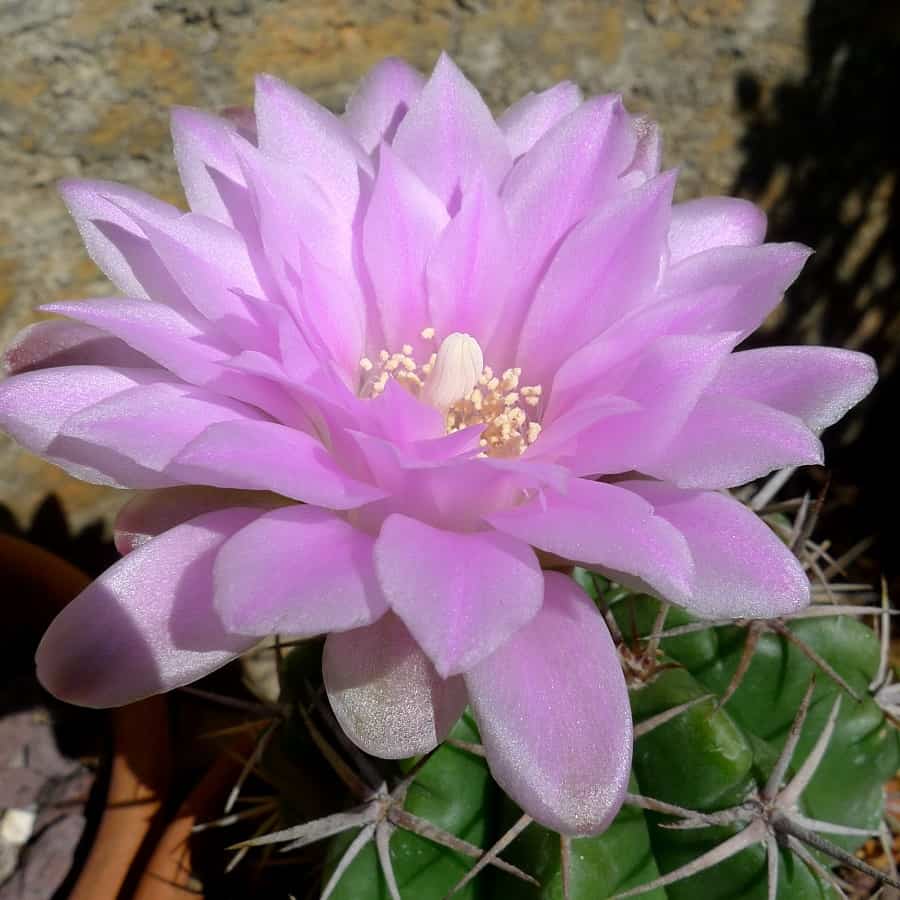
Gymnocalycium monvillei subsp achirasense is usually a cactus that stands alone. Its stem can be flat or round and is gray-green or olive green. It can be 2 to 2.4 inches across and grow up to 2 inches tall, but in gardens, it can grow even taller over time.
Gymnocalycium monvillei subsp horridispinum
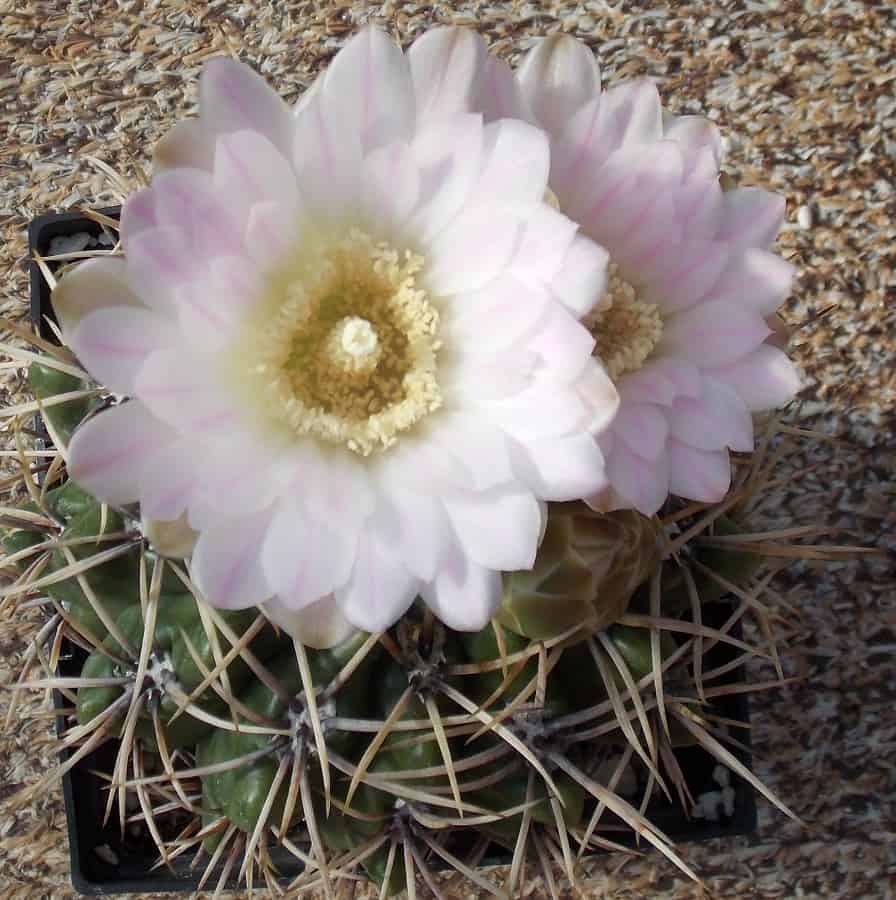
Gymnocalycium monvillei subsp horridispinum is a very unique cactus that usually stands alone. You can easily recognize it because it has strong thorns that stand out. You don’t need to study its seeds or use other methods to identify it. The thorns are gray with brown tips and are thick, strong, and sharp.
Most Gymnocalycium cacti have flat or round stems, but Gymnocalycium monvillei subsp horridispinum has a somewhat columnar stem as it gets older. Its flowers can be white with pink edges, purple-pink, or just pink. It is similar to Gymnocalycium multiflorum.
Gymnocalycium monvillei var steineri
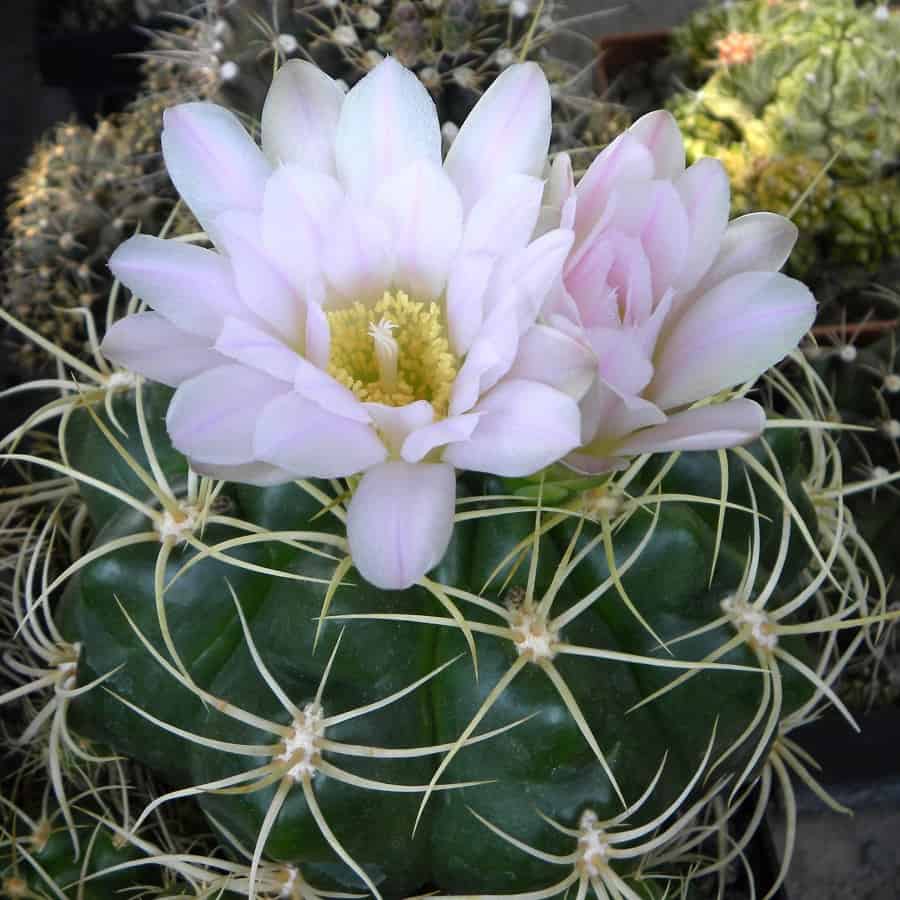
This type of Gymnocalycium monvillei is different from the regular kind because it has bunches of golden-yellow spines that stick out like brooms.
Gymnocalycium mostii
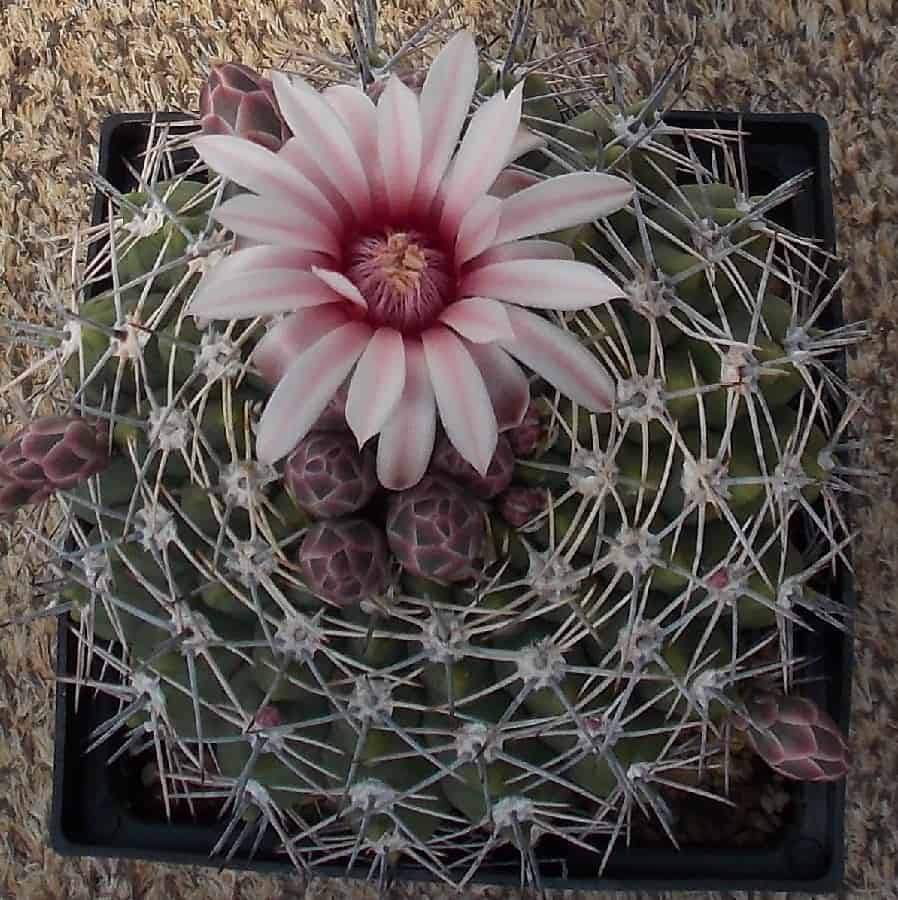
Gymnocalycium mostii is a cactus that stands alone and has a flat dark green stem that is usually less than 13 inches across. It has wide and round ribs with a small pointy part below each bump. The spines are a light brown color and turn red when they get wet. It produces lots of pale rose-pink flowers during the growing season.
Gymnocalycium mostii subsp valnicekianum
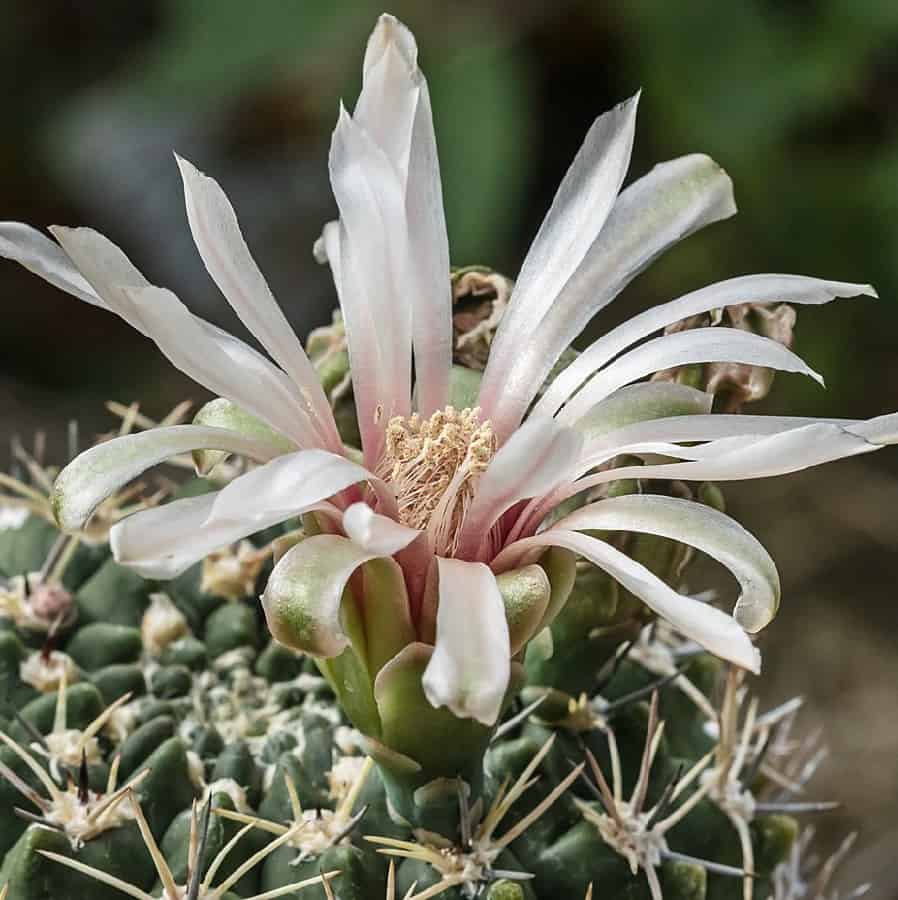
Gymnocalycium mostii subsp valnicekianum is often found alone, but as it grows older, it can also form groups. Each plant in its natural environment is unique! Some have strong thorns, while others have weak, curly, straight, long, or short ones, and they all come in different combinations.
Gymnocalycium multiflorum
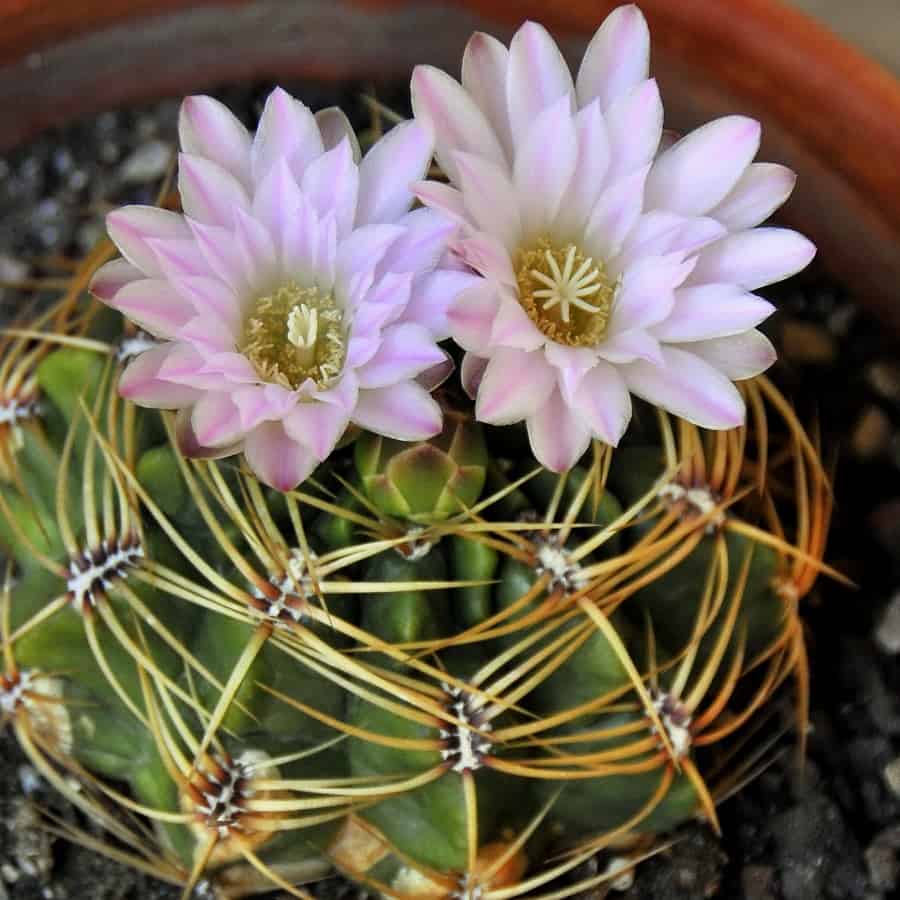
Gymnocalycium multiflorum is a type of Gymnocalycium monvillei that can look different. It’s well-known and stands out from regular Gymnocalycium monvillei because it has a dark bluish body and large white flowers (not pink) that are very pretty.
It got its name “multiflorum” because it can have lots of white flowers that show off, but when people grow it at home, it usually doesn’t bloom as much as the name suggests. In the past, people gave it unnecessary special names.
Gymnocalycium neuhuberi
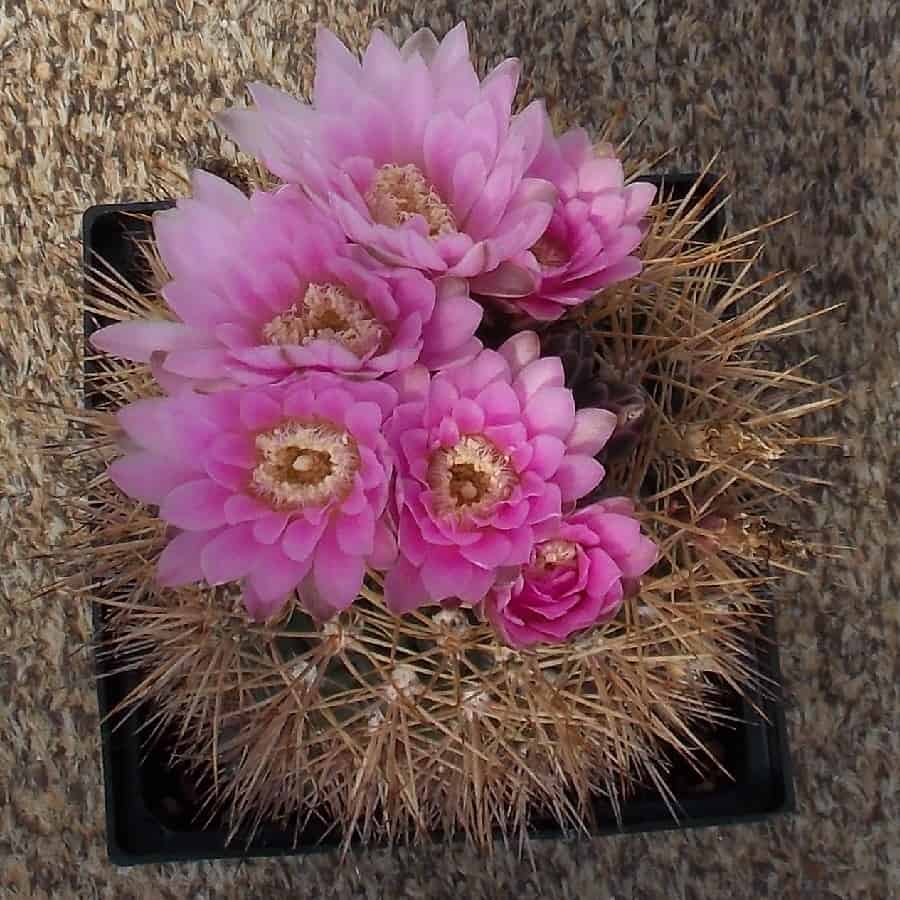
Gymnocalycium neuhuberi is a beautiful cactus that isn’t too big. It catches your eye with its lovely lilac flowers and usually has yellowish spines (sometimes they can be orange or brown). Not only does this cactus have a pretty flower, but it also has a nice smell.
When it was discovered, people thought it was related to Gymnocalycium monvillei because its flowers were a similar pink color. It actually grows together with a local type of Gymnocalycium monvillei and another kind of Gymnocalycium called Gymnocalycium fischeri ssp. suyuquense.
Gymnocalycium ochoterenae
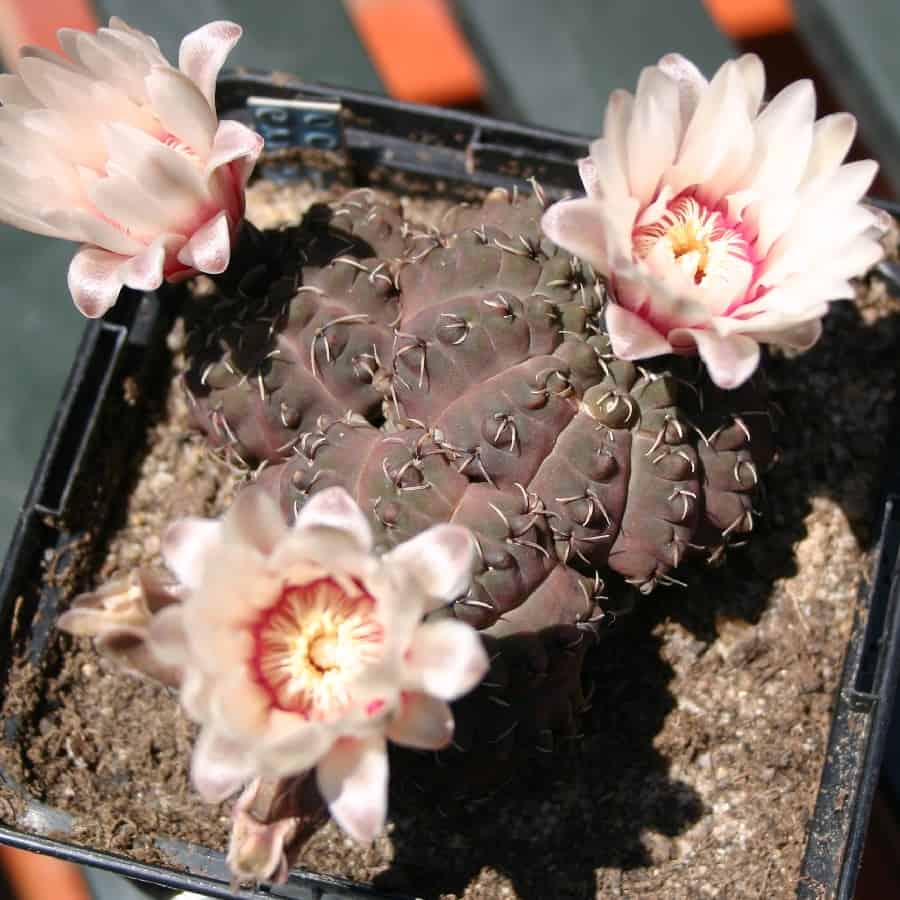
Gymnocalycium ochoterenae is a unique cactus that has a flattened body and is brown in color. It can either grow alone and stay close to the ground or, when cultivated, it can branch out and form small groups. This species is interesting because its body shape and thorns can vary a lot, and people have given it many different names.
Gymnocalycium ochoterenae subsp vatteri
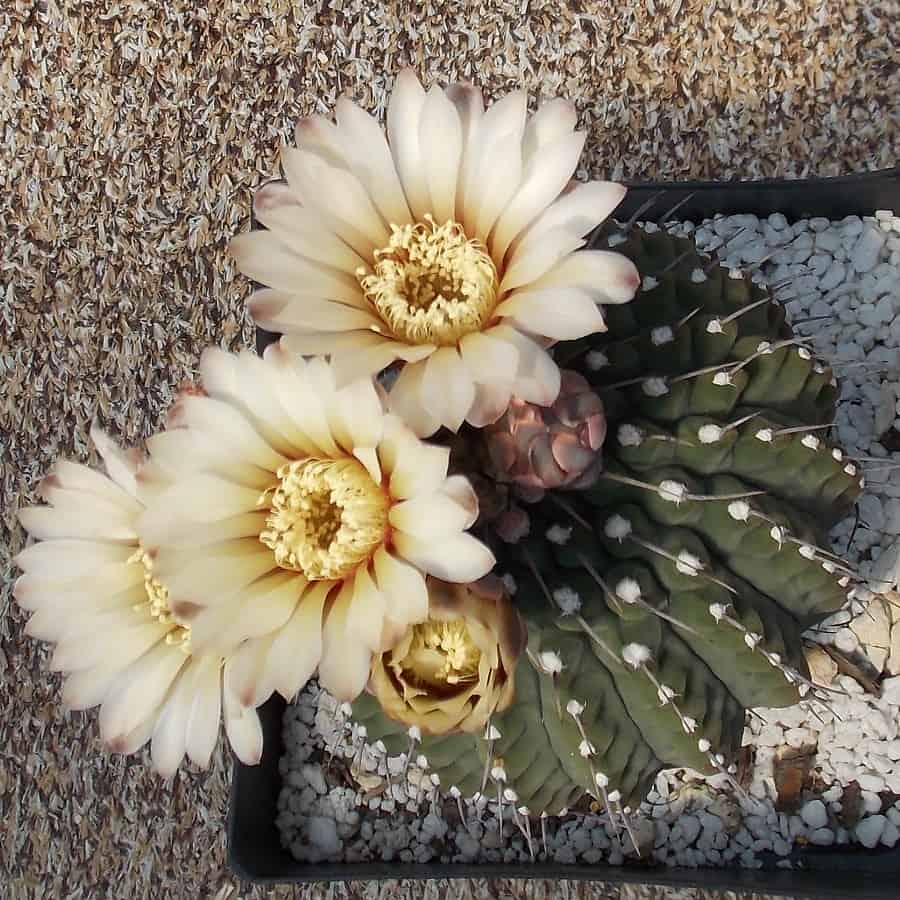
Gymnocalycium ochoterenae subsp vatteri is a slow-growing cactus. Usually, it grows alone, but as it gets older, it can form clusters starting from the base.
Gymnocalycium oenanthemum
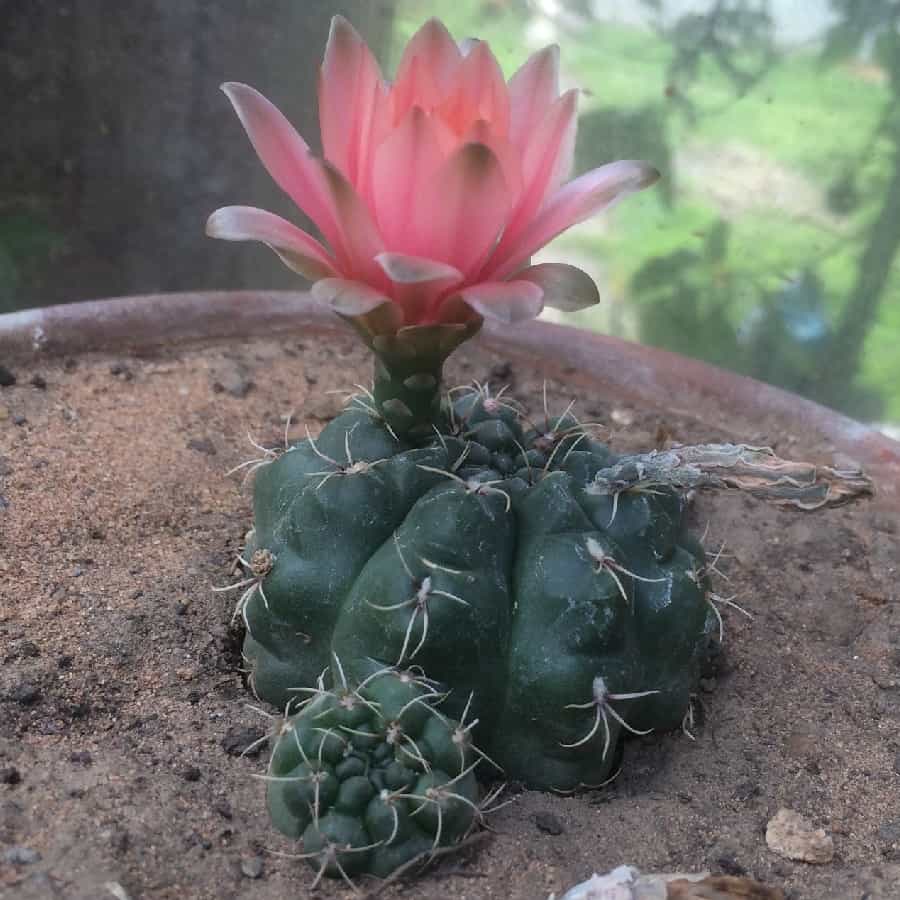
Gymnocalycium oenanthemum is a lovely cactus with a single stem that isn’t too big. It has stout thorns that curve slightly inward, and its real beauty lies in its wine-red or deep salmon-pink flowers.
Gymnocalycium paediophilum
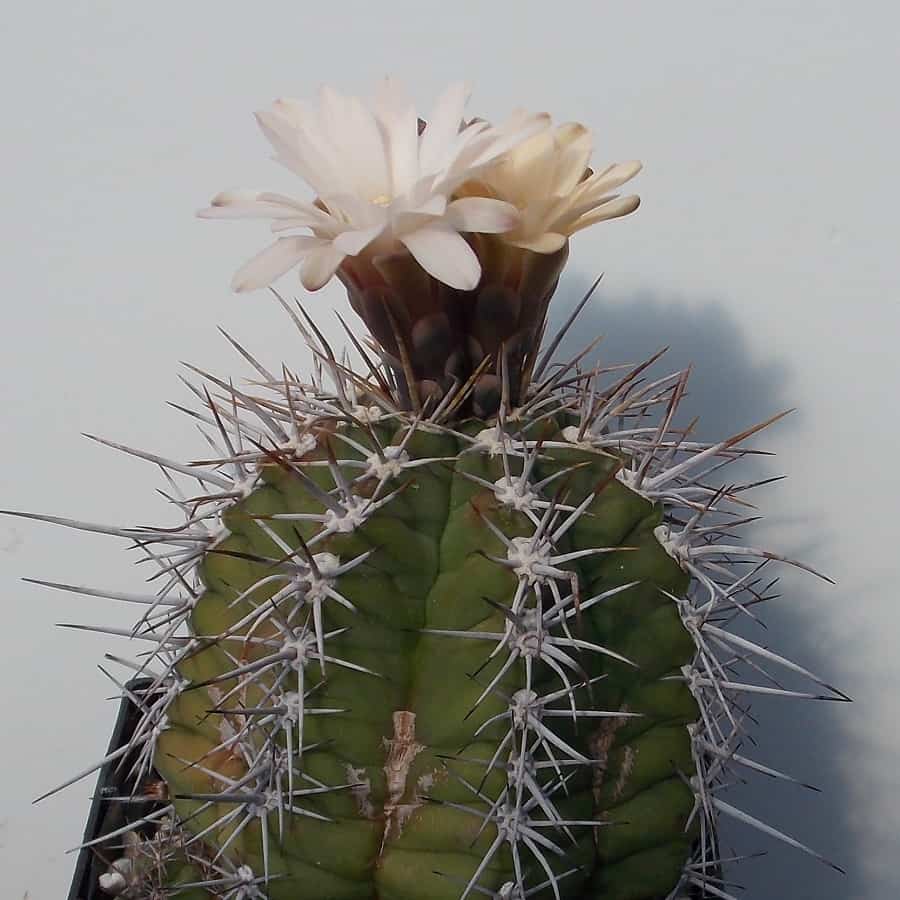
Gymnocalycium paediophilum is a small, pale green cactus that has a round shape. It grows in clumps and is related to both Gymnocalycium chiquitanum (in terms of flowers and seeds) and Gymnocalycium chacoense (in terms of seeds). The stem is depressed and about 2-5 inches in diameter and 4-8 inches tall. It branches out a lot from the base.
Gymnocalycium paraguayense
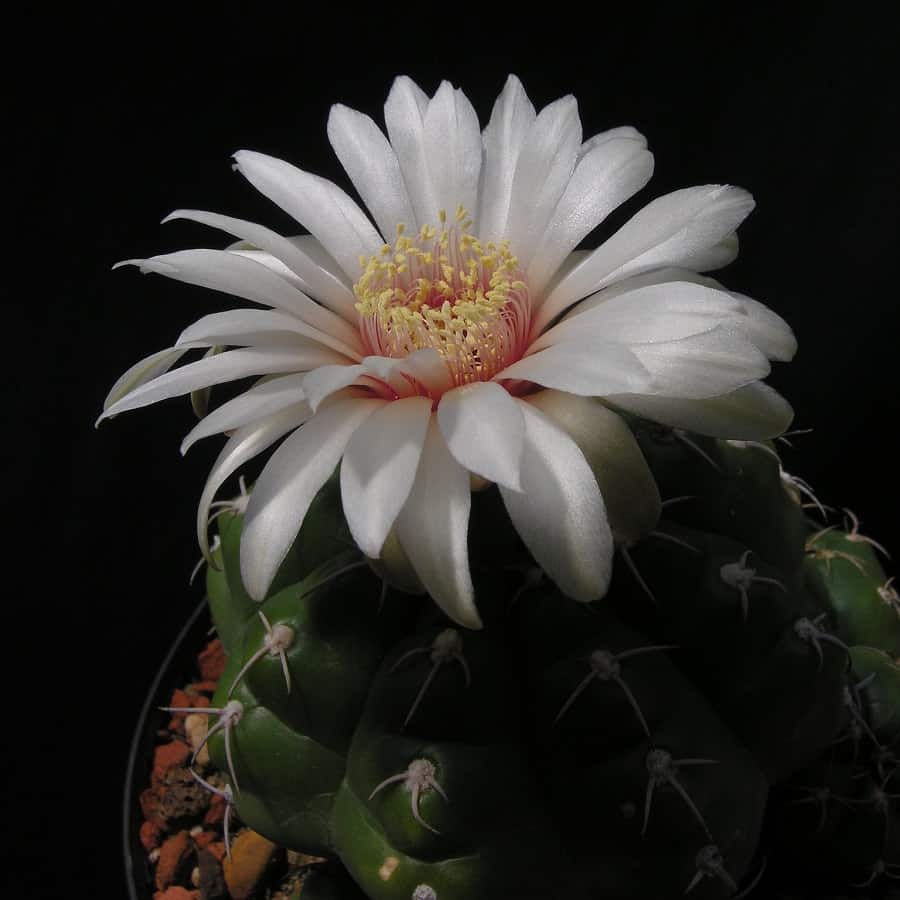
Gymnocalycium paraguayense is a cactus species from Paraguay that can vary a lot. When it’s young, it usually grows alone, but as it gets older, it can form large groups with 20-30 heads. In a single group, you can find different forms of the plant with varying numbers, shapes, and lengths of thorns, and different numbers and shapes of ribs. The only thing that distinguishes it from Gymnocalycium horstii is the red throat of its flower. However, in its normal form, it’s easy to tell apart.
Gymnocalycium paraguayense f fleischerianum
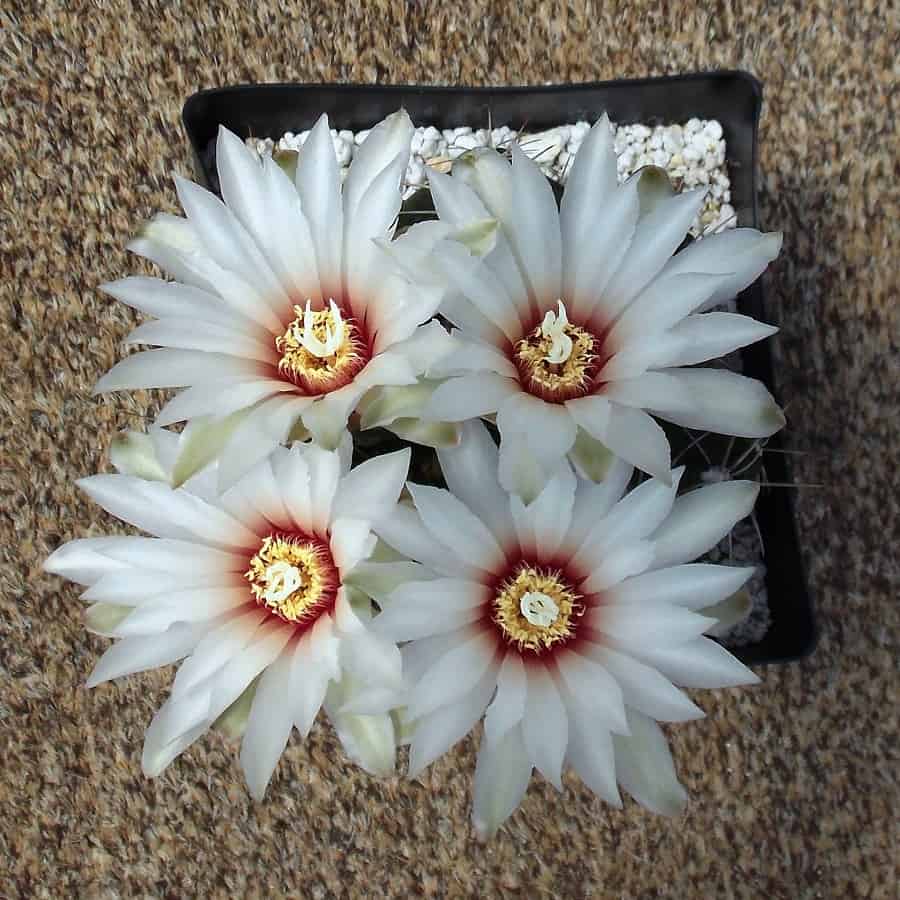
Gymnocalycium paraguayense f. fleischerianum (also known as Gymnocalycium fleischerianum) can look different and is usually considered a variation of Gymnocalycium paraguayense. Its stems are a deeper green and have wider, rounder ribs without the transverse furrow. It has more thorns (up to 9 or more per cluster) that are longer, thinner, and slightly curved, sticking closer to the body.
Sometimes it gets mistakenly labeled as a variety of Gymnocalycium denudatum under different names. Older plants can produce offshoots from the base, forming small groups or mats. The flowers are white with a purplish-pink throat and have a funnel shape, growing up to 1.6-2.4 inches long.
Gymnocalycium pflanzii
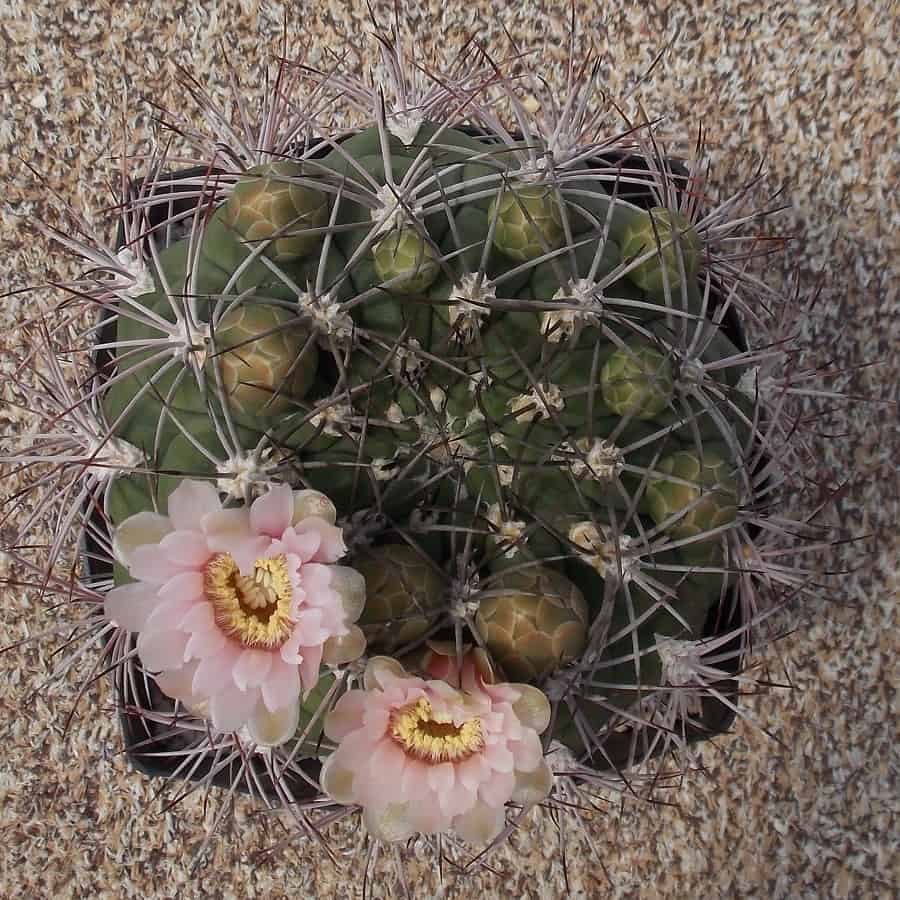
Gymnocalycium pflanzii is a cactus that usually grows alone or, over time, forms small groups. It has a unique feature where its spine clusters bend backward in a distinctive way.
Gymnocalycium pflanzii var albipulpa
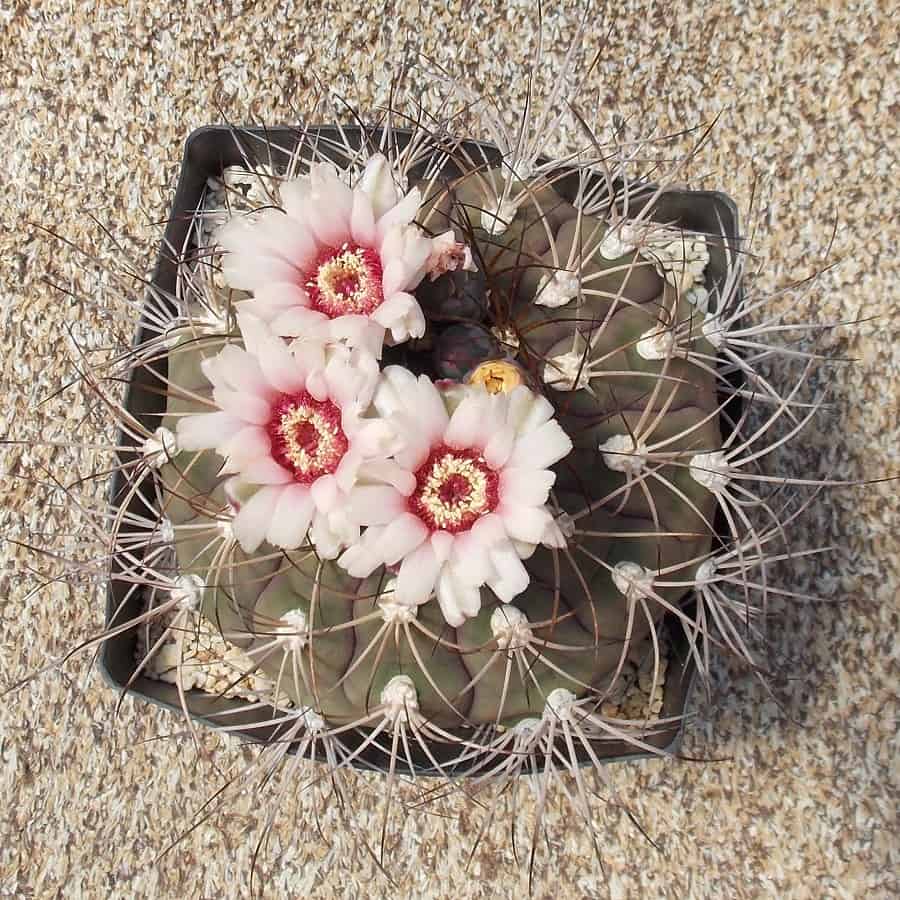
This type of cactus is a little different from the others because its fruit pulp is white instead of red. It looks very similar to the standard Gymnocalycium pflanzii, except for the fruit. The “albipulpa” variety is no longer considered valid and is now considered the same as other types.
Gymnocalycium pflanzii var riograndense
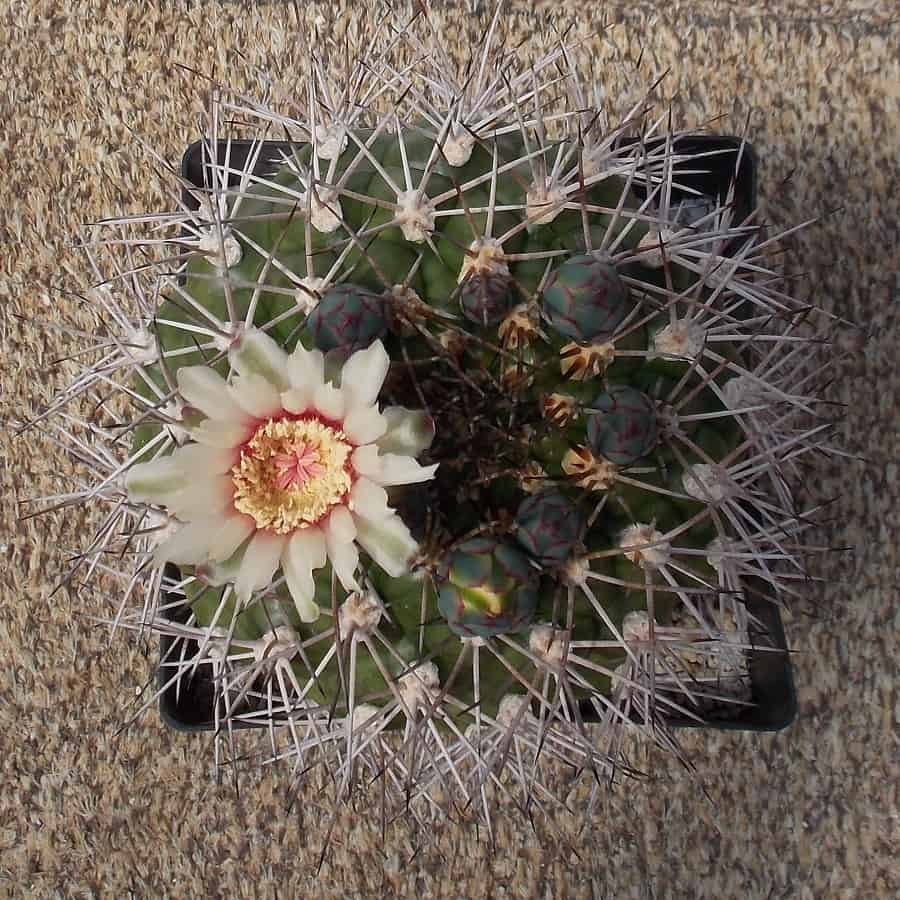
This cactus has a unique shape and its spines bend backward in a distinctive way. Its flowers are short and have bluish-red centers. It can be difficult to tell this species apart from other similar forms of Gymnocalycium pflanzii because they look so similar.
Gymnocalycium quehlianum
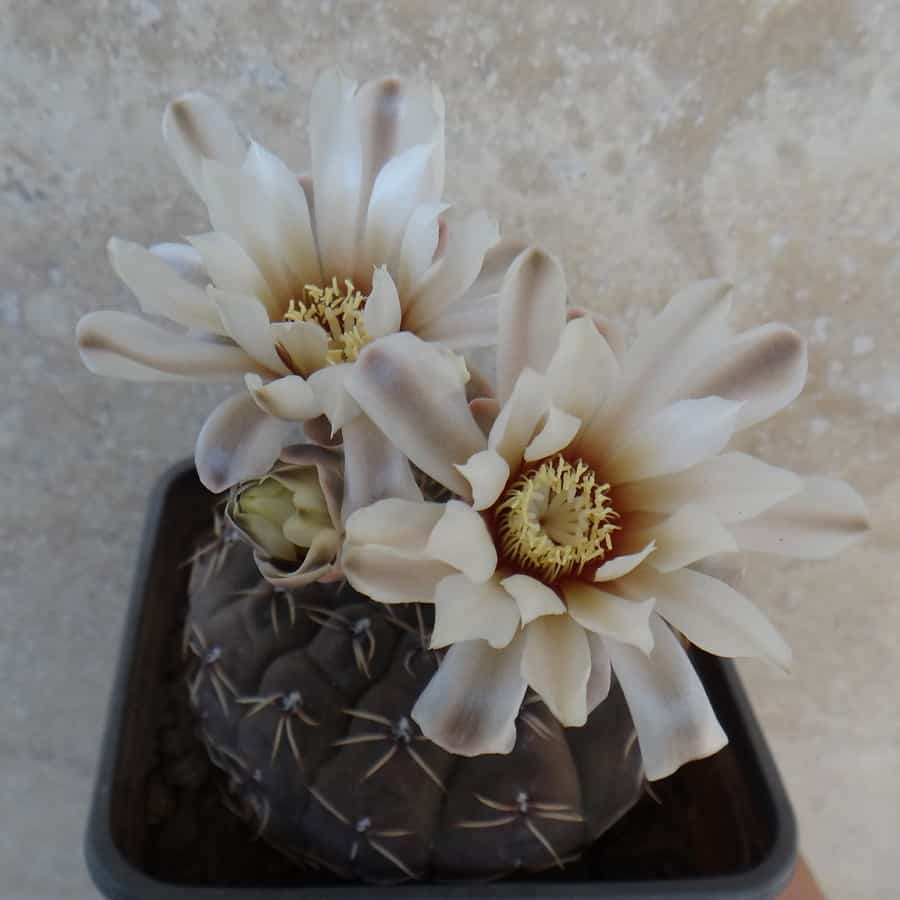
This cactus is compact and doesn’t grow very quickly. It has attractive spines and a stem that can be up to 7 cm wide. It usually grows alone and is one of the flattest types of Gymnocalycium, barely rising above the soil level. One interesting thing about this species is the color of its body, which can range from reddish to dark bluish-green.
Gymnocalycium ragonesei
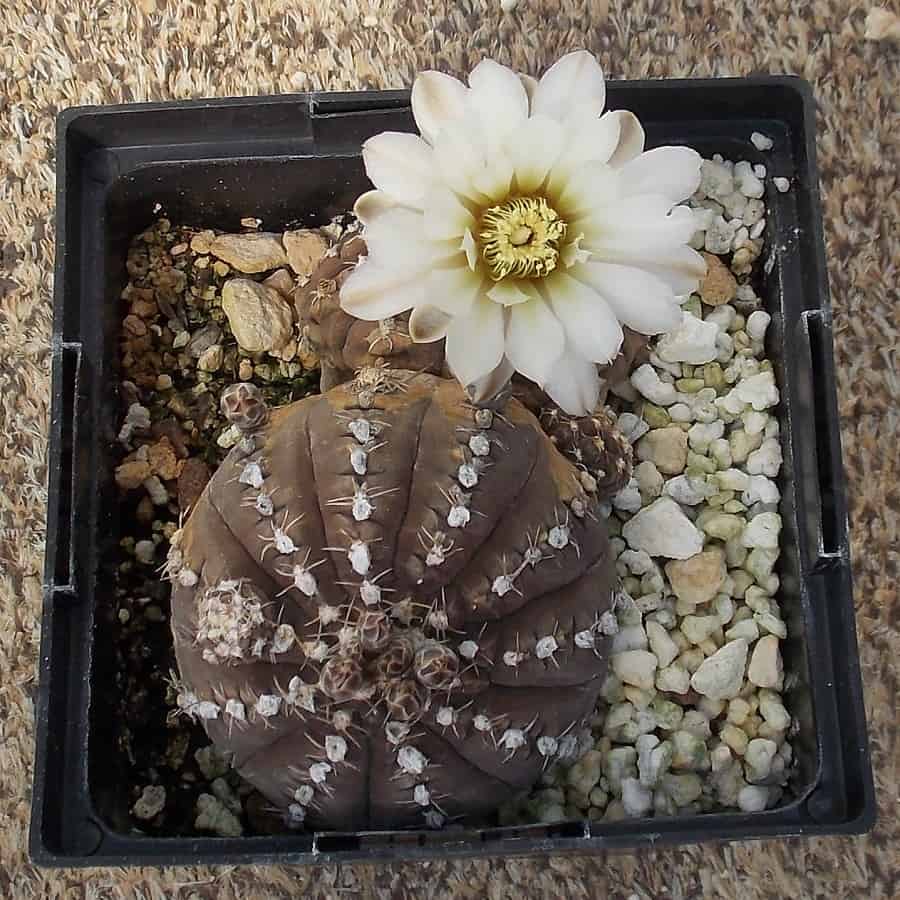
This cactus is very small and has a dark-colored skin that looks like a brown rock. It has white flowers that usually appear in clusters from June to September.
Gymnocalycium reductum
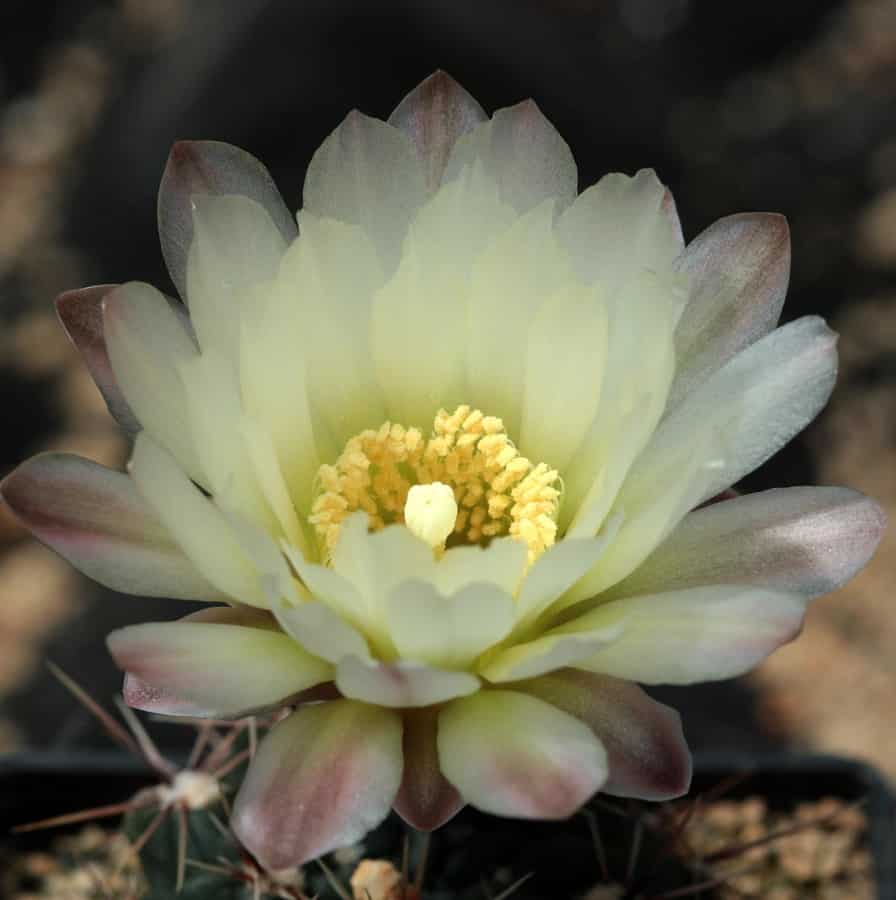
There are two varieties of this cactus, the regular one and var. leeanum.
Gymnocalycium reductum var leeanum
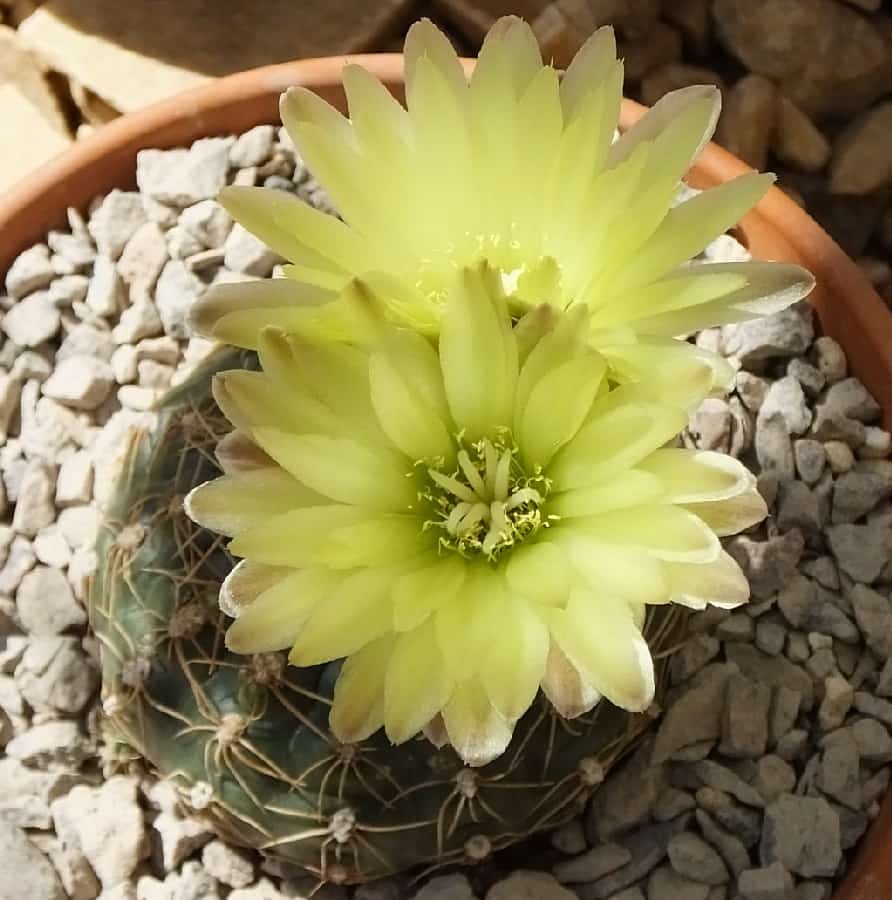
This small cactus usually grows in groups. It flowers easily and abundantly. The flowers are large, about 5-6 cm in diameter, and pale yellow. They last a long time, often surviving for ten days or more. This cactus is one of the first to bloom each year, with buds appearing in February and the first blooms opening in early March.
Gymnocalycium riojense
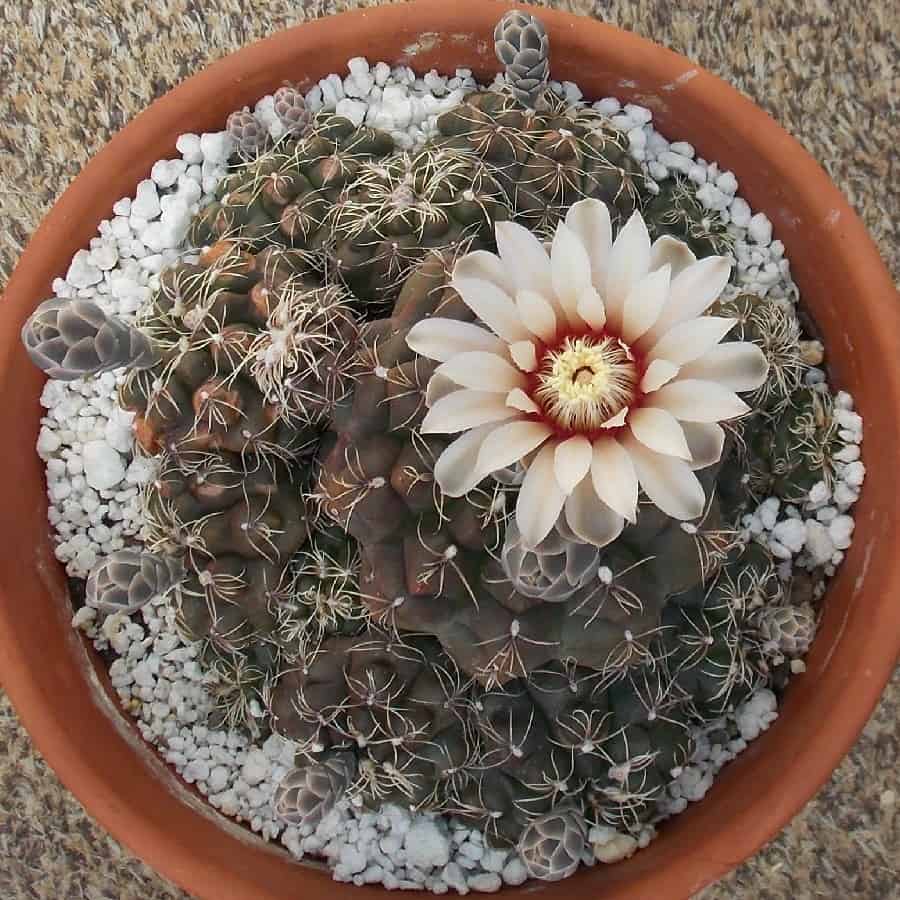
This cactus is low-growing and has a solitary brown body. It can grow up to about 10 cm in diameter but it takes a long time, maybe twenty years, to reach that size. However, younger plants, as small as 5 cm in diameter, can produce white-pink flowers from their crowns. This cactus has a lot of variation in appearance.
Gymnocalycium ritterianum
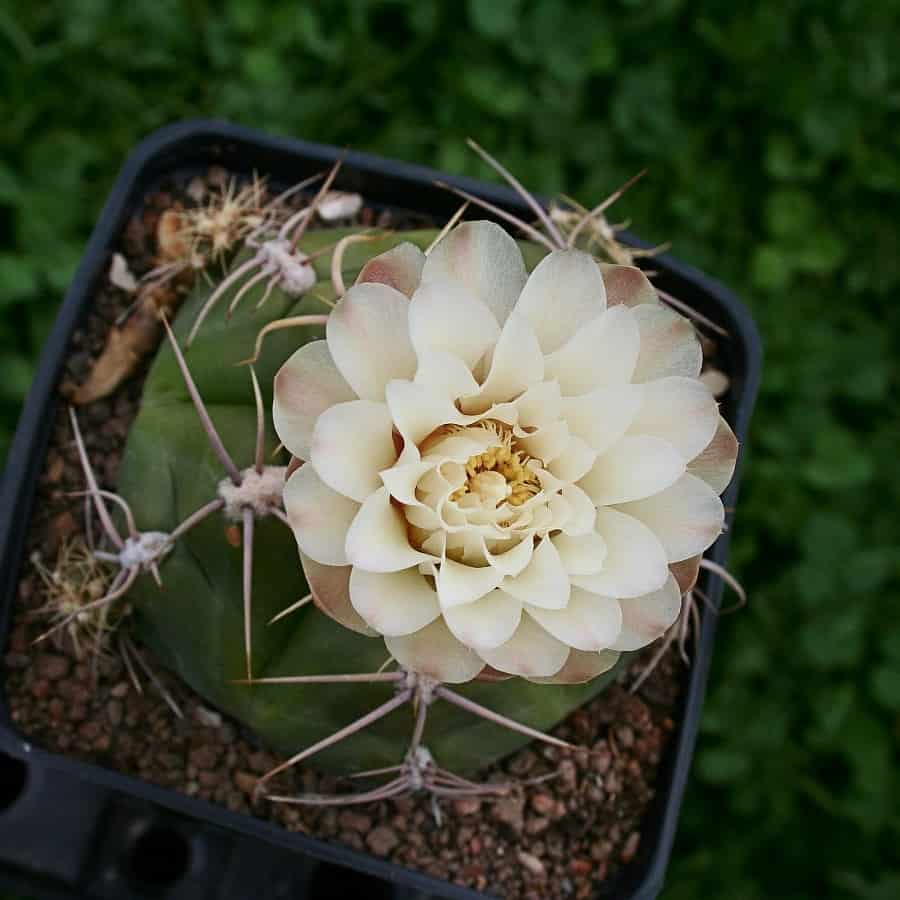
This cactus is a small but variable species. It can grow alone or sometimes in groups. It has beautiful disc-shaped stems and produces silky white flowers with rosy throats. The ritterianum cacti found in gardens or collections can look very different from one another.
Gymnocalycium robustum
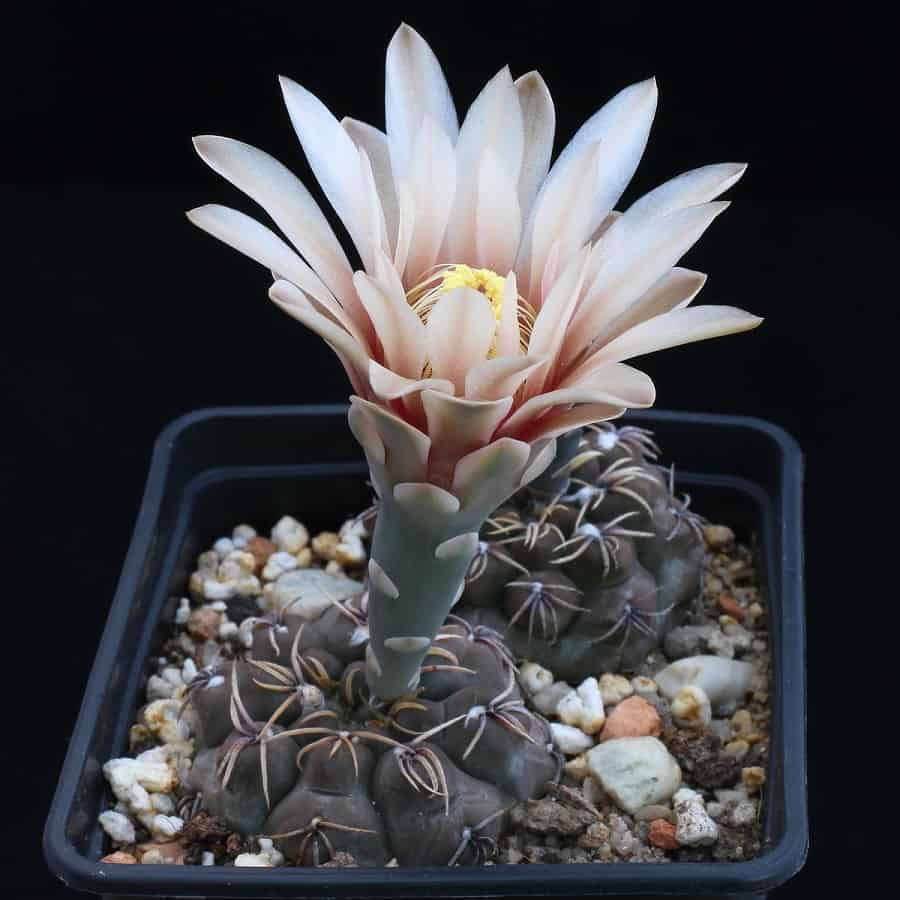
As the name suggests, this is a strong and sturdy cactus with thick ribs and round bumps. It doesn’t have many short spines and its fruits are also thick. It used to be called Gymnocalycium cordobensis.
Gymnocalycium saglionis
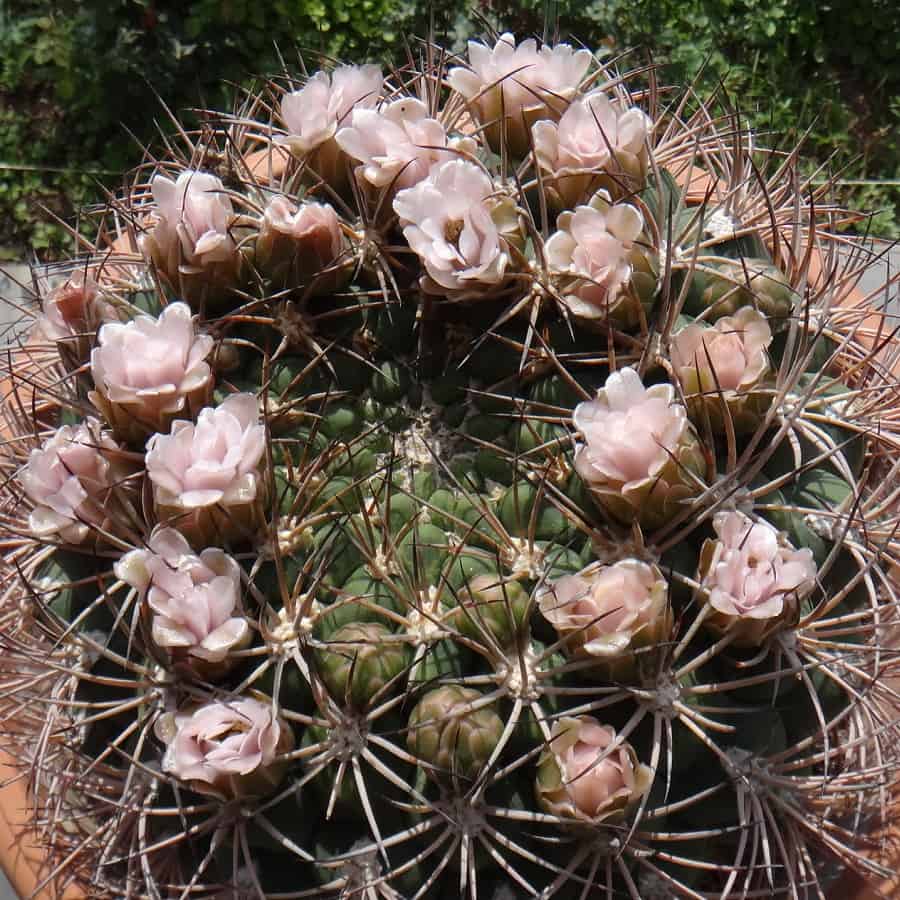
This cactus is shaped like a barrel and usually grows alone. It is quite flat and can get very big. It has long spines that spread out and sometimes curve. The spines are a rich brown color and provide a nice contrast to the gray-green body.
Gymnocalycium saglionis subsp tilcarense
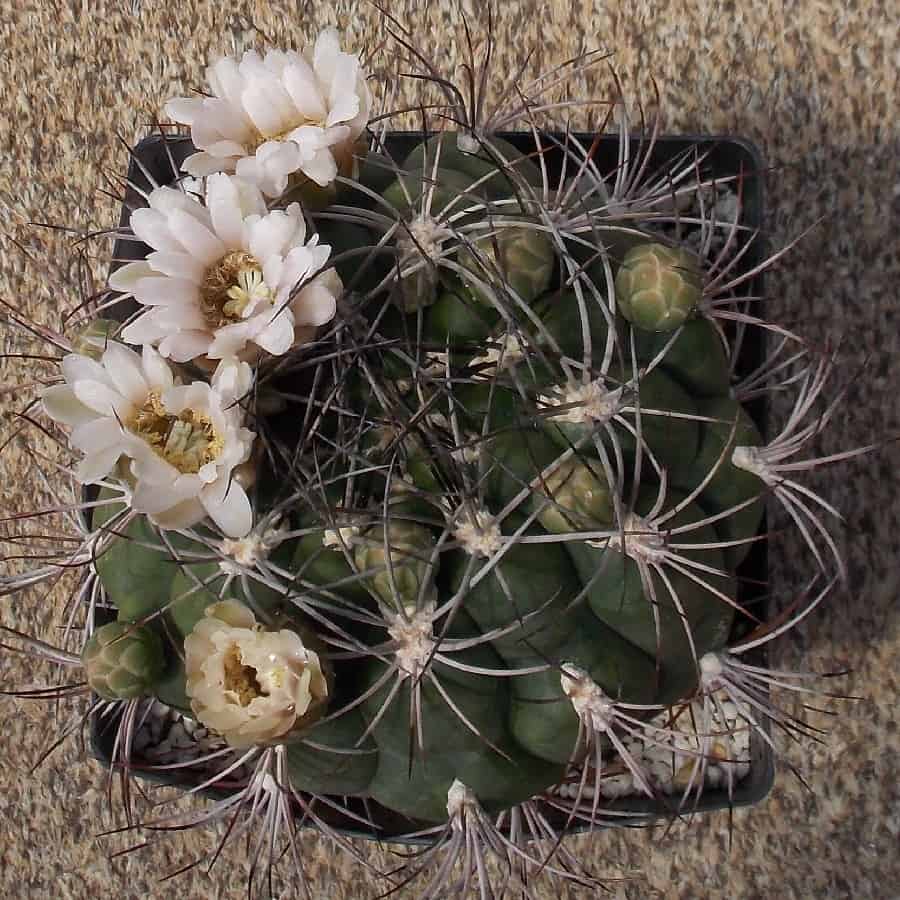
This subspecies of Gymnocalycium saglionis has flowers with shorter tubes and is only found in a certain area near Tilcara.
Gymnocalycium schickendantzii
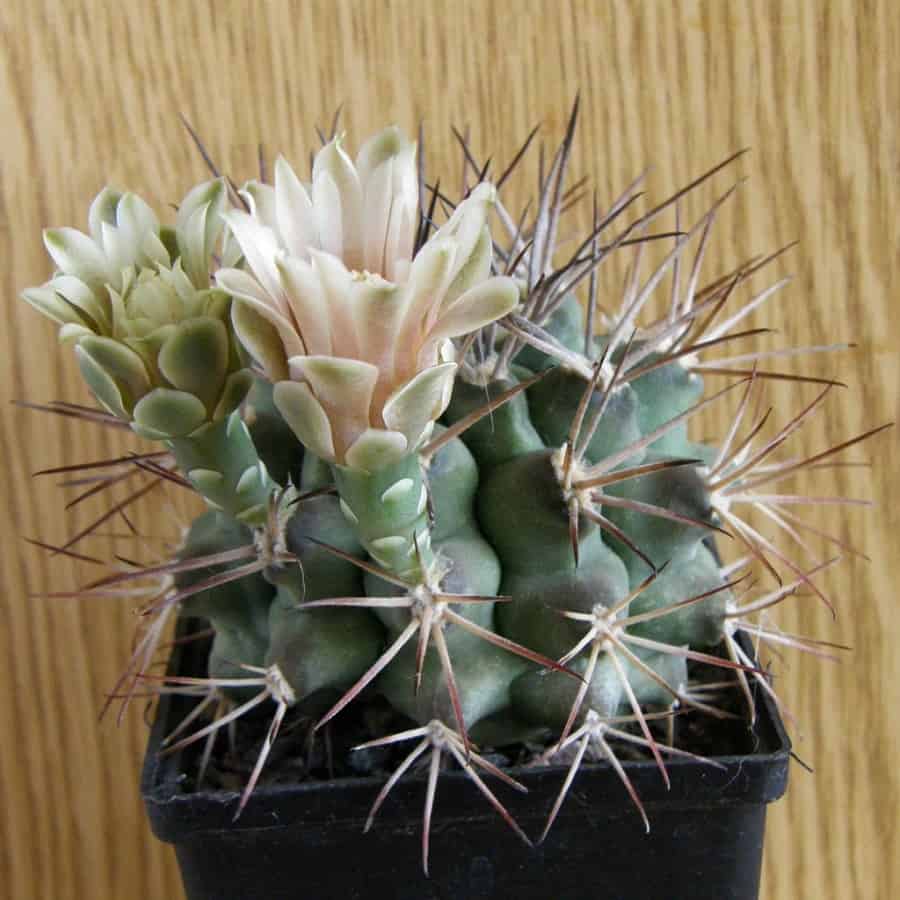
Gymnocalycium schickendantzii is a cactus that looks very nice, with a round, somewhat flat shape. It is similar to Gymnocalycium saglionis but has different types of spines. Some have long, beautiful spines that interlace with each other. There are two types of Gymnocalycium schickendantzii: the regular one and subsp. delaetii.
Gymnocalycium schickendantzii subsp delaetii
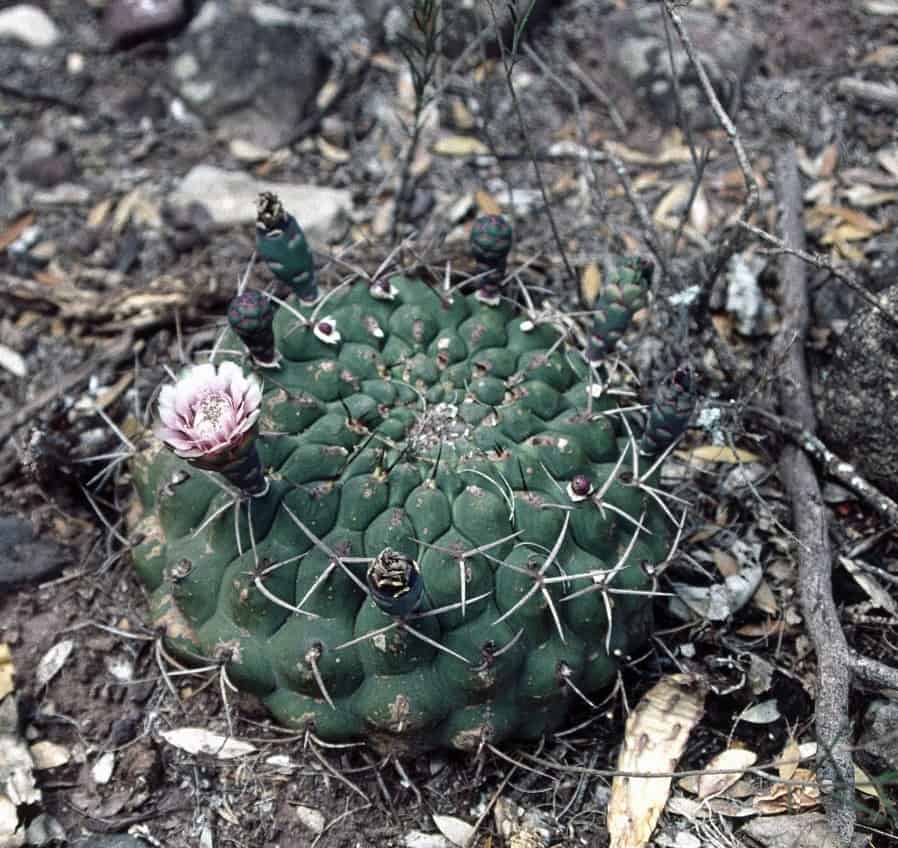
This type of cactus is a solitary barrel shape and closely related to Gymnocalycium schickendantzii. The tubercles on this cactus are more rounded and stick out even more. It also has longer reddish buds.
Gymnocalycium schroederianum
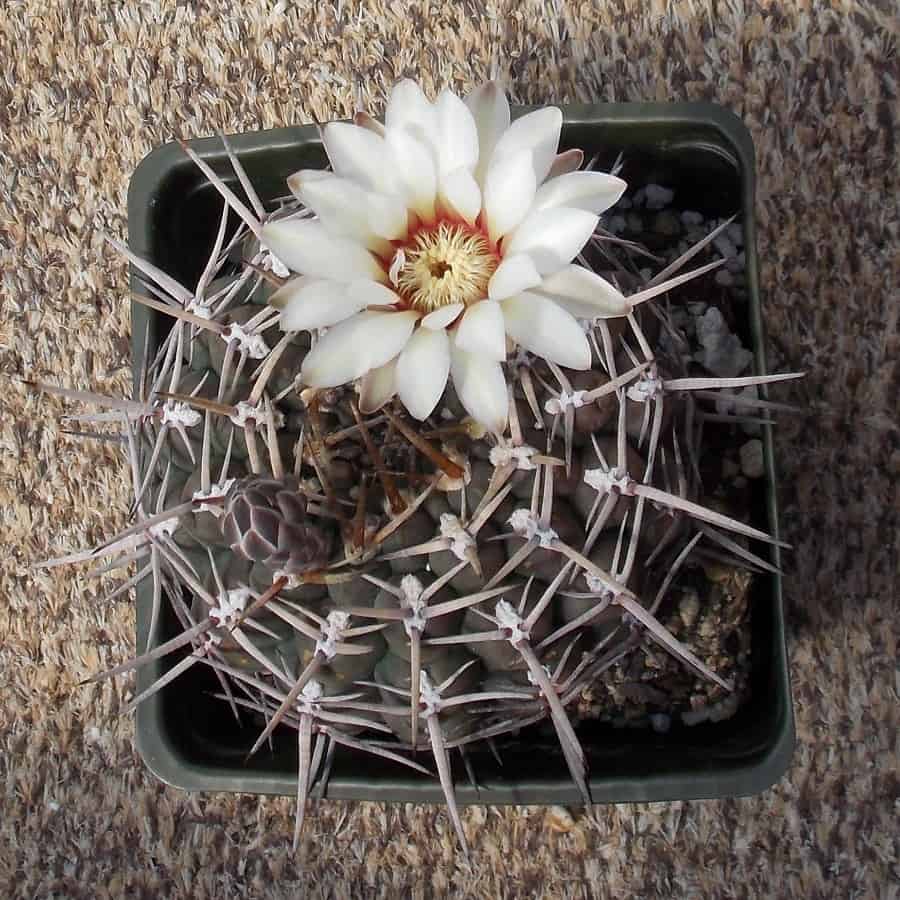
Gymnocalycium schroederianum is an attractive cactus that grows close to the ground. It usually grows alone but can sometimes branch out when grown in gardens. This species has flowers that are a pale yellowish-green color, which makes it different from most other Gymnocalycium cacti.
Gymnocalycium spegazzinii
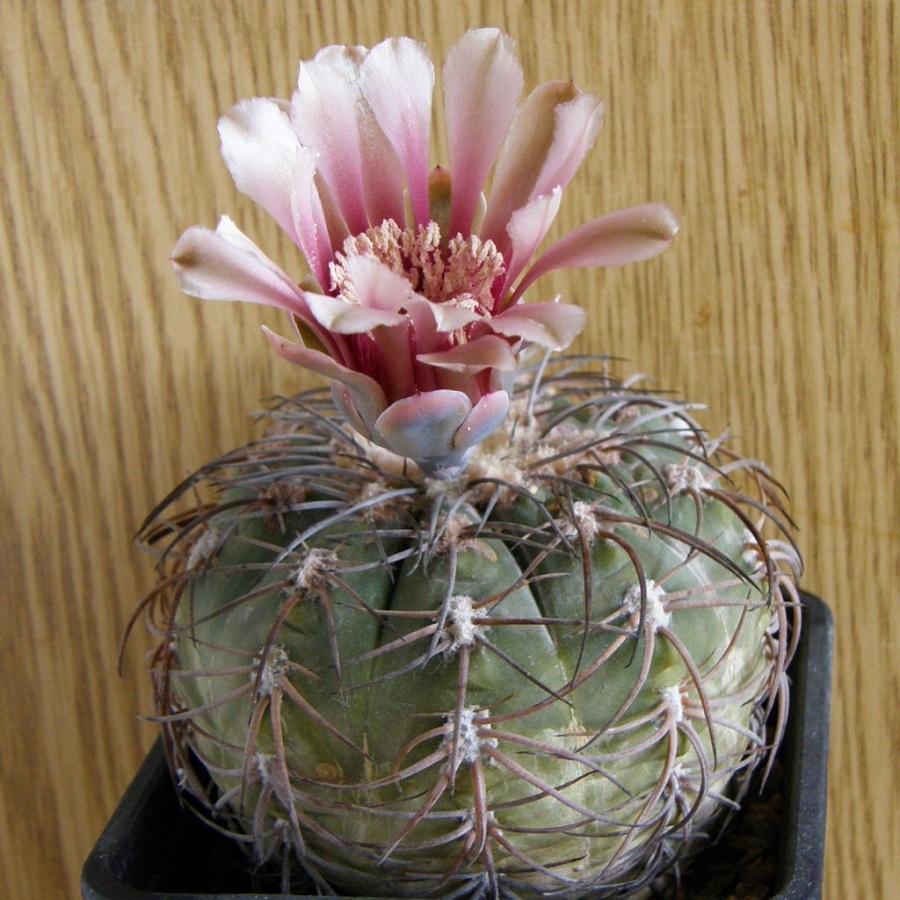
Gymnocalycium spegazzinii is a flat cactus that grows alone. Its spines point sideways or downward, giving it a unique look. There are two types of Gymnocalycium spegazzinii: the regular one and subsp. cardenasianum.
Gymnocalycium spegazzinii subsp cardenasianum
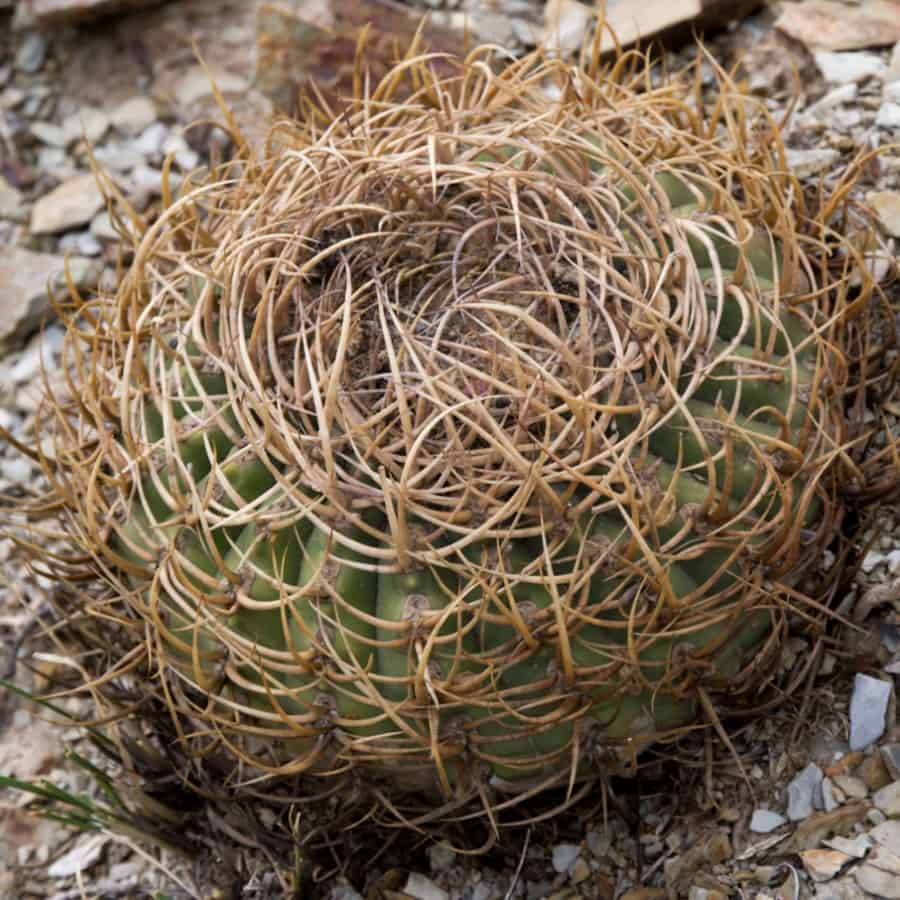
This solitary cactus grows slowly and has strong, twisted spines that point sideways and downward.
Gymnocalycium spegazzinii var punillense
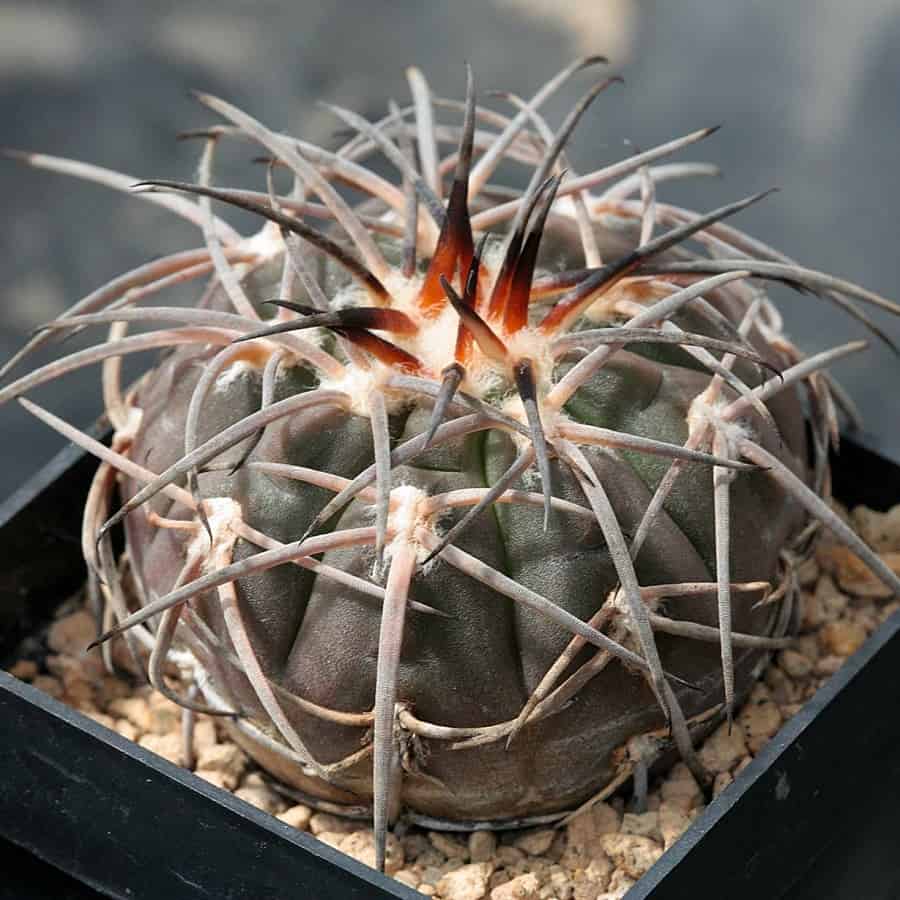
This beautiful cactus grows slowly and has a dark brown to almost black flattened body. It doesn’t produce offsets and its spines are usually curved and pressed against the body, which looks very nice.
Gymnocalycium spegazzinii subsp sarkae
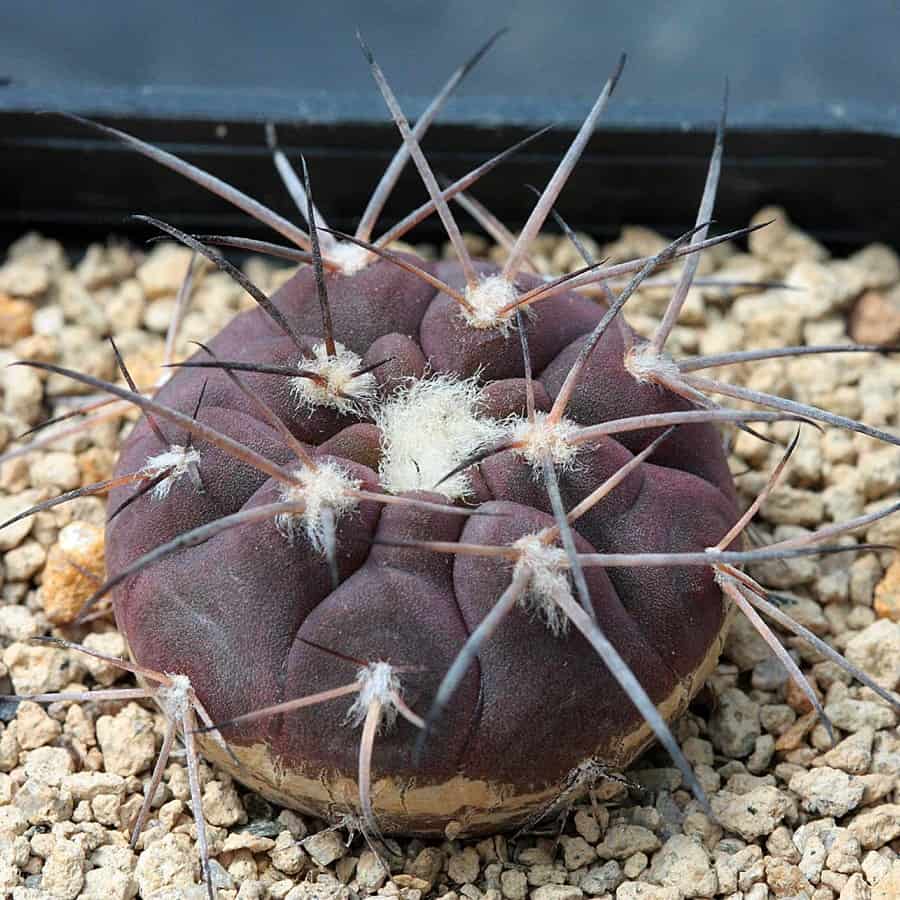
This variant of Gymnocalycium spegazzinii has different seeds, a darker purple-brown skin, and long spidery brown spines.
Gymnocalycium stellatum
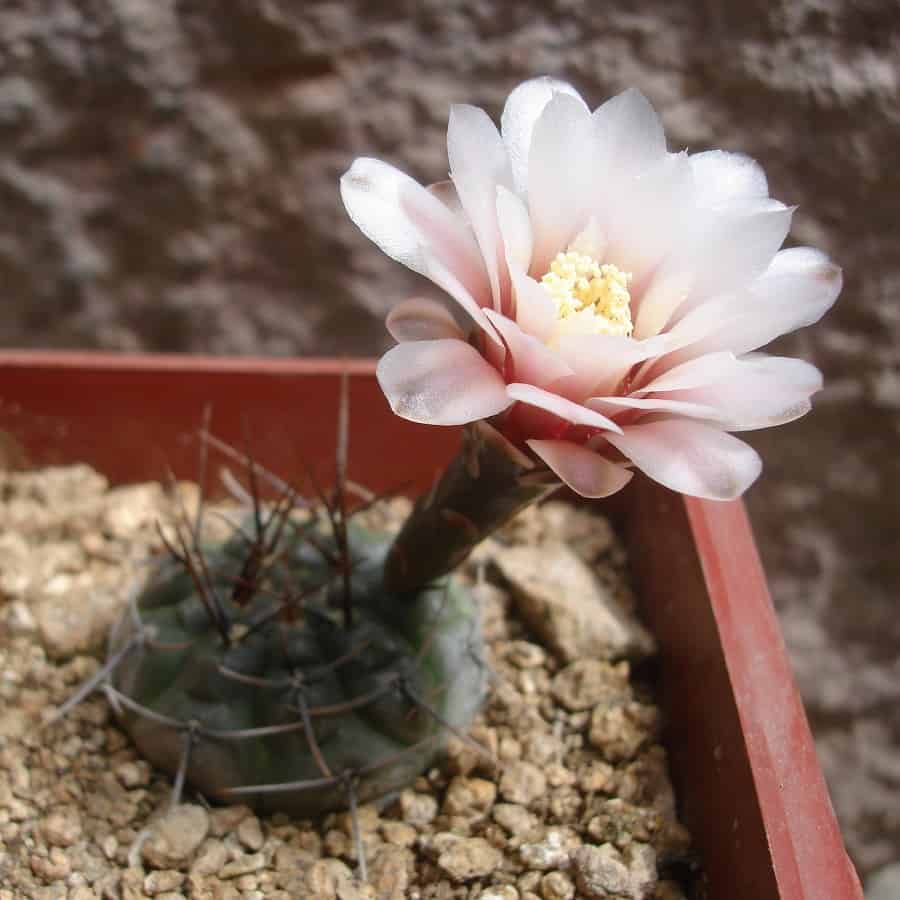
Gymnocalycium stellatum is a nice, slow-growing cactus with a flattened body. It starts as a single plant but later forms clusters. This species can vary in length and has many different names.
Gymnocalycium stellatum subsp occultum
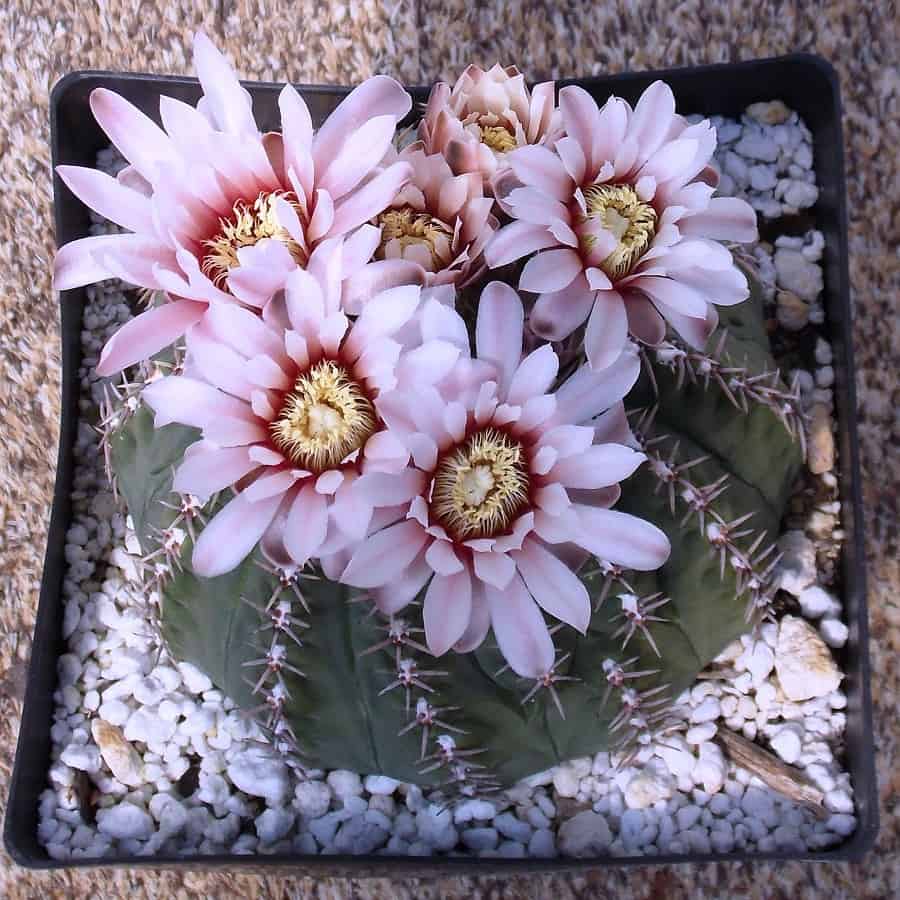
Gymnocalycium occultum is a beautiful, slow-growing cactus with a flattened body. It starts as a single plant but can form clusters over time. The stem has a dark grayish-brown to olive-colored skin. It produces offsets after a long period of time.
Gymnocalycium stellatum var paucispinum
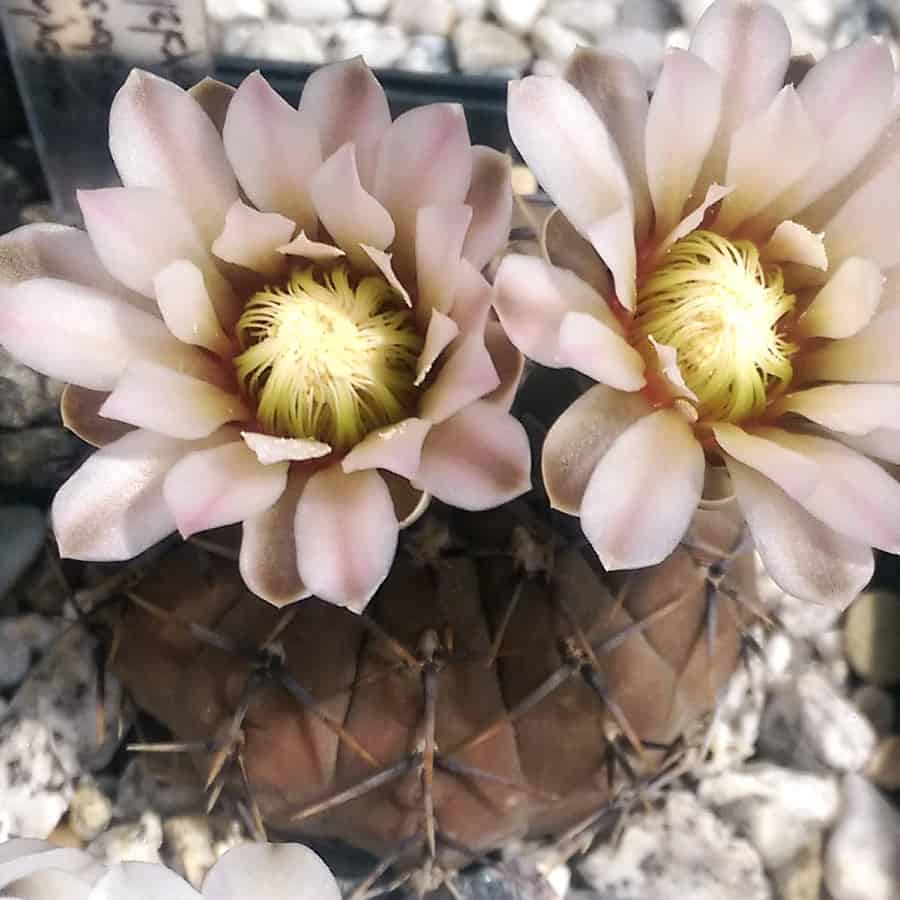
This small cactus is close to the ground and usually grows alone. Sometimes, it can form clusters when grown in gardens.
Gymnocalycium stenopleurum
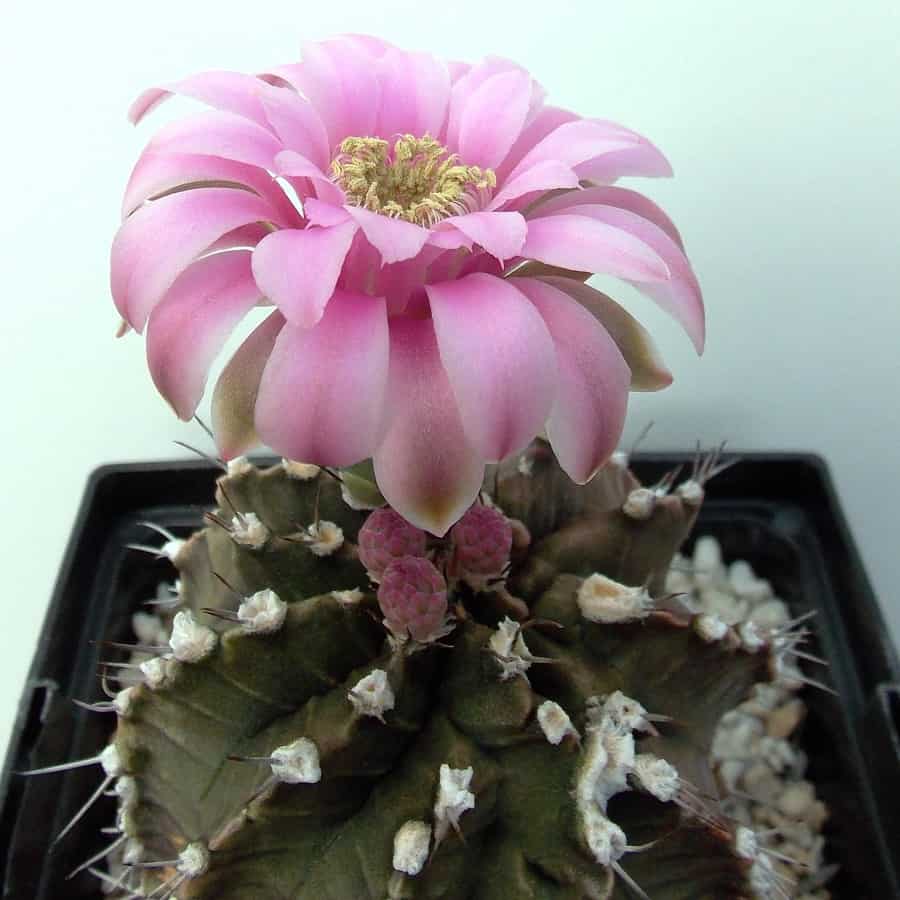
Gymnocalycium stenopleurum is a small cactus with a body that has bands of grey-green and brownish-red colors. It usually has fully opening white flowers.
Gymnocalycium sutterianum
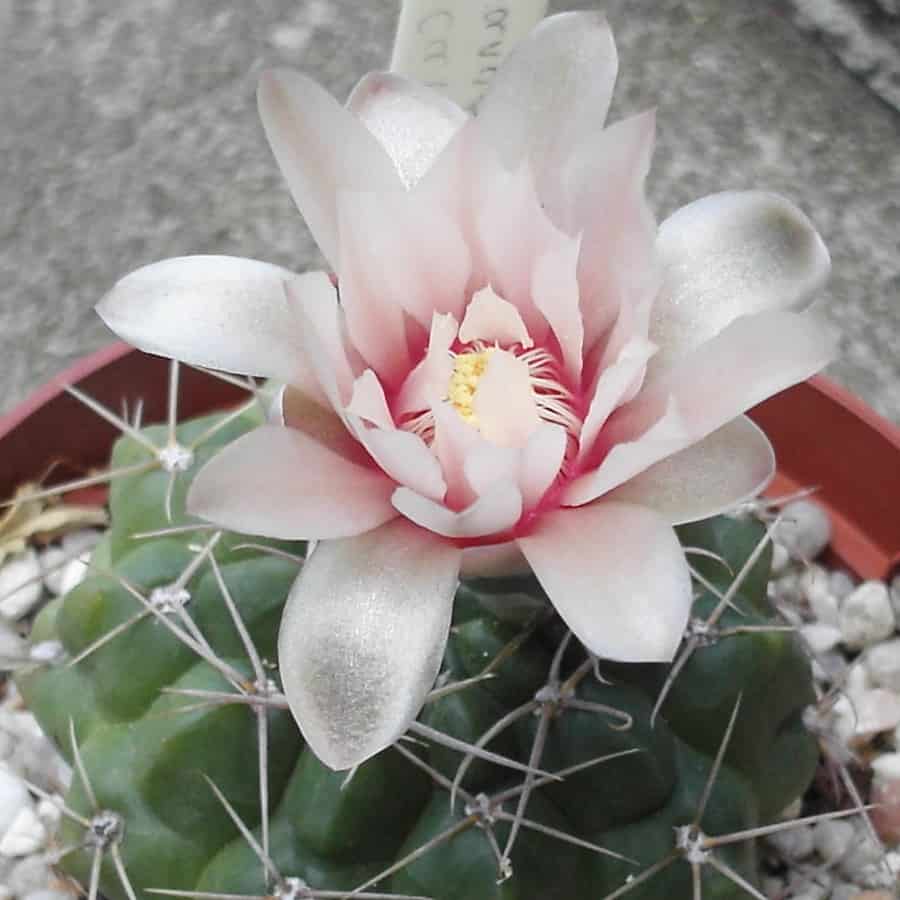
Gymnocalycium sutterianum has a very flat body and a strong root structure. It is closely related to Gymnocalycium sigelianum but has paler flowers and some differences in the number and color of spines.
Gymnocalycium striglianum
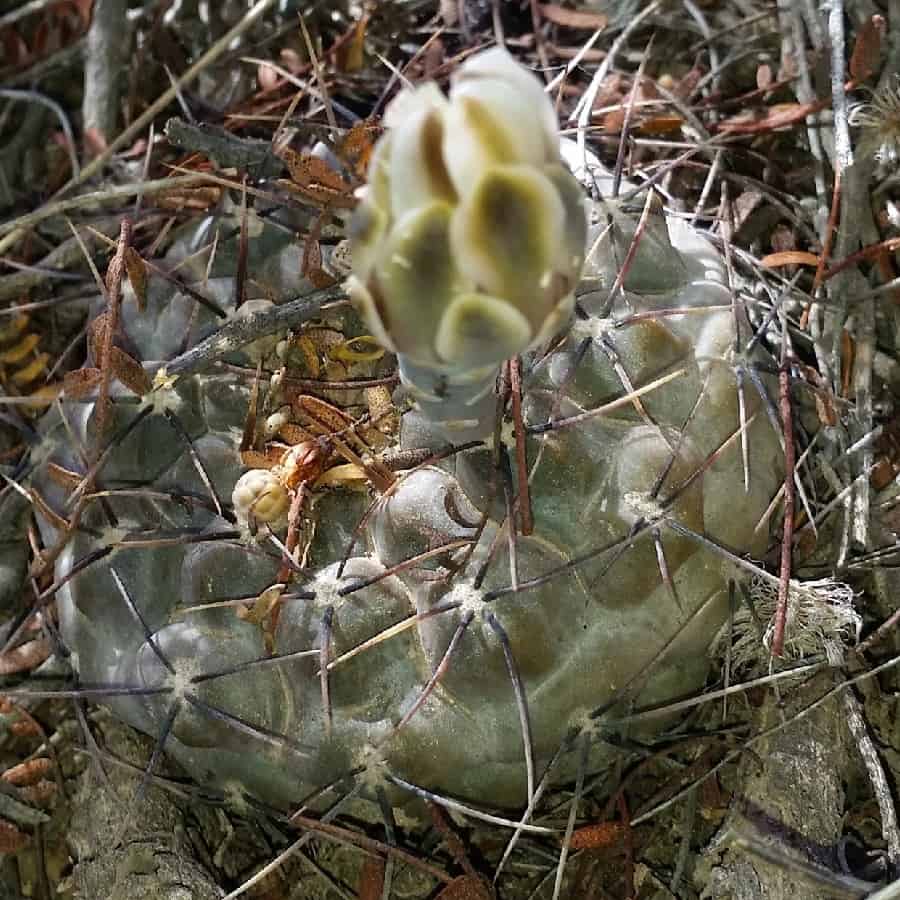
Gymnocalycium striglianum is a small cactus that is usually solitary. It is related to Gymnocalycium gibbosum but looks similar to Gymnocalycium stellatum.
Gymnocalycium taningaense
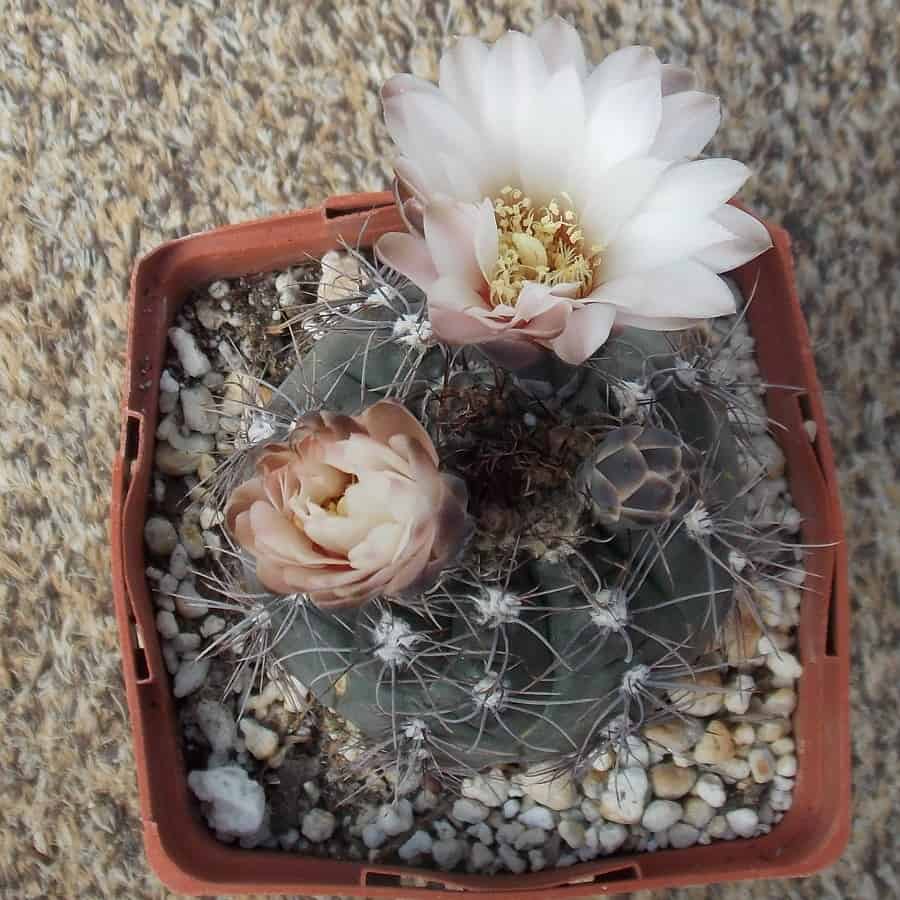
Gymnocalycium taningaense is a small cactus that is close to the ground. It usually grows alone but can form clusters when grown in gardens. It is different from Gymnocalycium calochlorum because of its yellow throat flowers, slender flower tubes, and bigger seeds.
Gymnocalycium tillianum
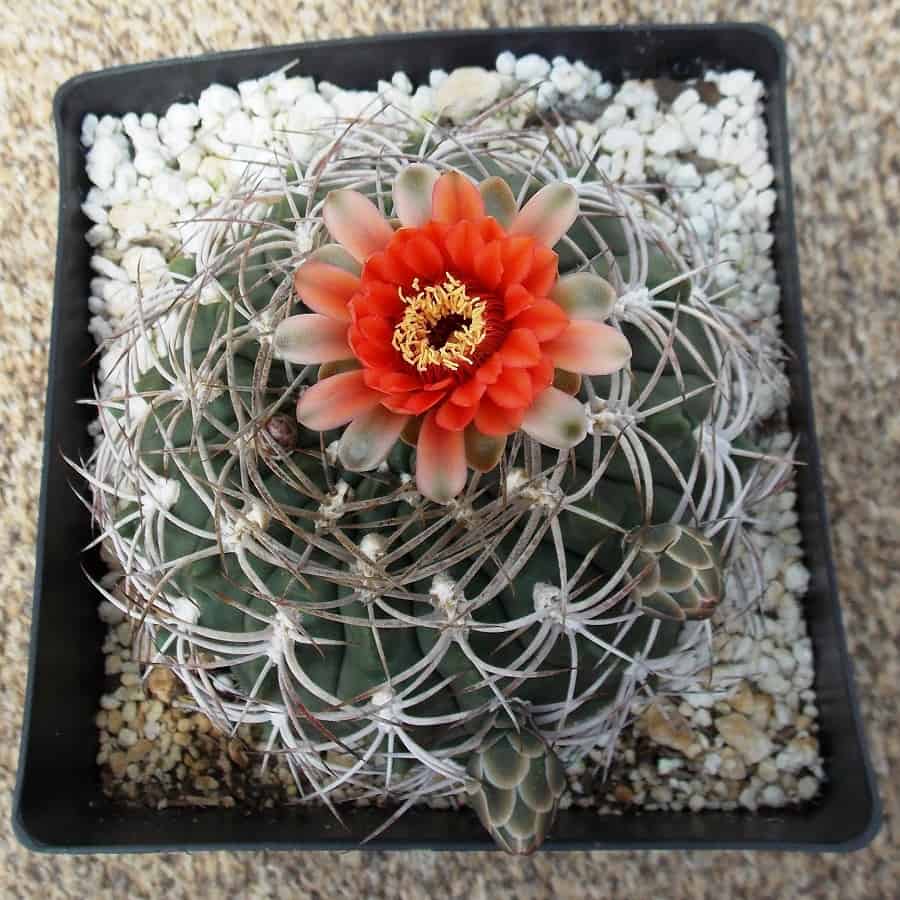
Gymnocalycium tillianum is a short and wide cactus from Argentina. It has shiny green stems that grow to be 4 inches tall and 6 inches wide. The cactus has long, curving spines that are black-brown in color. In the spring, it blooms large pale pink, carmine red, or wine-red flowers, which really stand out. Seeing the rich red color of the flowers makes you feel satisfied. In the summer, the cactus produces spherical fruit.
Gymnocalycium tillianum looks almost the same as the regular Gymnocalycium oenanthemum. It’s hard to tell them apart, except for where they come from and some small differences in the look of their seeds. Some people don’t consider them to be separate species.
Gymnocalycium triacanthum
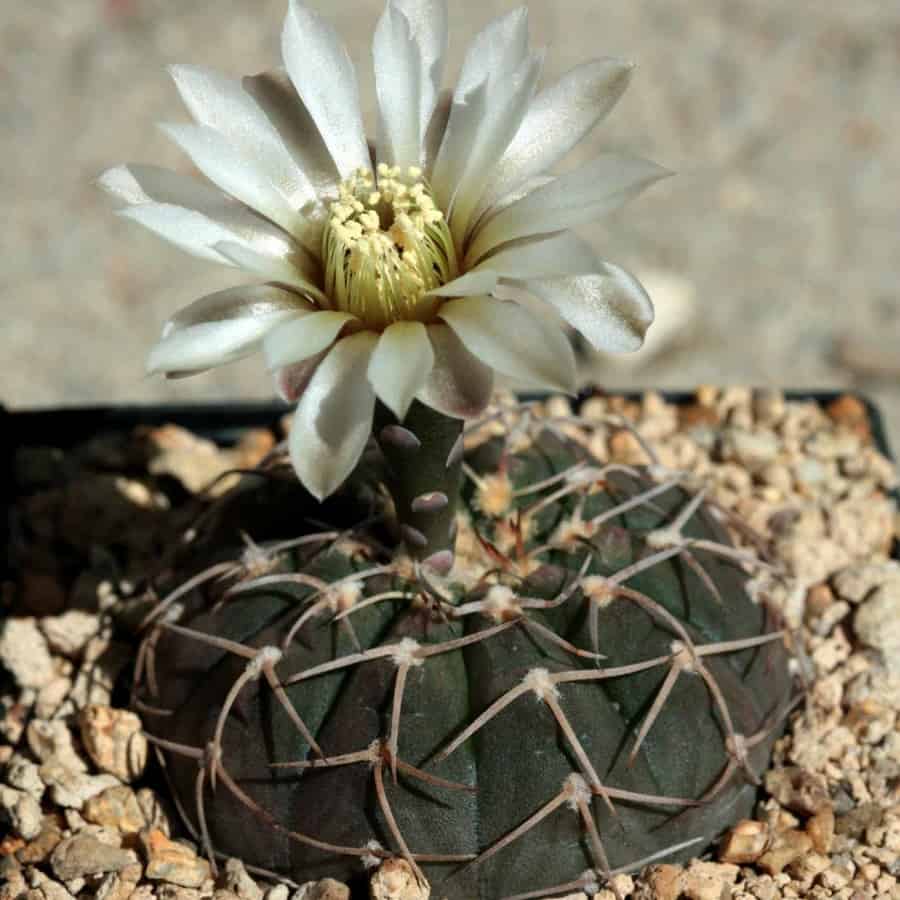
Gymnocalycium triacanthum is a small, flat cactus with grey bodies and short spines that grow in groups of three. It belongs to a group of cacti called the Gymnocalycium bodenbenderianum complex, which has different variations. It’s difficult to distinguish Gymnocalycium triacanthum from the three spun “bodenbenderianum” cacti, so many experts group them together.
Gymnocalycium weissianum
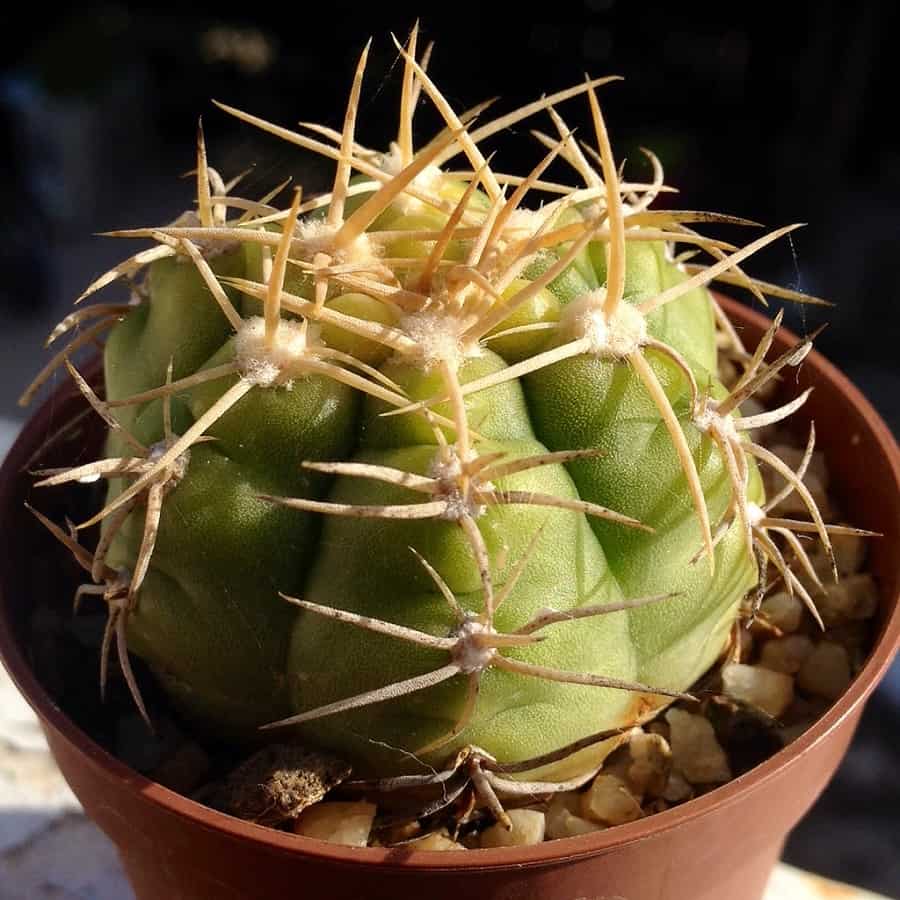
Gymnocalycium weissianum is one of the many forms of the Gymnocalycium hossei cactus, which has a lot of variations. It’s not clear whether these variations are all one species or several. They differ so much even within the same group of cacti that many experts group them together. Gymnocalycium weissianum has stout, white-gray spines that interlace each other.
How to Grow and Care for Gymnocalycium
People love growing Gymnocalycium as houseplants because they are small in size and bloom easily. The flowers are large and come in shades of red, pink, salmon, and white. The best part is that these Chin cacti are not known to be toxic, so there’s no need to worry if you have them around curious pets or children. Just be careful of the tiny white spines.
These cacti are hardy plants, but you should watch out for spider mites, mealybugs, and white fungus.
Light
Gymnocalycium cacti enjoy bright sunlight all year round, but direct sunlight can harm them. They prefer filtered or indirect sunlight. If you expose them to too much sunlight, the delicate cacti can get damaged and won’t bloom.
Watering
These cacti have shallow roots, and they are sensitive to water. They can tolerate drought quite well, so over-watering is a real concern. In the summer, water them only once a week or every two weeks.
If you live in a warm region, you might need to water them more frequently, but always make sure the roots are dry. Root rot is a significant problem for these plants. During winter, you can let them go without water for a longer period.
Soil
Just like other cacti, Gymnocalycium cacti need well-drained and gritty potting soil. You can find commercial mixes specifically made for cacti and succulents.
Fertilizing
These plants generally don’t require fertilizers unless they are growing too slowly. Any fertilizer made for cacti will work, but make sure to dilute it to half-strength before feeding the plant. Use it when the growth season begins.
Climate
Even though they are cacti, Gymnocalycium cacti thrive indoors with indirect light. They don’t tolerate frost well, so if the temperature drops below 50 degrees Fahrenheit, place them under a glass container or provide additional heat.
How to Propagate Gymnocalycium
The best way to propagate Chin cacti is by harvesting their seeds. Start cultivating them early in the spring, as they grow faster during warmer seasons. Ensure the container has fresh soil mix and place it in a sunny spot. Keep the soil moist by watering the seeds adequately.
You can also propagate them from small offsets. Take the offsets off the main plant and let them dry for a few days. Then, dip them in rooting hormone and plant them in soil.
FAQs
How Do You Get Gymnocalycium to Bloom?
These plants usually produce flowers that are about 1.5 inches in diameter. They are referred to as naked buds because they don’t have wool or spines. The flowers bloom well only in warm climates and when the plant is mature. Light and watering conditions must be optimal for the flowering to take place. If the plant is scorched, it won’t bloom.
How Long Do Gymnocalycium Flowers Last?
This depends on the species because some of them last for a day while others stay bloomed for about 6 weeks. The time period also depends on the watering conditions and the temperature of its surroundings.
How Do You Make Gymnocalycium Grow Faster?
With some species, it takes years to see any growth. If you want faster growth, you must keep them on a strict watering schedule without ignoring their soil conditions. Air exchange is an important factor too. And in winter, let them go dormant because that is their natural state of existence.
